Construction Management Plan for a Commercial and Residential Complex
VerifiedAdded on 2023/06/11
|51
|16370
|246
AI Summary
This construction management plan details the process of managing the construction of a commercial and residential complex in West Perth, including environmental management, resource management, and site management.
Contribute Materials
Your contribution can guide someone’s learning journey. Share your
documents today.
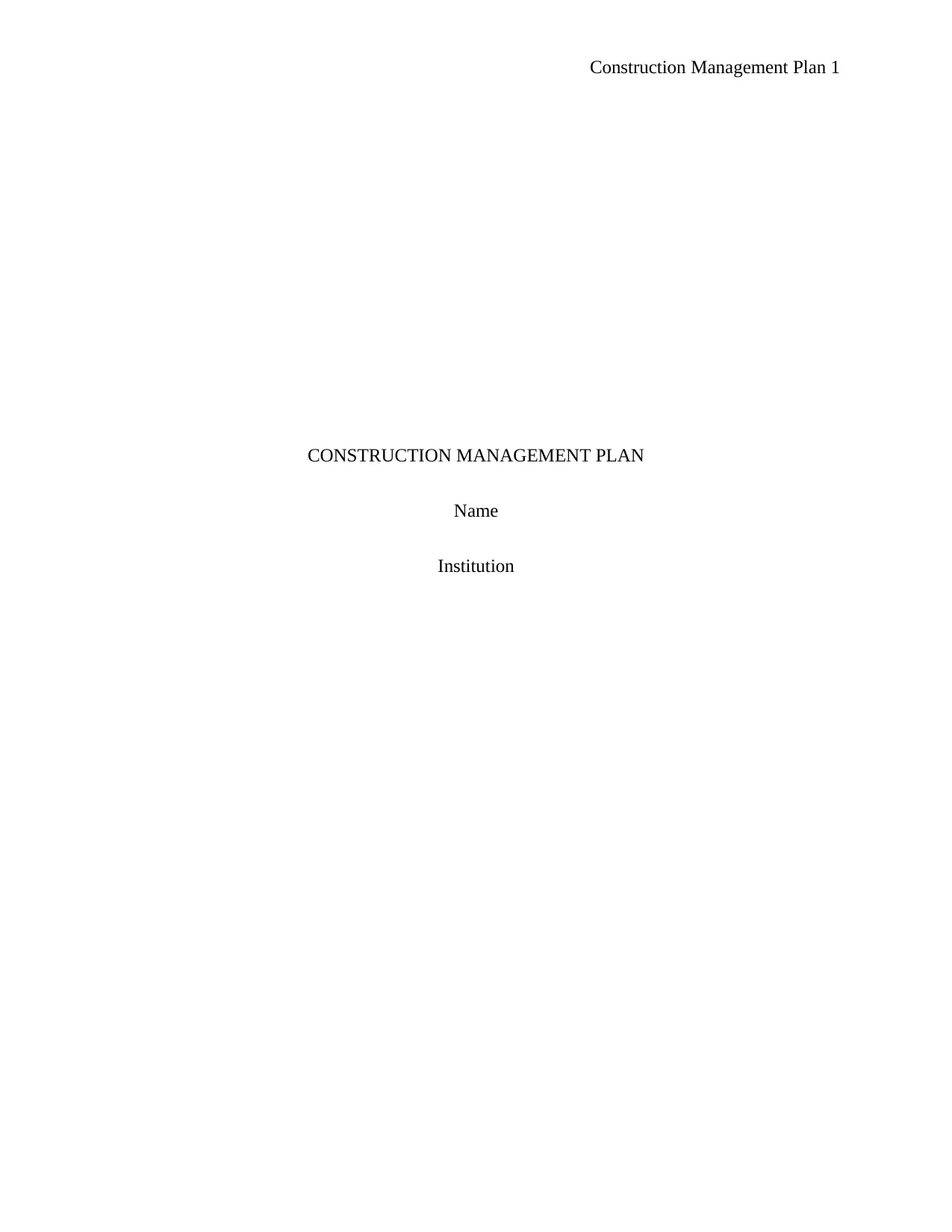
Construction Management Plan 1
CONSTRUCTION MANAGEMENT PLAN
Name
Institution
CONSTRUCTION MANAGEMENT PLAN
Name
Institution
Secure Best Marks with AI Grader
Need help grading? Try our AI Grader for instant feedback on your assignments.
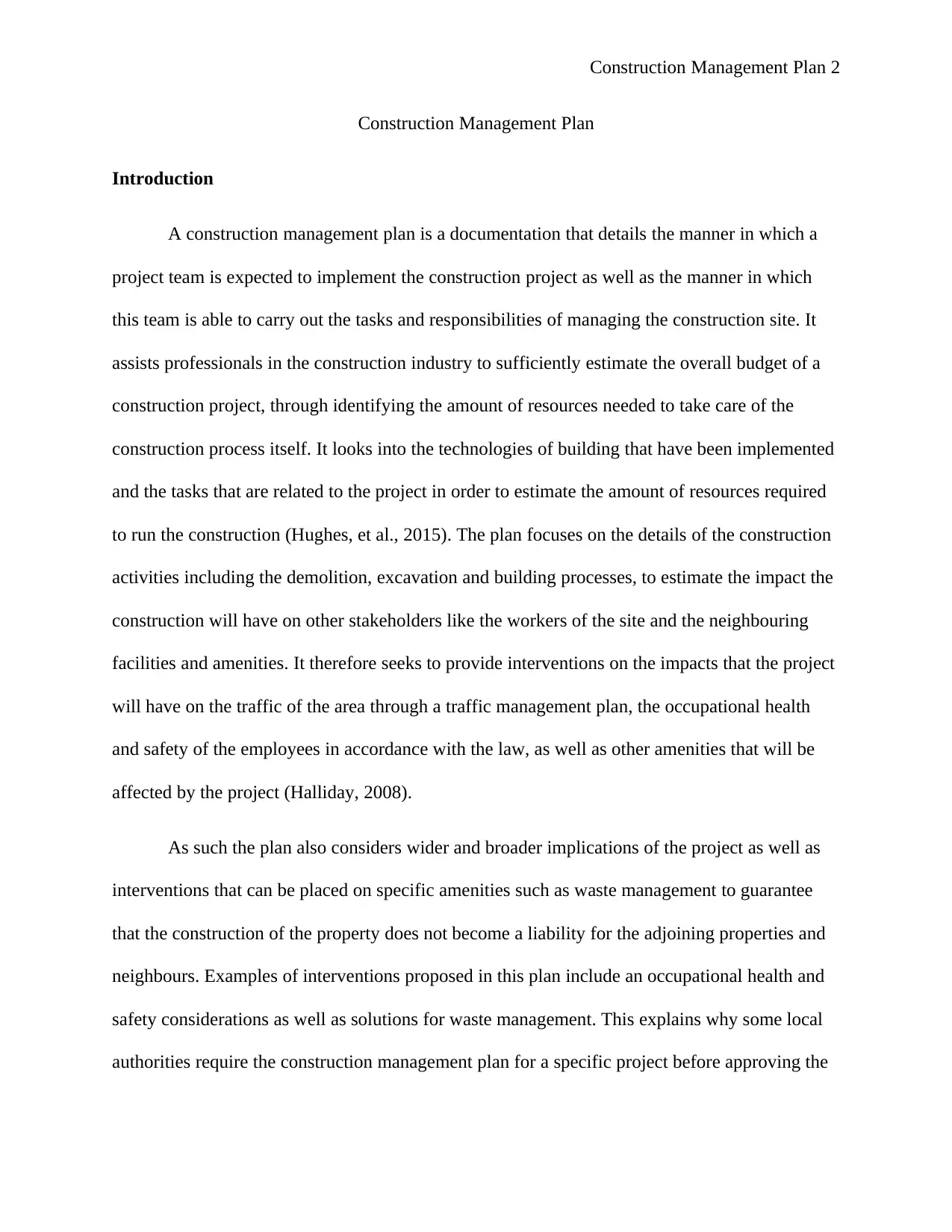
Construction Management Plan 2
Construction Management Plan
Introduction
A construction management plan is a documentation that details the manner in which a
project team is expected to implement the construction project as well as the manner in which
this team is able to carry out the tasks and responsibilities of managing the construction site. It
assists professionals in the construction industry to sufficiently estimate the overall budget of a
construction project, through identifying the amount of resources needed to take care of the
construction process itself. It looks into the technologies of building that have been implemented
and the tasks that are related to the project in order to estimate the amount of resources required
to run the construction (Hughes, et al., 2015). The plan focuses on the details of the construction
activities including the demolition, excavation and building processes, to estimate the impact the
construction will have on other stakeholders like the workers of the site and the neighbouring
facilities and amenities. It therefore seeks to provide interventions on the impacts that the project
will have on the traffic of the area through a traffic management plan, the occupational health
and safety of the employees in accordance with the law, as well as other amenities that will be
affected by the project (Halliday, 2008).
As such the plan also considers wider and broader implications of the project as well as
interventions that can be placed on specific amenities such as waste management to guarantee
that the construction of the property does not become a liability for the adjoining properties and
neighbours. Examples of interventions proposed in this plan include an occupational health and
safety considerations as well as solutions for waste management. This explains why some local
authorities require the construction management plan for a specific project before approving the
Construction Management Plan
Introduction
A construction management plan is a documentation that details the manner in which a
project team is expected to implement the construction project as well as the manner in which
this team is able to carry out the tasks and responsibilities of managing the construction site. It
assists professionals in the construction industry to sufficiently estimate the overall budget of a
construction project, through identifying the amount of resources needed to take care of the
construction process itself. It looks into the technologies of building that have been implemented
and the tasks that are related to the project in order to estimate the amount of resources required
to run the construction (Hughes, et al., 2015). The plan focuses on the details of the construction
activities including the demolition, excavation and building processes, to estimate the impact the
construction will have on other stakeholders like the workers of the site and the neighbouring
facilities and amenities. It therefore seeks to provide interventions on the impacts that the project
will have on the traffic of the area through a traffic management plan, the occupational health
and safety of the employees in accordance with the law, as well as other amenities that will be
affected by the project (Halliday, 2008).
As such the plan also considers wider and broader implications of the project as well as
interventions that can be placed on specific amenities such as waste management to guarantee
that the construction of the property does not become a liability for the adjoining properties and
neighbours. Examples of interventions proposed in this plan include an occupational health and
safety considerations as well as solutions for waste management. This explains why some local
authorities require the construction management plan for a specific project before approving the
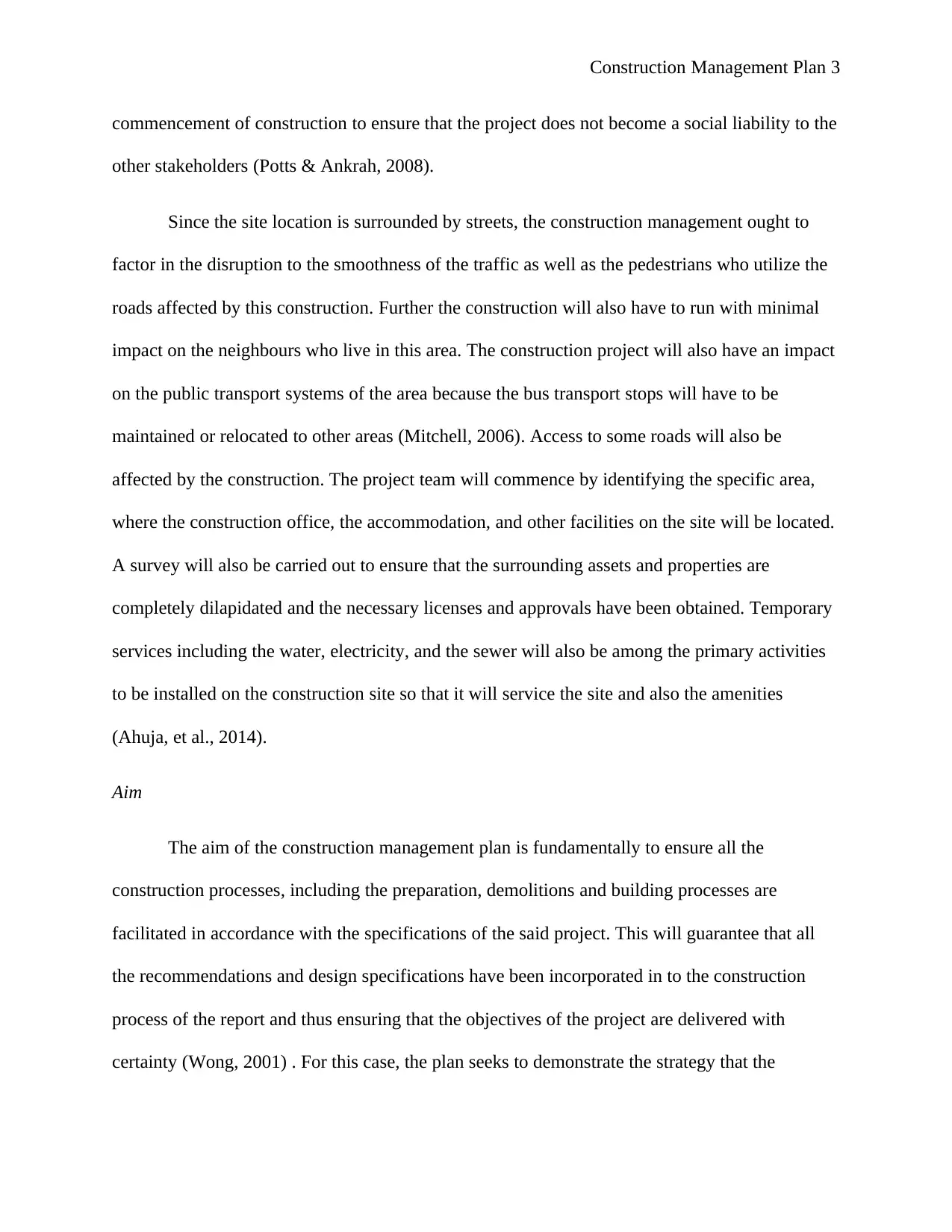
Construction Management Plan 3
commencement of construction to ensure that the project does not become a social liability to the
other stakeholders (Potts & Ankrah, 2008).
Since the site location is surrounded by streets, the construction management ought to
factor in the disruption to the smoothness of the traffic as well as the pedestrians who utilize the
roads affected by this construction. Further the construction will also have to run with minimal
impact on the neighbours who live in this area. The construction project will also have an impact
on the public transport systems of the area because the bus transport stops will have to be
maintained or relocated to other areas (Mitchell, 2006). Access to some roads will also be
affected by the construction. The project team will commence by identifying the specific area,
where the construction office, the accommodation, and other facilities on the site will be located.
A survey will also be carried out to ensure that the surrounding assets and properties are
completely dilapidated and the necessary licenses and approvals have been obtained. Temporary
services including the water, electricity, and the sewer will also be among the primary activities
to be installed on the construction site so that it will service the site and also the amenities
(Ahuja, et al., 2014).
Aim
The aim of the construction management plan is fundamentally to ensure all the
construction processes, including the preparation, demolitions and building processes are
facilitated in accordance with the specifications of the said project. This will guarantee that all
the recommendations and design specifications have been incorporated in to the construction
process of the report and thus ensuring that the objectives of the project are delivered with
certainty (Wong, 2001) . For this case, the plan seeks to demonstrate the strategy that the
commencement of construction to ensure that the project does not become a social liability to the
other stakeholders (Potts & Ankrah, 2008).
Since the site location is surrounded by streets, the construction management ought to
factor in the disruption to the smoothness of the traffic as well as the pedestrians who utilize the
roads affected by this construction. Further the construction will also have to run with minimal
impact on the neighbours who live in this area. The construction project will also have an impact
on the public transport systems of the area because the bus transport stops will have to be
maintained or relocated to other areas (Mitchell, 2006). Access to some roads will also be
affected by the construction. The project team will commence by identifying the specific area,
where the construction office, the accommodation, and other facilities on the site will be located.
A survey will also be carried out to ensure that the surrounding assets and properties are
completely dilapidated and the necessary licenses and approvals have been obtained. Temporary
services including the water, electricity, and the sewer will also be among the primary activities
to be installed on the construction site so that it will service the site and also the amenities
(Ahuja, et al., 2014).
Aim
The aim of the construction management plan is fundamentally to ensure all the
construction processes, including the preparation, demolitions and building processes are
facilitated in accordance with the specifications of the said project. This will guarantee that all
the recommendations and design specifications have been incorporated in to the construction
process of the report and thus ensuring that the objectives of the project are delivered with
certainty (Wong, 2001) . For this case, the plan seeks to demonstrate the strategy that the
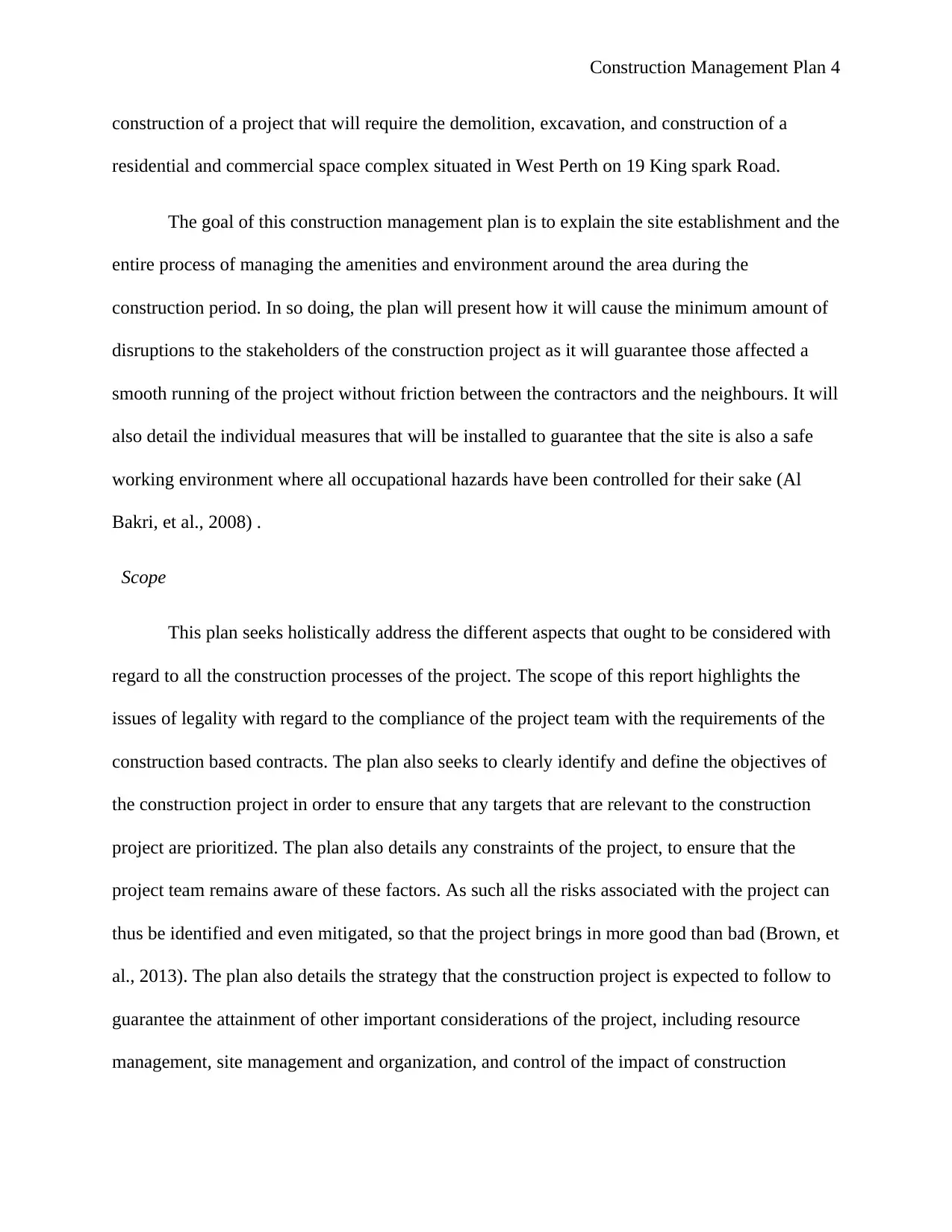
Construction Management Plan 4
construction of a project that will require the demolition, excavation, and construction of a
residential and commercial space complex situated in West Perth on 19 King spark Road.
The goal of this construction management plan is to explain the site establishment and the
entire process of managing the amenities and environment around the area during the
construction period. In so doing, the plan will present how it will cause the minimum amount of
disruptions to the stakeholders of the construction project as it will guarantee those affected a
smooth running of the project without friction between the contractors and the neighbours. It will
also detail the individual measures that will be installed to guarantee that the site is also a safe
working environment where all occupational hazards have been controlled for their sake (Al
Bakri, et al., 2008) .
Scope
This plan seeks holistically address the different aspects that ought to be considered with
regard to all the construction processes of the project. The scope of this report highlights the
issues of legality with regard to the compliance of the project team with the requirements of the
construction based contracts. The plan also seeks to clearly identify and define the objectives of
the construction project in order to ensure that any targets that are relevant to the construction
project are prioritized. The plan also details any constraints of the project, to ensure that the
project team remains aware of these factors. As such all the risks associated with the project can
thus be identified and even mitigated, so that the project brings in more good than bad (Brown, et
al., 2013). The plan also details the strategy that the construction project is expected to follow to
guarantee the attainment of other important considerations of the project, including resource
management, site management and organization, and control of the impact of construction
construction of a project that will require the demolition, excavation, and construction of a
residential and commercial space complex situated in West Perth on 19 King spark Road.
The goal of this construction management plan is to explain the site establishment and the
entire process of managing the amenities and environment around the area during the
construction period. In so doing, the plan will present how it will cause the minimum amount of
disruptions to the stakeholders of the construction project as it will guarantee those affected a
smooth running of the project without friction between the contractors and the neighbours. It will
also detail the individual measures that will be installed to guarantee that the site is also a safe
working environment where all occupational hazards have been controlled for their sake (Al
Bakri, et al., 2008) .
Scope
This plan seeks holistically address the different aspects that ought to be considered with
regard to all the construction processes of the project. The scope of this report highlights the
issues of legality with regard to the compliance of the project team with the requirements of the
construction based contracts. The plan also seeks to clearly identify and define the objectives of
the construction project in order to ensure that any targets that are relevant to the construction
project are prioritized. The plan also details any constraints of the project, to ensure that the
project team remains aware of these factors. As such all the risks associated with the project can
thus be identified and even mitigated, so that the project brings in more good than bad (Brown, et
al., 2013). The plan also details the strategy that the construction project is expected to follow to
guarantee the attainment of other important considerations of the project, including resource
management, site management and organization, and control of the impact of construction
Secure Best Marks with AI Grader
Need help grading? Try our AI Grader for instant feedback on your assignments.

Construction Management Plan 5
activities to other stakeholders (Odeh & Battaineh, 2002) . It also details the management plans
of noise, dust, the environment, traffic, stormwater and waste management.
Project Description
The proposed construction project is a commercial and residential complex that is to be
situated in West Perth, 19 Kingspark Road, composed of 7 basement floors, 4 parking levels, 2
podiums, and 3 towers that will consist of about 27 floors each for use as commercial space,
residential areas, and a 3-star hotel. As such the project will be carried out in distinct phases that
will involve different strategies and procedures of material handling (Semblat & Pecker, 2009).
This will ensure that that the construction activities will run in an optimized manner such that
any impact felt by other stakeholders including the streets, the waste management system, the
environment, the urban stormwater system, as well as the neighbourhood. All the strategies
utilized in this project regarding material handling and construction plan were arrived at after
consulting with the different authorities and the stakeholders (Barrie & Paulson, 2004).
The land where this construction project is to be erected is an existing property that is
terraced and currently stands as a theatre garden. While the land’s availability is guaranteed,
there are a number of environmental constraints that will have to be removed for the construction
process to be commenced. Some of the constraints include the presence of trees and grass on the
premises, which attract different kinds of animals. The land has also recently been taken through
a geotechnical analysis to measure the stability of the soil and its suitability for the size of the
project (Arditi, et al., 2007). The geotechnical analysis will look into the shear strength and
yielding points of the soil to ensure that the soil is able to withstand the weight of such an
immense structure.
activities to other stakeholders (Odeh & Battaineh, 2002) . It also details the management plans
of noise, dust, the environment, traffic, stormwater and waste management.
Project Description
The proposed construction project is a commercial and residential complex that is to be
situated in West Perth, 19 Kingspark Road, composed of 7 basement floors, 4 parking levels, 2
podiums, and 3 towers that will consist of about 27 floors each for use as commercial space,
residential areas, and a 3-star hotel. As such the project will be carried out in distinct phases that
will involve different strategies and procedures of material handling (Semblat & Pecker, 2009).
This will ensure that that the construction activities will run in an optimized manner such that
any impact felt by other stakeholders including the streets, the waste management system, the
environment, the urban stormwater system, as well as the neighbourhood. All the strategies
utilized in this project regarding material handling and construction plan were arrived at after
consulting with the different authorities and the stakeholders (Barrie & Paulson, 2004).
The land where this construction project is to be erected is an existing property that is
terraced and currently stands as a theatre garden. While the land’s availability is guaranteed,
there are a number of environmental constraints that will have to be removed for the construction
process to be commenced. Some of the constraints include the presence of trees and grass on the
premises, which attract different kinds of animals. The land has also recently been taken through
a geotechnical analysis to measure the stability of the soil and its suitability for the size of the
project (Arditi, et al., 2007). The geotechnical analysis will look into the shear strength and
yielding points of the soil to ensure that the soil is able to withstand the weight of such an
immense structure.
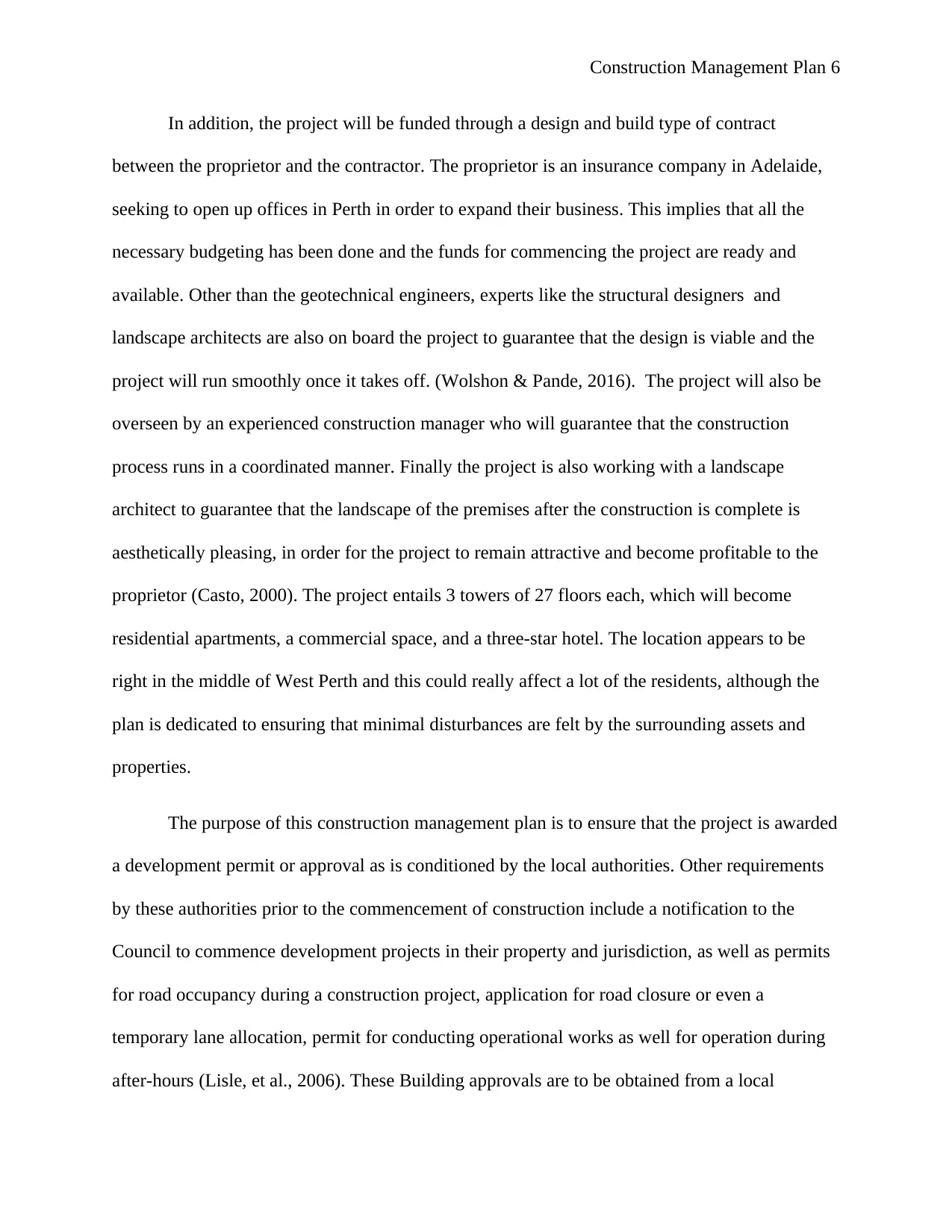
Construction Management Plan 6
In addition, the project will be funded through a design and build type of contract
between the proprietor and the contractor. The proprietor is an insurance company in Adelaide,
seeking to open up offices in Perth in order to expand their business. This implies that all the
necessary budgeting has been done and the funds for commencing the project are ready and
available. Other than the geotechnical engineers, experts like the structural designers and
landscape architects are also on board the project to guarantee that the design is viable and the
project will run smoothly once it takes off. (Wolshon & Pande, 2016). The project will also be
overseen by an experienced construction manager who will guarantee that the construction
process runs in a coordinated manner. Finally the project is also working with a landscape
architect to guarantee that the landscape of the premises after the construction is complete is
aesthetically pleasing, in order for the project to remain attractive and become profitable to the
proprietor (Casto, 2000). The project entails 3 towers of 27 floors each, which will become
residential apartments, a commercial space, and a three-star hotel. The location appears to be
right in the middle of West Perth and this could really affect a lot of the residents, although the
plan is dedicated to ensuring that minimal disturbances are felt by the surrounding assets and
properties.
The purpose of this construction management plan is to ensure that the project is awarded
a development permit or approval as is conditioned by the local authorities. Other requirements
by these authorities prior to the commencement of construction include a notification to the
Council to commence development projects in their property and jurisdiction, as well as permits
for road occupancy during a construction project, application for road closure or even a
temporary lane allocation, permit for conducting operational works as well for operation during
after-hours (Lisle, et al., 2006). These Building approvals are to be obtained from a local
In addition, the project will be funded through a design and build type of contract
between the proprietor and the contractor. The proprietor is an insurance company in Adelaide,
seeking to open up offices in Perth in order to expand their business. This implies that all the
necessary budgeting has been done and the funds for commencing the project are ready and
available. Other than the geotechnical engineers, experts like the structural designers and
landscape architects are also on board the project to guarantee that the design is viable and the
project will run smoothly once it takes off. (Wolshon & Pande, 2016). The project will also be
overseen by an experienced construction manager who will guarantee that the construction
process runs in a coordinated manner. Finally the project is also working with a landscape
architect to guarantee that the landscape of the premises after the construction is complete is
aesthetically pleasing, in order for the project to remain attractive and become profitable to the
proprietor (Casto, 2000). The project entails 3 towers of 27 floors each, which will become
residential apartments, a commercial space, and a three-star hotel. The location appears to be
right in the middle of West Perth and this could really affect a lot of the residents, although the
plan is dedicated to ensuring that minimal disturbances are felt by the surrounding assets and
properties.
The purpose of this construction management plan is to ensure that the project is awarded
a development permit or approval as is conditioned by the local authorities. Other requirements
by these authorities prior to the commencement of construction include a notification to the
Council to commence development projects in their property and jurisdiction, as well as permits
for road occupancy during a construction project, application for road closure or even a
temporary lane allocation, permit for conducting operational works as well for operation during
after-hours (Lisle, et al., 2006). These Building approvals are to be obtained from a local
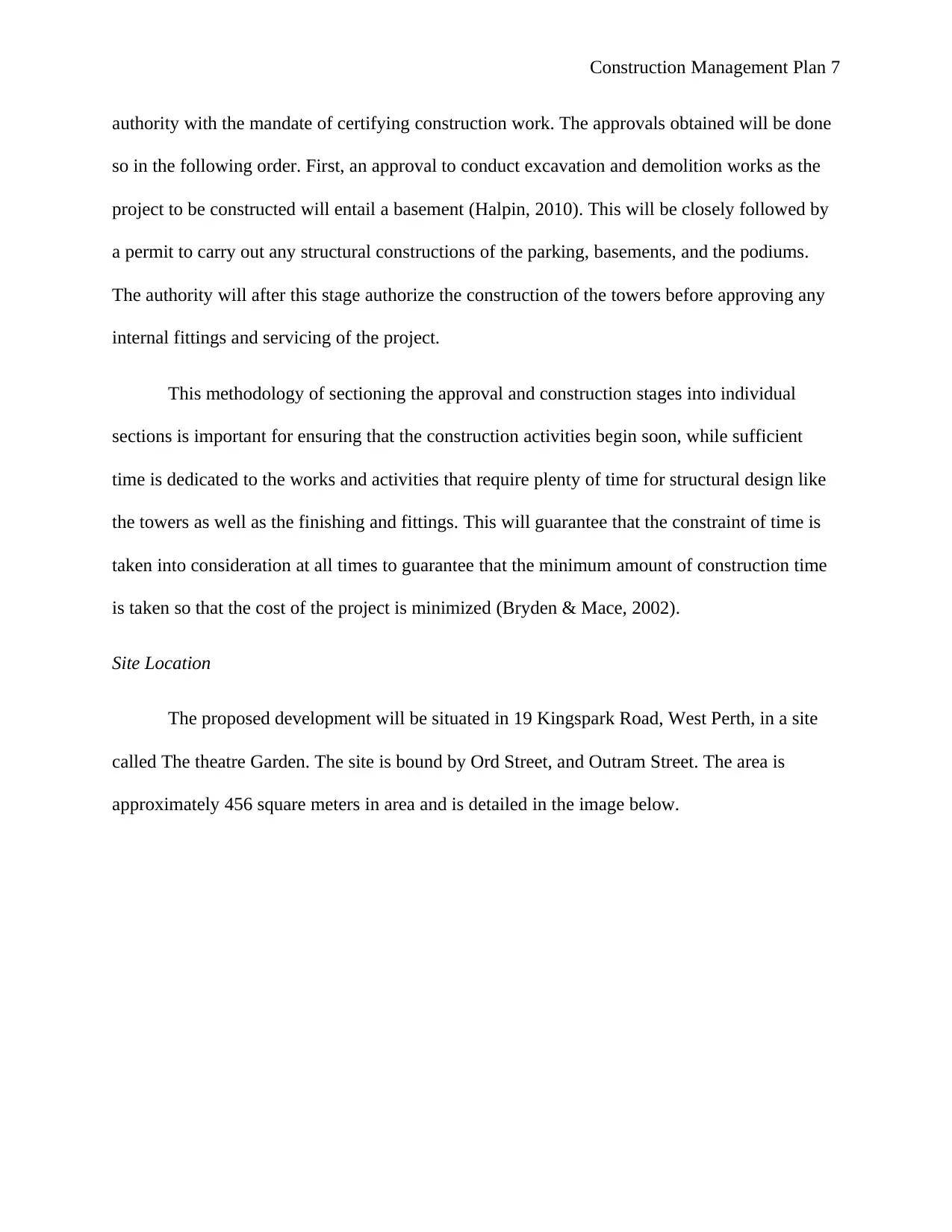
Construction Management Plan 7
authority with the mandate of certifying construction work. The approvals obtained will be done
so in the following order. First, an approval to conduct excavation and demolition works as the
project to be constructed will entail a basement (Halpin, 2010). This will be closely followed by
a permit to carry out any structural constructions of the parking, basements, and the podiums.
The authority will after this stage authorize the construction of the towers before approving any
internal fittings and servicing of the project.
This methodology of sectioning the approval and construction stages into individual
sections is important for ensuring that the construction activities begin soon, while sufficient
time is dedicated to the works and activities that require plenty of time for structural design like
the towers as well as the finishing and fittings. This will guarantee that the constraint of time is
taken into consideration at all times to guarantee that the minimum amount of construction time
is taken so that the cost of the project is minimized (Bryden & Mace, 2002).
Site Location
The proposed development will be situated in 19 Kingspark Road, West Perth, in a site
called The theatre Garden. The site is bound by Ord Street, and Outram Street. The area is
approximately 456 square meters in area and is detailed in the image below.
authority with the mandate of certifying construction work. The approvals obtained will be done
so in the following order. First, an approval to conduct excavation and demolition works as the
project to be constructed will entail a basement (Halpin, 2010). This will be closely followed by
a permit to carry out any structural constructions of the parking, basements, and the podiums.
The authority will after this stage authorize the construction of the towers before approving any
internal fittings and servicing of the project.
This methodology of sectioning the approval and construction stages into individual
sections is important for ensuring that the construction activities begin soon, while sufficient
time is dedicated to the works and activities that require plenty of time for structural design like
the towers as well as the finishing and fittings. This will guarantee that the constraint of time is
taken into consideration at all times to guarantee that the minimum amount of construction time
is taken so that the cost of the project is minimized (Bryden & Mace, 2002).
Site Location
The proposed development will be situated in 19 Kingspark Road, West Perth, in a site
called The theatre Garden. The site is bound by Ord Street, and Outram Street. The area is
approximately 456 square meters in area and is detailed in the image below.
Paraphrase This Document
Need a fresh take? Get an instant paraphrase of this document with our AI Paraphraser
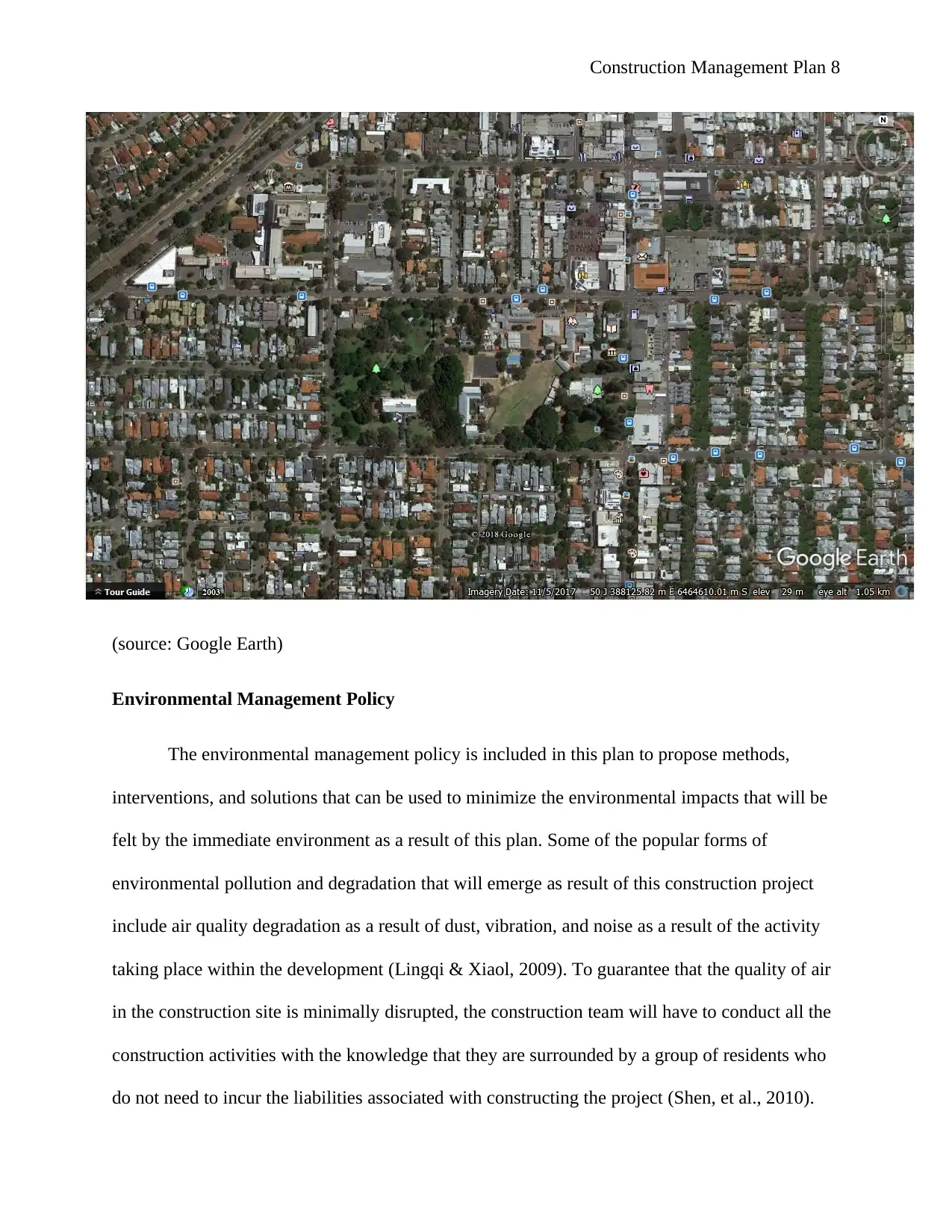
Construction Management Plan 8
(source: Google Earth)
Environmental Management Policy
The environmental management policy is included in this plan to propose methods,
interventions, and solutions that can be used to minimize the environmental impacts that will be
felt by the immediate environment as a result of this plan. Some of the popular forms of
environmental pollution and degradation that will emerge as result of this construction project
include air quality degradation as a result of dust, vibration, and noise as a result of the activity
taking place within the development (Lingqi & Xiaol, 2009). To guarantee that the quality of air
in the construction site is minimally disrupted, the construction team will have to conduct all the
construction activities with the knowledge that they are surrounded by a group of residents who
do not need to incur the liabilities associated with constructing the project (Shen, et al., 2010).
(source: Google Earth)
Environmental Management Policy
The environmental management policy is included in this plan to propose methods,
interventions, and solutions that can be used to minimize the environmental impacts that will be
felt by the immediate environment as a result of this plan. Some of the popular forms of
environmental pollution and degradation that will emerge as result of this construction project
include air quality degradation as a result of dust, vibration, and noise as a result of the activity
taking place within the development (Lingqi & Xiaol, 2009). To guarantee that the quality of air
in the construction site is minimally disrupted, the construction team will have to conduct all the
construction activities with the knowledge that they are surrounded by a group of residents who
do not need to incur the liabilities associated with constructing the project (Shen, et al., 2010).
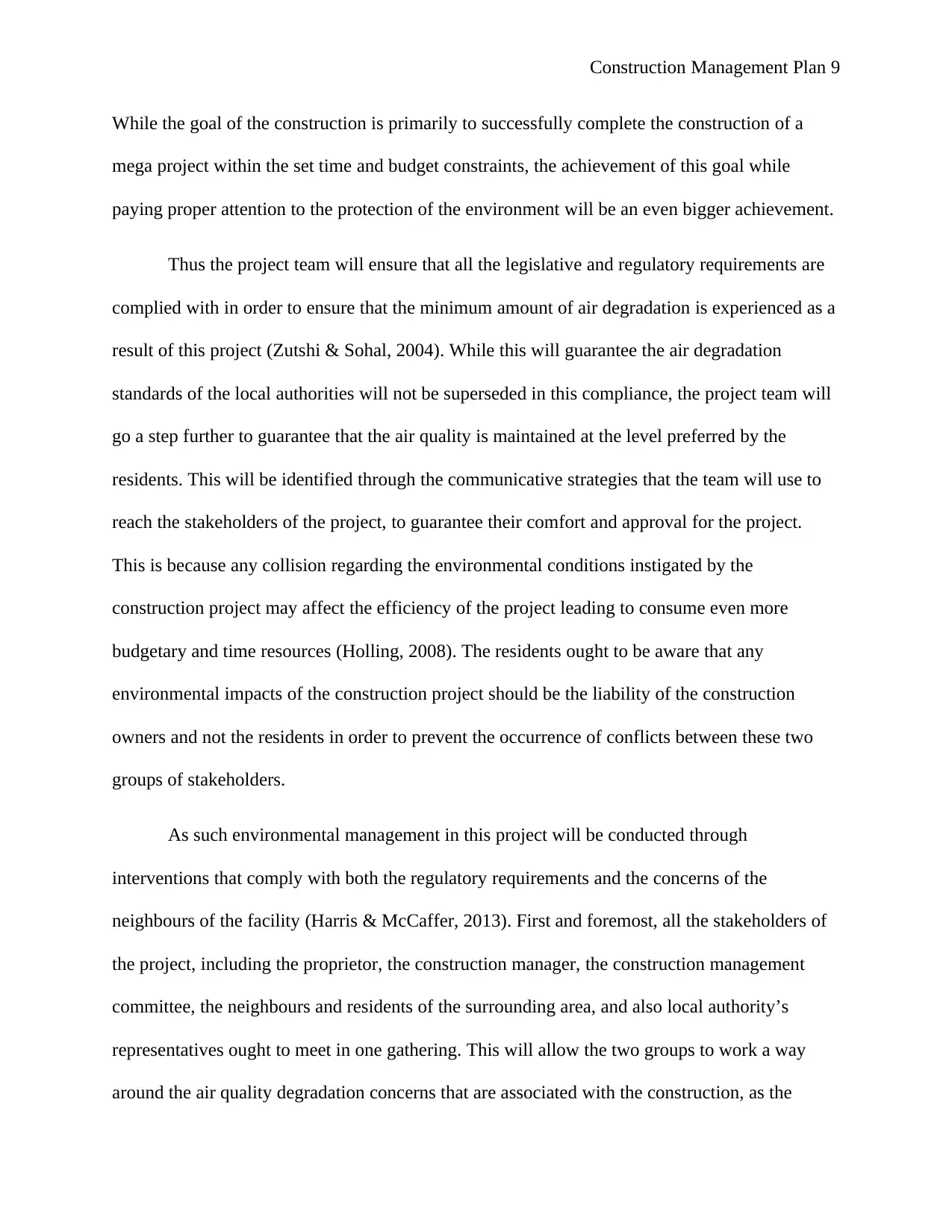
Construction Management Plan 9
While the goal of the construction is primarily to successfully complete the construction of a
mega project within the set time and budget constraints, the achievement of this goal while
paying proper attention to the protection of the environment will be an even bigger achievement.
Thus the project team will ensure that all the legislative and regulatory requirements are
complied with in order to ensure that the minimum amount of air degradation is experienced as a
result of this project (Zutshi & Sohal, 2004). While this will guarantee the air degradation
standards of the local authorities will not be superseded in this compliance, the project team will
go a step further to guarantee that the air quality is maintained at the level preferred by the
residents. This will be identified through the communicative strategies that the team will use to
reach the stakeholders of the project, to guarantee their comfort and approval for the project.
This is because any collision regarding the environmental conditions instigated by the
construction project may affect the efficiency of the project leading to consume even more
budgetary and time resources (Holling, 2008). The residents ought to be aware that any
environmental impacts of the construction project should be the liability of the construction
owners and not the residents in order to prevent the occurrence of conflicts between these two
groups of stakeholders.
As such environmental management in this project will be conducted through
interventions that comply with both the regulatory requirements and the concerns of the
neighbours of the facility (Harris & McCaffer, 2013). First and foremost, all the stakeholders of
the project, including the proprietor, the construction manager, the construction management
committee, the neighbours and residents of the surrounding area, and also local authority’s
representatives ought to meet in one gathering. This will allow the two groups to work a way
around the air quality degradation concerns that are associated with the construction, as the
While the goal of the construction is primarily to successfully complete the construction of a
mega project within the set time and budget constraints, the achievement of this goal while
paying proper attention to the protection of the environment will be an even bigger achievement.
Thus the project team will ensure that all the legislative and regulatory requirements are
complied with in order to ensure that the minimum amount of air degradation is experienced as a
result of this project (Zutshi & Sohal, 2004). While this will guarantee the air degradation
standards of the local authorities will not be superseded in this compliance, the project team will
go a step further to guarantee that the air quality is maintained at the level preferred by the
residents. This will be identified through the communicative strategies that the team will use to
reach the stakeholders of the project, to guarantee their comfort and approval for the project.
This is because any collision regarding the environmental conditions instigated by the
construction project may affect the efficiency of the project leading to consume even more
budgetary and time resources (Holling, 2008). The residents ought to be aware that any
environmental impacts of the construction project should be the liability of the construction
owners and not the residents in order to prevent the occurrence of conflicts between these two
groups of stakeholders.
As such environmental management in this project will be conducted through
interventions that comply with both the regulatory requirements and the concerns of the
neighbours of the facility (Harris & McCaffer, 2013). First and foremost, all the stakeholders of
the project, including the proprietor, the construction manager, the construction management
committee, the neighbours and residents of the surrounding area, and also local authority’s
representatives ought to meet in one gathering. This will allow the two groups to work a way
around the air quality degradation concerns that are associated with the construction, as the
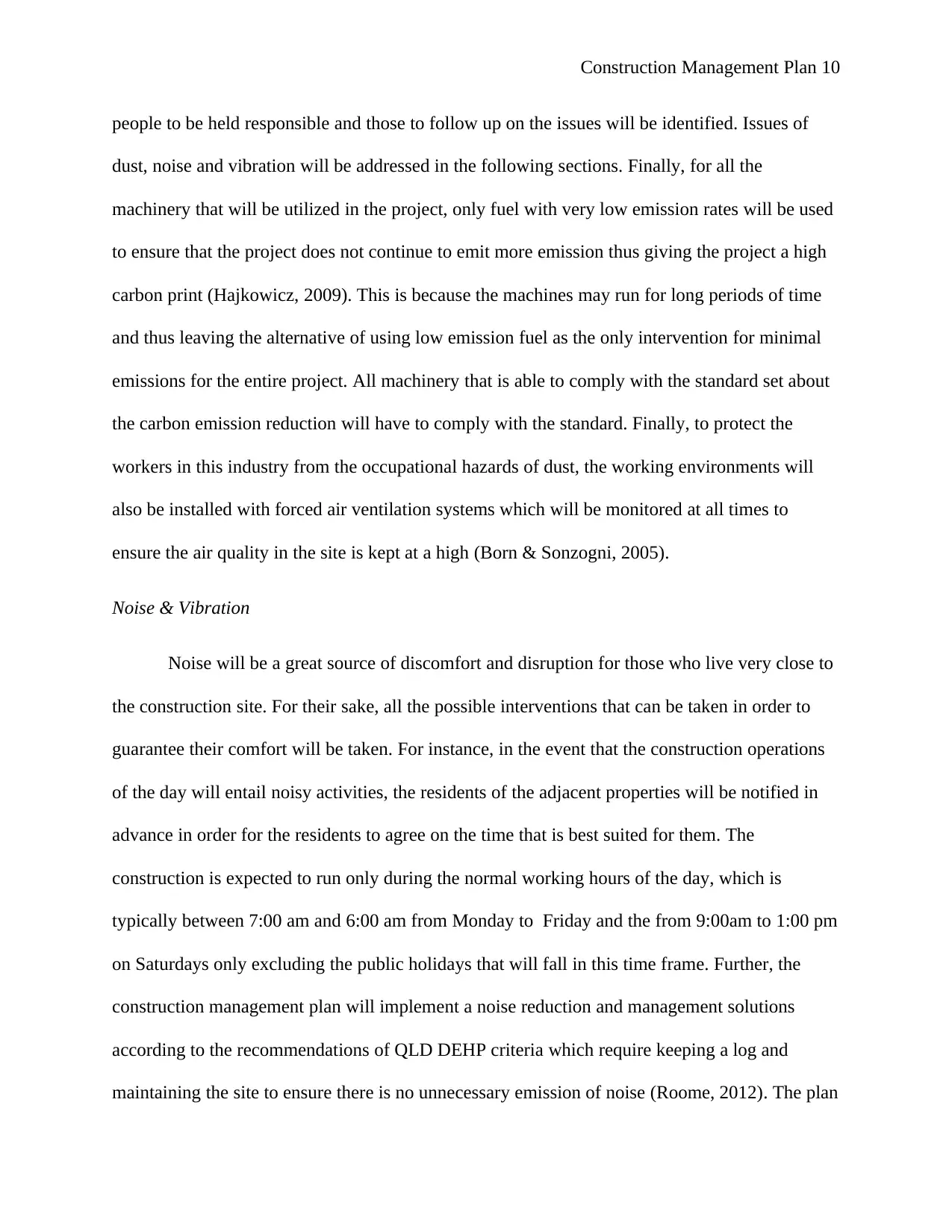
Construction Management Plan 10
people to be held responsible and those to follow up on the issues will be identified. Issues of
dust, noise and vibration will be addressed in the following sections. Finally, for all the
machinery that will be utilized in the project, only fuel with very low emission rates will be used
to ensure that the project does not continue to emit more emission thus giving the project a high
carbon print (Hajkowicz, 2009). This is because the machines may run for long periods of time
and thus leaving the alternative of using low emission fuel as the only intervention for minimal
emissions for the entire project. All machinery that is able to comply with the standard set about
the carbon emission reduction will have to comply with the standard. Finally, to protect the
workers in this industry from the occupational hazards of dust, the working environments will
also be installed with forced air ventilation systems which will be monitored at all times to
ensure the air quality in the site is kept at a high (Born & Sonzogni, 2005).
Noise & Vibration
Noise will be a great source of discomfort and disruption for those who live very close to
the construction site. For their sake, all the possible interventions that can be taken in order to
guarantee their comfort will be taken. For instance, in the event that the construction operations
of the day will entail noisy activities, the residents of the adjacent properties will be notified in
advance in order for the residents to agree on the time that is best suited for them. The
construction is expected to run only during the normal working hours of the day, which is
typically between 7:00 am and 6:00 am from Monday to Friday and the from 9:00am to 1:00 pm
on Saturdays only excluding the public holidays that will fall in this time frame. Further, the
construction management plan will implement a noise reduction and management solutions
according to the recommendations of QLD DEHP criteria which require keeping a log and
maintaining the site to ensure there is no unnecessary emission of noise (Roome, 2012). The plan
people to be held responsible and those to follow up on the issues will be identified. Issues of
dust, noise and vibration will be addressed in the following sections. Finally, for all the
machinery that will be utilized in the project, only fuel with very low emission rates will be used
to ensure that the project does not continue to emit more emission thus giving the project a high
carbon print (Hajkowicz, 2009). This is because the machines may run for long periods of time
and thus leaving the alternative of using low emission fuel as the only intervention for minimal
emissions for the entire project. All machinery that is able to comply with the standard set about
the carbon emission reduction will have to comply with the standard. Finally, to protect the
workers in this industry from the occupational hazards of dust, the working environments will
also be installed with forced air ventilation systems which will be monitored at all times to
ensure the air quality in the site is kept at a high (Born & Sonzogni, 2005).
Noise & Vibration
Noise will be a great source of discomfort and disruption for those who live very close to
the construction site. For their sake, all the possible interventions that can be taken in order to
guarantee their comfort will be taken. For instance, in the event that the construction operations
of the day will entail noisy activities, the residents of the adjacent properties will be notified in
advance in order for the residents to agree on the time that is best suited for them. The
construction is expected to run only during the normal working hours of the day, which is
typically between 7:00 am and 6:00 am from Monday to Friday and the from 9:00am to 1:00 pm
on Saturdays only excluding the public holidays that will fall in this time frame. Further, the
construction management plan will implement a noise reduction and management solutions
according to the recommendations of QLD DEHP criteria which require keeping a log and
maintaining the site to ensure there is no unnecessary emission of noise (Roome, 2012). The plan
Secure Best Marks with AI Grader
Need help grading? Try our AI Grader for instant feedback on your assignments.
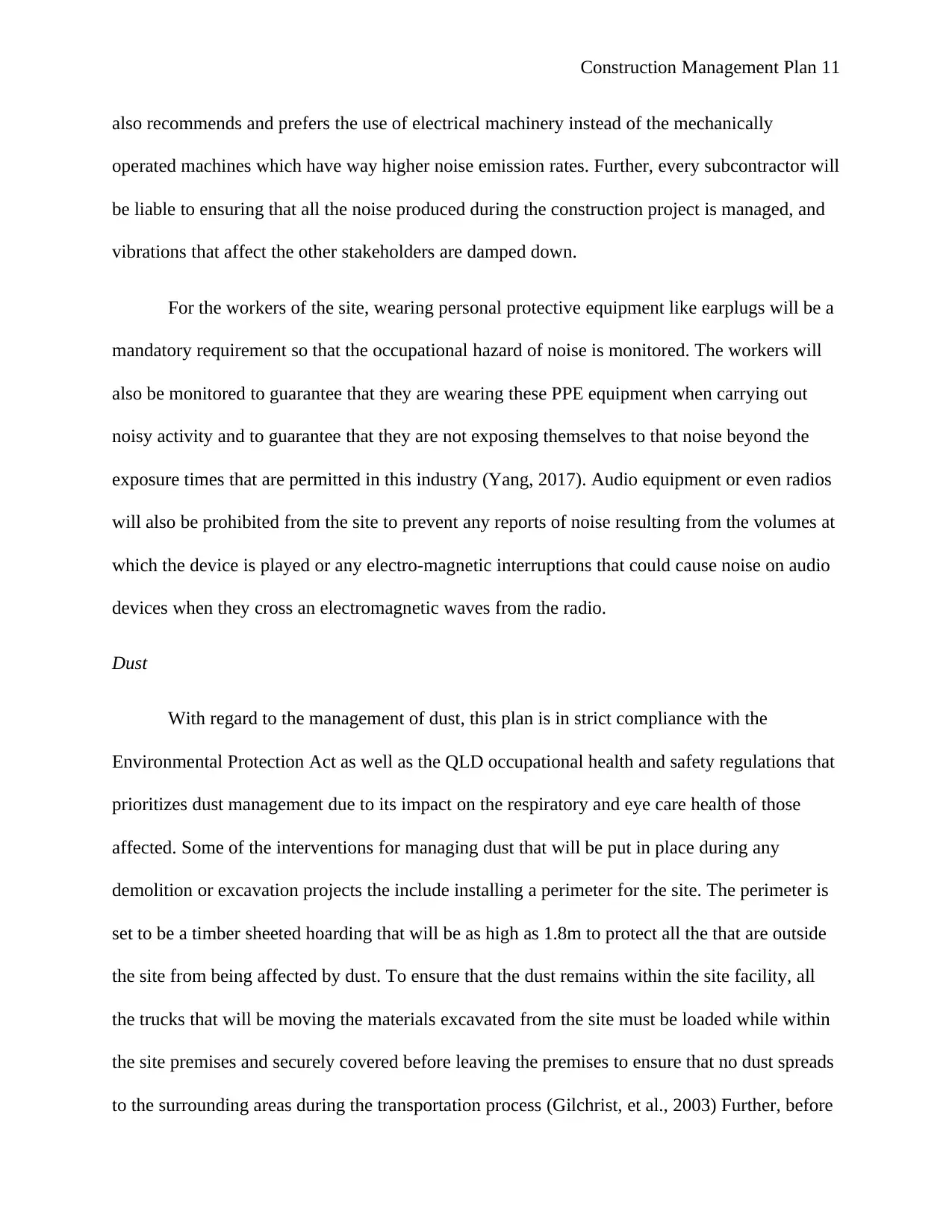
Construction Management Plan 11
also recommends and prefers the use of electrical machinery instead of the mechanically
operated machines which have way higher noise emission rates. Further, every subcontractor will
be liable to ensuring that all the noise produced during the construction project is managed, and
vibrations that affect the other stakeholders are damped down.
For the workers of the site, wearing personal protective equipment like earplugs will be a
mandatory requirement so that the occupational hazard of noise is monitored. The workers will
also be monitored to guarantee that they are wearing these PPE equipment when carrying out
noisy activity and to guarantee that they are not exposing themselves to that noise beyond the
exposure times that are permitted in this industry (Yang, 2017). Audio equipment or even radios
will also be prohibited from the site to prevent any reports of noise resulting from the volumes at
which the device is played or any electro-magnetic interruptions that could cause noise on audio
devices when they cross an electromagnetic waves from the radio.
Dust
With regard to the management of dust, this plan is in strict compliance with the
Environmental Protection Act as well as the QLD occupational health and safety regulations that
prioritizes dust management due to its impact on the respiratory and eye care health of those
affected. Some of the interventions for managing dust that will be put in place during any
demolition or excavation projects the include installing a perimeter for the site. The perimeter is
set to be a timber sheeted hoarding that will be as high as 1.8m to protect all the that are outside
the site from being affected by dust. To ensure that the dust remains within the site facility, all
the trucks that will be moving the materials excavated from the site must be loaded while within
the site premises and securely covered before leaving the premises to ensure that no dust spreads
to the surrounding areas during the transportation process (Gilchrist, et al., 2003) Further, before
also recommends and prefers the use of electrical machinery instead of the mechanically
operated machines which have way higher noise emission rates. Further, every subcontractor will
be liable to ensuring that all the noise produced during the construction project is managed, and
vibrations that affect the other stakeholders are damped down.
For the workers of the site, wearing personal protective equipment like earplugs will be a
mandatory requirement so that the occupational hazard of noise is monitored. The workers will
also be monitored to guarantee that they are wearing these PPE equipment when carrying out
noisy activity and to guarantee that they are not exposing themselves to that noise beyond the
exposure times that are permitted in this industry (Yang, 2017). Audio equipment or even radios
will also be prohibited from the site to prevent any reports of noise resulting from the volumes at
which the device is played or any electro-magnetic interruptions that could cause noise on audio
devices when they cross an electromagnetic waves from the radio.
Dust
With regard to the management of dust, this plan is in strict compliance with the
Environmental Protection Act as well as the QLD occupational health and safety regulations that
prioritizes dust management due to its impact on the respiratory and eye care health of those
affected. Some of the interventions for managing dust that will be put in place during any
demolition or excavation projects the include installing a perimeter for the site. The perimeter is
set to be a timber sheeted hoarding that will be as high as 1.8m to protect all the that are outside
the site from being affected by dust. To ensure that the dust remains within the site facility, all
the trucks that will be moving the materials excavated from the site must be loaded while within
the site premises and securely covered before leaving the premises to ensure that no dust spreads
to the surrounding areas during the transportation process (Gilchrist, et al., 2003) Further, before
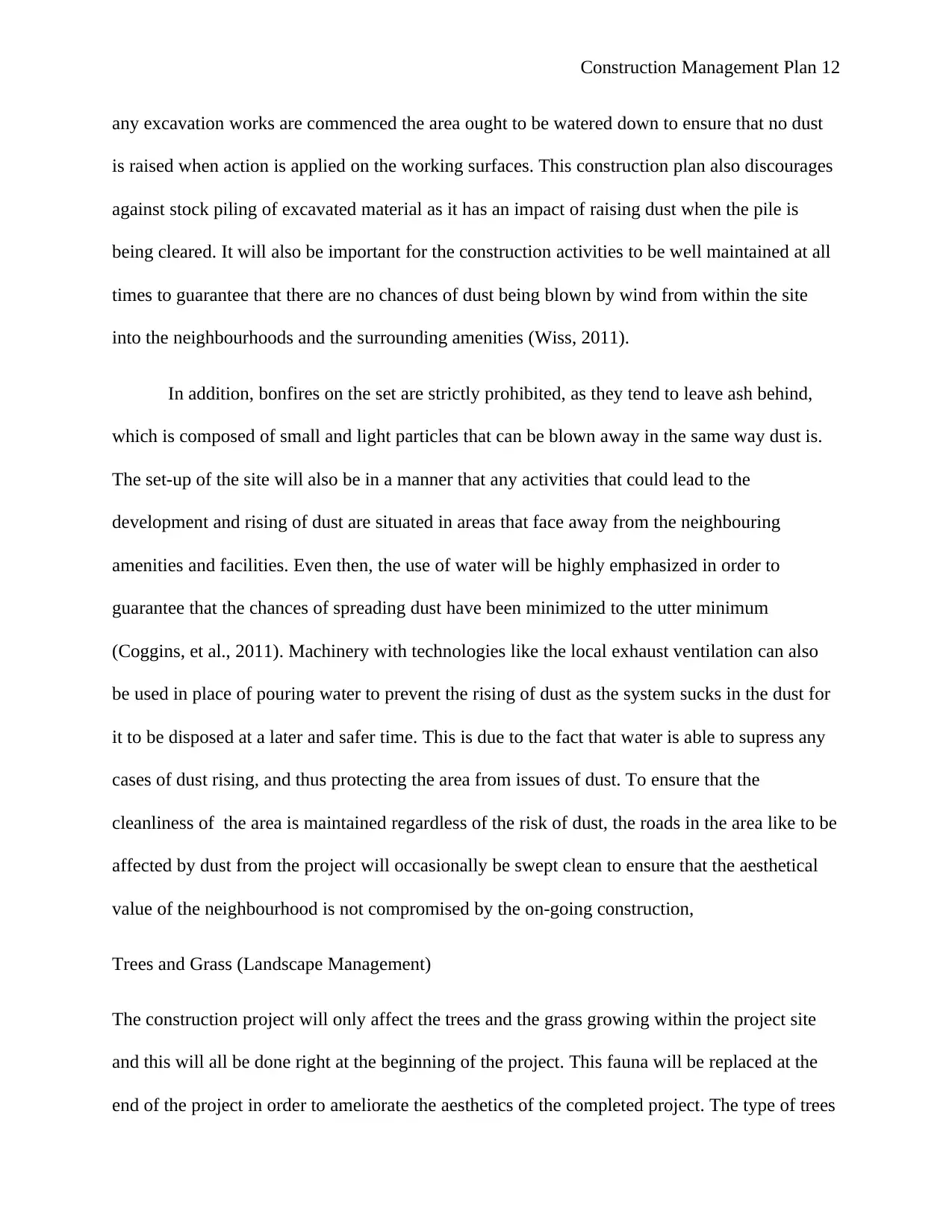
Construction Management Plan 12
any excavation works are commenced the area ought to be watered down to ensure that no dust
is raised when action is applied on the working surfaces. This construction plan also discourages
against stock piling of excavated material as it has an impact of raising dust when the pile is
being cleared. It will also be important for the construction activities to be well maintained at all
times to guarantee that there are no chances of dust being blown by wind from within the site
into the neighbourhoods and the surrounding amenities (Wiss, 2011).
In addition, bonfires on the set are strictly prohibited, as they tend to leave ash behind,
which is composed of small and light particles that can be blown away in the same way dust is.
The set-up of the site will also be in a manner that any activities that could lead to the
development and rising of dust are situated in areas that face away from the neighbouring
amenities and facilities. Even then, the use of water will be highly emphasized in order to
guarantee that the chances of spreading dust have been minimized to the utter minimum
(Coggins, et al., 2011). Machinery with technologies like the local exhaust ventilation can also
be used in place of pouring water to prevent the rising of dust as the system sucks in the dust for
it to be disposed at a later and safer time. This is due to the fact that water is able to supress any
cases of dust rising, and thus protecting the area from issues of dust. To ensure that the
cleanliness of the area is maintained regardless of the risk of dust, the roads in the area like to be
affected by dust from the project will occasionally be swept clean to ensure that the aesthetical
value of the neighbourhood is not compromised by the on-going construction,
Trees and Grass (Landscape Management)
The construction project will only affect the trees and the grass growing within the project site
and this will all be done right at the beginning of the project. This fauna will be replaced at the
end of the project in order to ameliorate the aesthetics of the completed project. The type of trees
any excavation works are commenced the area ought to be watered down to ensure that no dust
is raised when action is applied on the working surfaces. This construction plan also discourages
against stock piling of excavated material as it has an impact of raising dust when the pile is
being cleared. It will also be important for the construction activities to be well maintained at all
times to guarantee that there are no chances of dust being blown by wind from within the site
into the neighbourhoods and the surrounding amenities (Wiss, 2011).
In addition, bonfires on the set are strictly prohibited, as they tend to leave ash behind,
which is composed of small and light particles that can be blown away in the same way dust is.
The set-up of the site will also be in a manner that any activities that could lead to the
development and rising of dust are situated in areas that face away from the neighbouring
amenities and facilities. Even then, the use of water will be highly emphasized in order to
guarantee that the chances of spreading dust have been minimized to the utter minimum
(Coggins, et al., 2011). Machinery with technologies like the local exhaust ventilation can also
be used in place of pouring water to prevent the rising of dust as the system sucks in the dust for
it to be disposed at a later and safer time. This is due to the fact that water is able to supress any
cases of dust rising, and thus protecting the area from issues of dust. To ensure that the
cleanliness of the area is maintained regardless of the risk of dust, the roads in the area like to be
affected by dust from the project will occasionally be swept clean to ensure that the aesthetical
value of the neighbourhood is not compromised by the on-going construction,
Trees and Grass (Landscape Management)
The construction project will only affect the trees and the grass growing within the project site
and this will all be done right at the beginning of the project. This fauna will be replaced at the
end of the project in order to ameliorate the aesthetics of the completed project. The type of trees
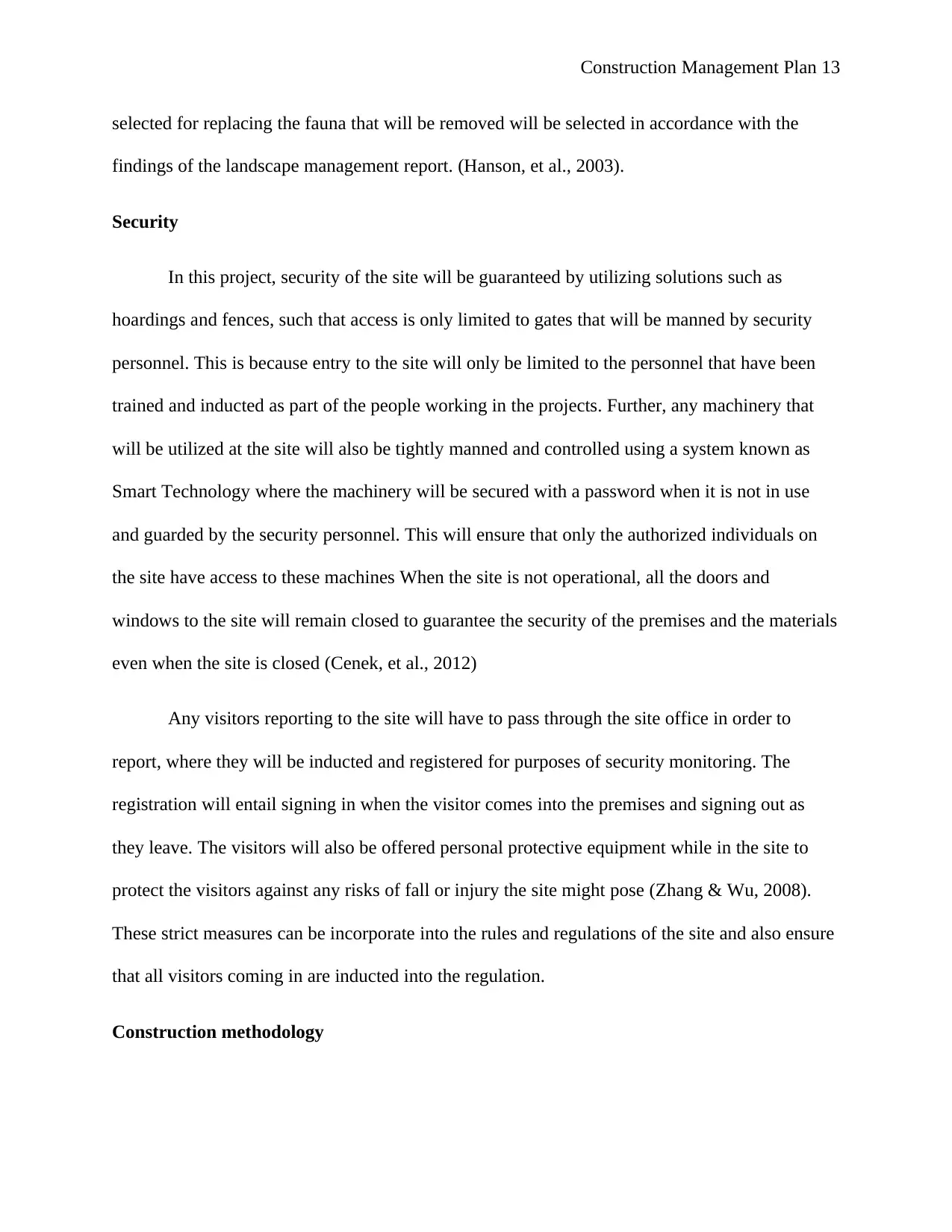
Construction Management Plan 13
selected for replacing the fauna that will be removed will be selected in accordance with the
findings of the landscape management report. (Hanson, et al., 2003).
Security
In this project, security of the site will be guaranteed by utilizing solutions such as
hoardings and fences, such that access is only limited to gates that will be manned by security
personnel. This is because entry to the site will only be limited to the personnel that have been
trained and inducted as part of the people working in the projects. Further, any machinery that
will be utilized at the site will also be tightly manned and controlled using a system known as
Smart Technology where the machinery will be secured with a password when it is not in use
and guarded by the security personnel. This will ensure that only the authorized individuals on
the site have access to these machines When the site is not operational, all the doors and
windows to the site will remain closed to guarantee the security of the premises and the materials
even when the site is closed (Cenek, et al., 2012)
Any visitors reporting to the site will have to pass through the site office in order to
report, where they will be inducted and registered for purposes of security monitoring. The
registration will entail signing in when the visitor comes into the premises and signing out as
they leave. The visitors will also be offered personal protective equipment while in the site to
protect the visitors against any risks of fall or injury the site might pose (Zhang & Wu, 2008).
These strict measures can be incorporate into the rules and regulations of the site and also ensure
that all visitors coming in are inducted into the regulation.
Construction methodology
selected for replacing the fauna that will be removed will be selected in accordance with the
findings of the landscape management report. (Hanson, et al., 2003).
Security
In this project, security of the site will be guaranteed by utilizing solutions such as
hoardings and fences, such that access is only limited to gates that will be manned by security
personnel. This is because entry to the site will only be limited to the personnel that have been
trained and inducted as part of the people working in the projects. Further, any machinery that
will be utilized at the site will also be tightly manned and controlled using a system known as
Smart Technology where the machinery will be secured with a password when it is not in use
and guarded by the security personnel. This will ensure that only the authorized individuals on
the site have access to these machines When the site is not operational, all the doors and
windows to the site will remain closed to guarantee the security of the premises and the materials
even when the site is closed (Cenek, et al., 2012)
Any visitors reporting to the site will have to pass through the site office in order to
report, where they will be inducted and registered for purposes of security monitoring. The
registration will entail signing in when the visitor comes into the premises and signing out as
they leave. The visitors will also be offered personal protective equipment while in the site to
protect the visitors against any risks of fall or injury the site might pose (Zhang & Wu, 2008).
These strict measures can be incorporate into the rules and regulations of the site and also ensure
that all visitors coming in are inducted into the regulation.
Construction methodology
Paraphrase This Document
Need a fresh take? Get an instant paraphrase of this document with our AI Paraphraser
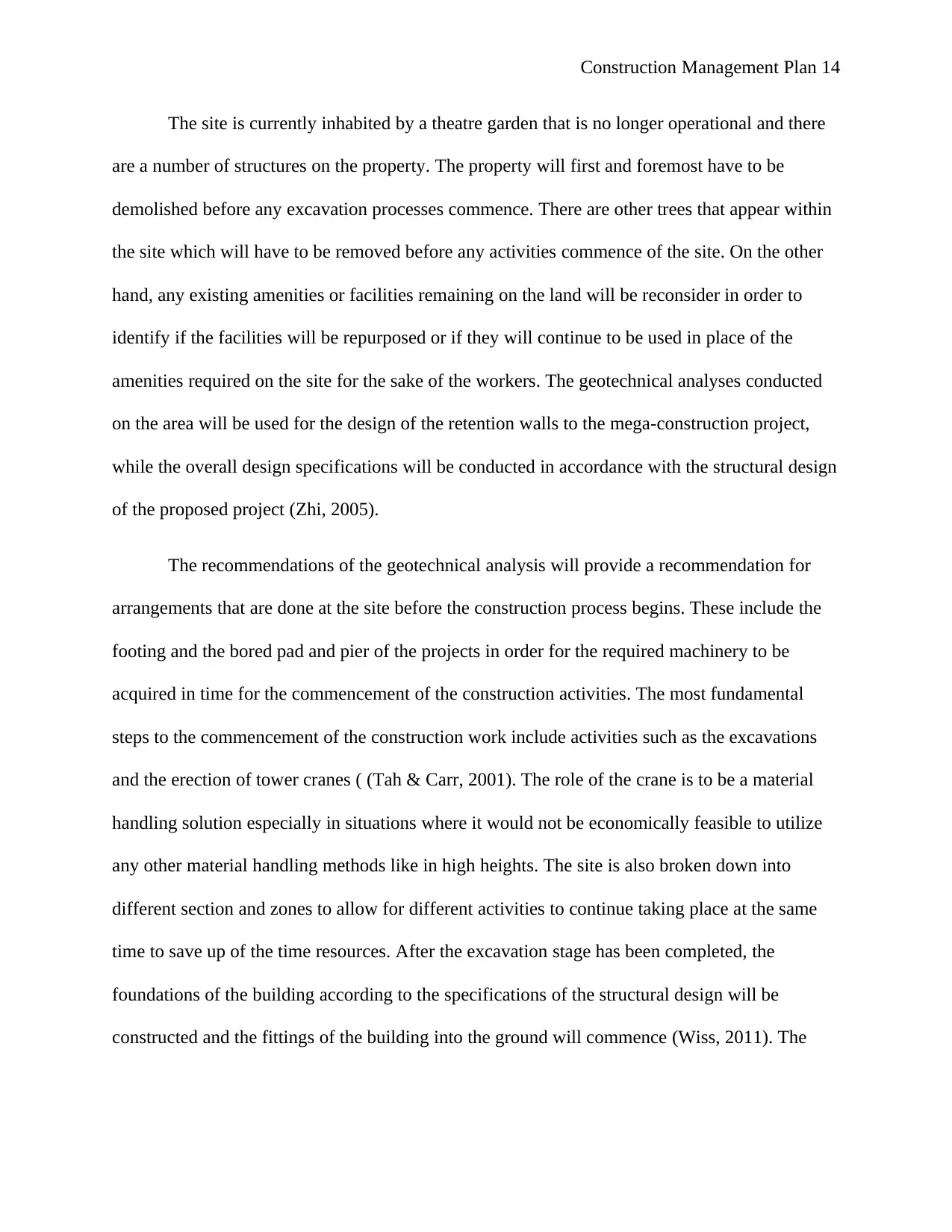
Construction Management Plan 14
The site is currently inhabited by a theatre garden that is no longer operational and there
are a number of structures on the property. The property will first and foremost have to be
demolished before any excavation processes commence. There are other trees that appear within
the site which will have to be removed before any activities commence of the site. On the other
hand, any existing amenities or facilities remaining on the land will be reconsider in order to
identify if the facilities will be repurposed or if they will continue to be used in place of the
amenities required on the site for the sake of the workers. The geotechnical analyses conducted
on the area will be used for the design of the retention walls to the mega-construction project,
while the overall design specifications will be conducted in accordance with the structural design
of the proposed project (Zhi, 2005).
The recommendations of the geotechnical analysis will provide a recommendation for
arrangements that are done at the site before the construction process begins. These include the
footing and the bored pad and pier of the projects in order for the required machinery to be
acquired in time for the commencement of the construction activities. The most fundamental
steps to the commencement of the construction work include activities such as the excavations
and the erection of tower cranes ( (Tah & Carr, 2001). The role of the crane is to be a material
handling solution especially in situations where it would not be economically feasible to utilize
any other material handling methods like in high heights. The site is also broken down into
different section and zones to allow for different activities to continue taking place at the same
time to save up of the time resources. After the excavation stage has been completed, the
foundations of the building according to the specifications of the structural design will be
constructed and the fittings of the building into the ground will commence (Wiss, 2011). The
The site is currently inhabited by a theatre garden that is no longer operational and there
are a number of structures on the property. The property will first and foremost have to be
demolished before any excavation processes commence. There are other trees that appear within
the site which will have to be removed before any activities commence of the site. On the other
hand, any existing amenities or facilities remaining on the land will be reconsider in order to
identify if the facilities will be repurposed or if they will continue to be used in place of the
amenities required on the site for the sake of the workers. The geotechnical analyses conducted
on the area will be used for the design of the retention walls to the mega-construction project,
while the overall design specifications will be conducted in accordance with the structural design
of the proposed project (Zhi, 2005).
The recommendations of the geotechnical analysis will provide a recommendation for
arrangements that are done at the site before the construction process begins. These include the
footing and the bored pad and pier of the projects in order for the required machinery to be
acquired in time for the commencement of the construction activities. The most fundamental
steps to the commencement of the construction work include activities such as the excavations
and the erection of tower cranes ( (Tah & Carr, 2001). The role of the crane is to be a material
handling solution especially in situations where it would not be economically feasible to utilize
any other material handling methods like in high heights. The site is also broken down into
different section and zones to allow for different activities to continue taking place at the same
time to save up of the time resources. After the excavation stage has been completed, the
foundations of the building according to the specifications of the structural design will be
constructed and the fittings of the building into the ground will commence (Wiss, 2011). The
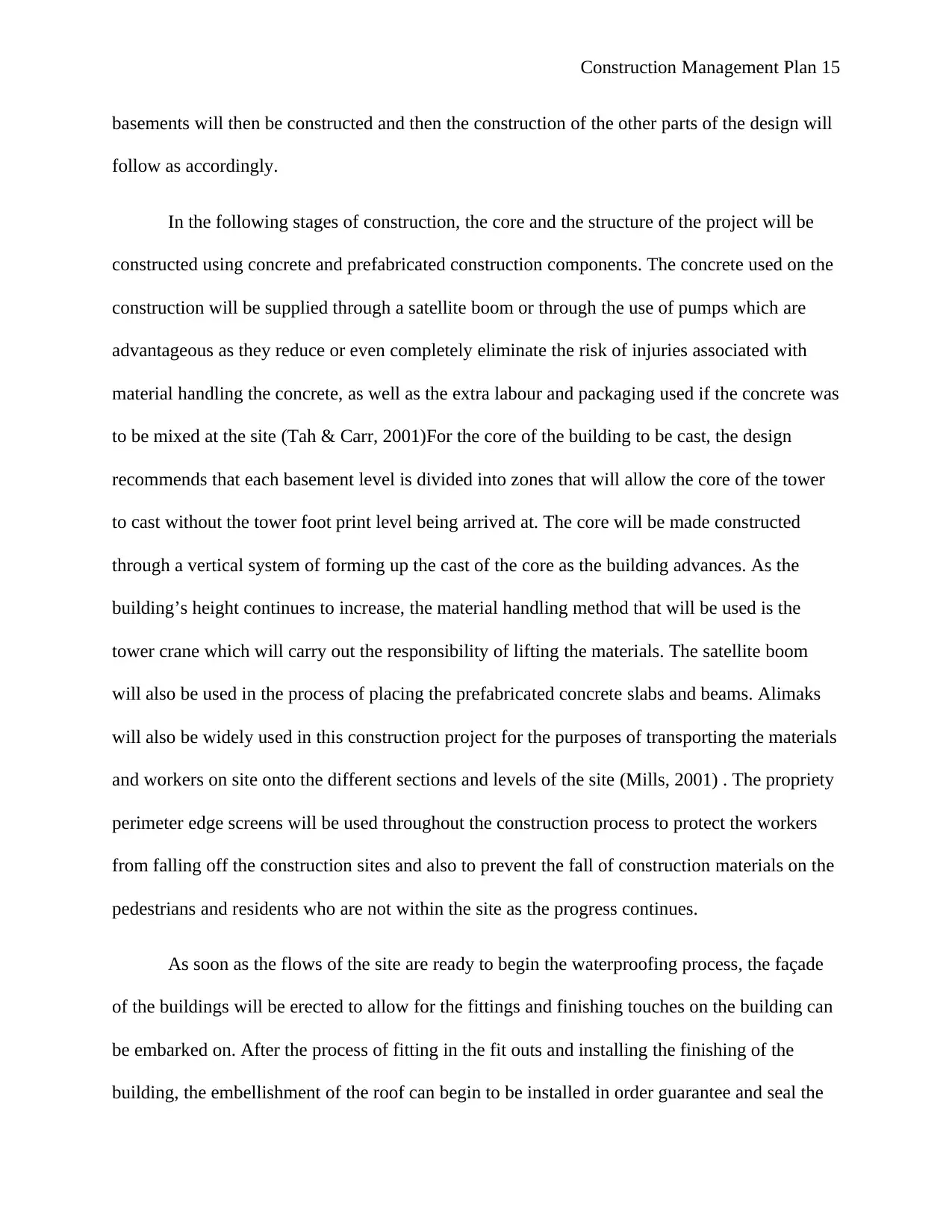
Construction Management Plan 15
basements will then be constructed and then the construction of the other parts of the design will
follow as accordingly.
In the following stages of construction, the core and the structure of the project will be
constructed using concrete and prefabricated construction components. The concrete used on the
construction will be supplied through a satellite boom or through the use of pumps which are
advantageous as they reduce or even completely eliminate the risk of injuries associated with
material handling the concrete, as well as the extra labour and packaging used if the concrete was
to be mixed at the site (Tah & Carr, 2001)For the core of the building to be cast, the design
recommends that each basement level is divided into zones that will allow the core of the tower
to cast without the tower foot print level being arrived at. The core will be made constructed
through a vertical system of forming up the cast of the core as the building advances. As the
building’s height continues to increase, the material handling method that will be used is the
tower crane which will carry out the responsibility of lifting the materials. The satellite boom
will also be used in the process of placing the prefabricated concrete slabs and beams. Alimaks
will also be widely used in this construction project for the purposes of transporting the materials
and workers on site onto the different sections and levels of the site (Mills, 2001) . The propriety
perimeter edge screens will be used throughout the construction process to protect the workers
from falling off the construction sites and also to prevent the fall of construction materials on the
pedestrians and residents who are not within the site as the progress continues.
As soon as the flows of the site are ready to begin the waterproofing process, the façade
of the buildings will be erected to allow for the fittings and finishing touches on the building can
be embarked on. After the process of fitting in the fit outs and installing the finishing of the
building, the embellishment of the roof can begin to be installed in order guarantee and seal the
basements will then be constructed and then the construction of the other parts of the design will
follow as accordingly.
In the following stages of construction, the core and the structure of the project will be
constructed using concrete and prefabricated construction components. The concrete used on the
construction will be supplied through a satellite boom or through the use of pumps which are
advantageous as they reduce or even completely eliminate the risk of injuries associated with
material handling the concrete, as well as the extra labour and packaging used if the concrete was
to be mixed at the site (Tah & Carr, 2001)For the core of the building to be cast, the design
recommends that each basement level is divided into zones that will allow the core of the tower
to cast without the tower foot print level being arrived at. The core will be made constructed
through a vertical system of forming up the cast of the core as the building advances. As the
building’s height continues to increase, the material handling method that will be used is the
tower crane which will carry out the responsibility of lifting the materials. The satellite boom
will also be used in the process of placing the prefabricated concrete slabs and beams. Alimaks
will also be widely used in this construction project for the purposes of transporting the materials
and workers on site onto the different sections and levels of the site (Mills, 2001) . The propriety
perimeter edge screens will be used throughout the construction process to protect the workers
from falling off the construction sites and also to prevent the fall of construction materials on the
pedestrians and residents who are not within the site as the progress continues.
As soon as the flows of the site are ready to begin the waterproofing process, the façade
of the buildings will be erected to allow for the fittings and finishing touches on the building can
be embarked on. After the process of fitting in the fit outs and installing the finishing of the
building, the embellishment of the roof can begin to be installed in order guarantee and seal the
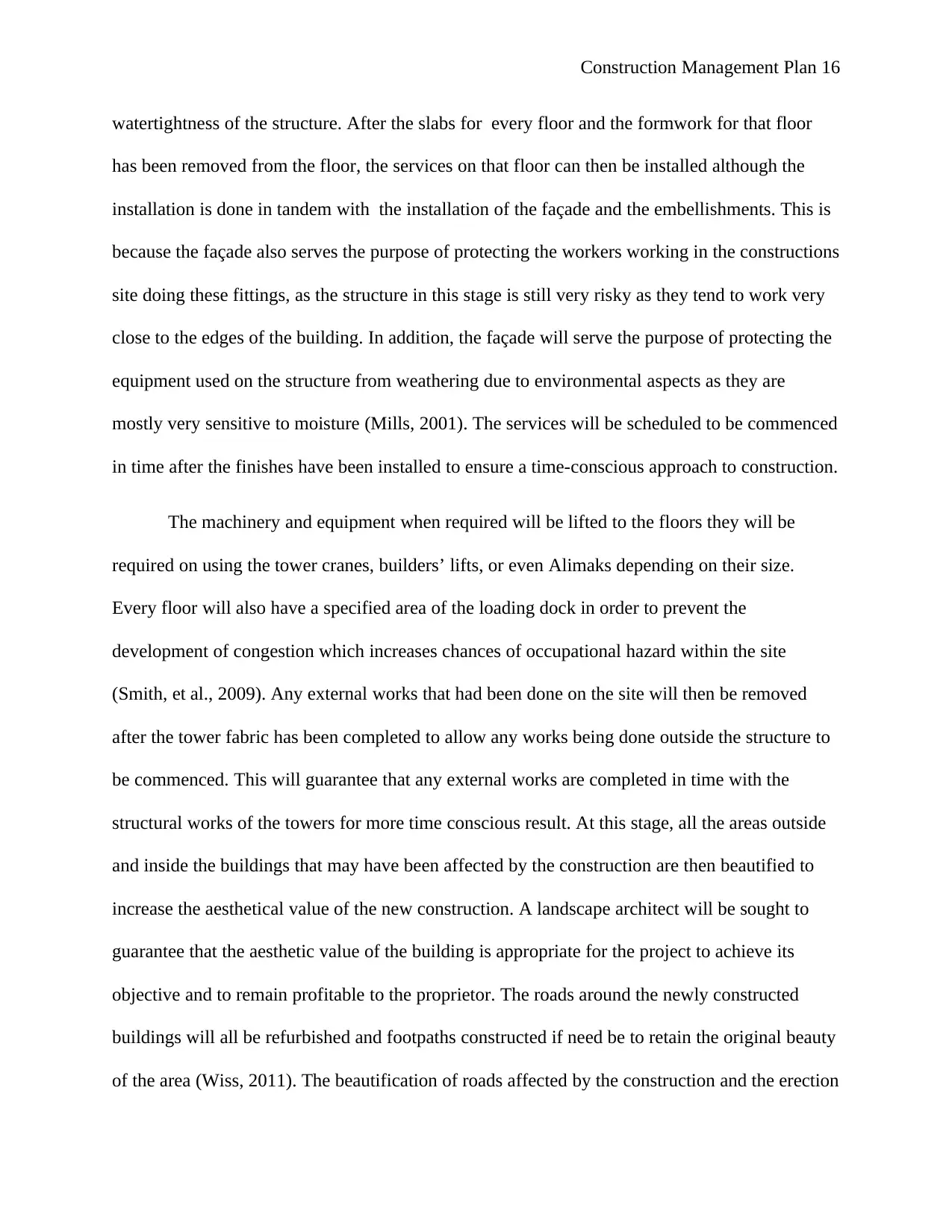
Construction Management Plan 16
watertightness of the structure. After the slabs for every floor and the formwork for that floor
has been removed from the floor, the services on that floor can then be installed although the
installation is done in tandem with the installation of the façade and the embellishments. This is
because the façade also serves the purpose of protecting the workers working in the constructions
site doing these fittings, as the structure in this stage is still very risky as they tend to work very
close to the edges of the building. In addition, the façade will serve the purpose of protecting the
equipment used on the structure from weathering due to environmental aspects as they are
mostly very sensitive to moisture (Mills, 2001). The services will be scheduled to be commenced
in time after the finishes have been installed to ensure a time-conscious approach to construction.
The machinery and equipment when required will be lifted to the floors they will be
required on using the tower cranes, builders’ lifts, or even Alimaks depending on their size.
Every floor will also have a specified area of the loading dock in order to prevent the
development of congestion which increases chances of occupational hazard within the site
(Smith, et al., 2009). Any external works that had been done on the site will then be removed
after the tower fabric has been completed to allow any works being done outside the structure to
be commenced. This will guarantee that any external works are completed in time with the
structural works of the towers for more time conscious result. At this stage, all the areas outside
and inside the buildings that may have been affected by the construction are then beautified to
increase the aesthetical value of the new construction. A landscape architect will be sought to
guarantee that the aesthetic value of the building is appropriate for the project to achieve its
objective and to remain profitable to the proprietor. The roads around the newly constructed
buildings will all be refurbished and footpaths constructed if need be to retain the original beauty
of the area (Wiss, 2011). The beautification of roads affected by the construction and the erection
watertightness of the structure. After the slabs for every floor and the formwork for that floor
has been removed from the floor, the services on that floor can then be installed although the
installation is done in tandem with the installation of the façade and the embellishments. This is
because the façade also serves the purpose of protecting the workers working in the constructions
site doing these fittings, as the structure in this stage is still very risky as they tend to work very
close to the edges of the building. In addition, the façade will serve the purpose of protecting the
equipment used on the structure from weathering due to environmental aspects as they are
mostly very sensitive to moisture (Mills, 2001). The services will be scheduled to be commenced
in time after the finishes have been installed to ensure a time-conscious approach to construction.
The machinery and equipment when required will be lifted to the floors they will be
required on using the tower cranes, builders’ lifts, or even Alimaks depending on their size.
Every floor will also have a specified area of the loading dock in order to prevent the
development of congestion which increases chances of occupational hazard within the site
(Smith, et al., 2009). Any external works that had been done on the site will then be removed
after the tower fabric has been completed to allow any works being done outside the structure to
be commenced. This will guarantee that any external works are completed in time with the
structural works of the towers for more time conscious result. At this stage, all the areas outside
and inside the buildings that may have been affected by the construction are then beautified to
increase the aesthetical value of the new construction. A landscape architect will be sought to
guarantee that the aesthetic value of the building is appropriate for the project to achieve its
objective and to remain profitable to the proprietor. The roads around the newly constructed
buildings will all be refurbished and footpaths constructed if need be to retain the original beauty
of the area (Wiss, 2011). The beautification of roads affected by the construction and the erection
Secure Best Marks with AI Grader
Need help grading? Try our AI Grader for instant feedback on your assignments.

Construction Management Plan 17
of footpaths might require the roads to be closed so they can be fixed. In such cases the
authorization of the local authorities will always be sought. To ensure that the resources on the
site are utilized efficiently, the temporary structures and services like the gantries and the
hoarding can be easily constructed from reused materials from the site, so that a lot of resources
do not have to be purchased from the budgeted resources dedicated to the construction. When
temporary structures are made from material that has been reused from the site, the resources that
would be spent on removing the material from the site to a different place is also saved in the
process, and thus ensuring that resources for the project have been maximized (Mills, 2001).
Plant and Equipment
The plant and equipment that will be utilized in the project will mainly focus on the areas
of transportation of material, both in terms of distance through truck as and in terms of height
with help from the tower cranes. The plant and equipment will also take over the material
handling function within the site as well as the management of logistics to guarantee that any
possible delays are eliminated for the time resources of the construction to be optimized. While
the use of machinery has been greatly embraced in this project, it is also keen to ensure that there
remains a balance between amount of machine reliance and human labour interaction to
maximize on the resource use on this project. This is because the over reliance of machinery will
bring the operating costs to be too high although the project will be finished sooner and quicker.
To bring abought a balance, both machinery and human interaction will be utilized on this site in
order to balance the costs of operation while still trying to finish the project on time (Coggins, et
al., 2011). This will thus ensure that plant and equipment has been utilized as a strategy of
optimizing resource use in the course of the project.
of footpaths might require the roads to be closed so they can be fixed. In such cases the
authorization of the local authorities will always be sought. To ensure that the resources on the
site are utilized efficiently, the temporary structures and services like the gantries and the
hoarding can be easily constructed from reused materials from the site, so that a lot of resources
do not have to be purchased from the budgeted resources dedicated to the construction. When
temporary structures are made from material that has been reused from the site, the resources that
would be spent on removing the material from the site to a different place is also saved in the
process, and thus ensuring that resources for the project have been maximized (Mills, 2001).
Plant and Equipment
The plant and equipment that will be utilized in the project will mainly focus on the areas
of transportation of material, both in terms of distance through truck as and in terms of height
with help from the tower cranes. The plant and equipment will also take over the material
handling function within the site as well as the management of logistics to guarantee that any
possible delays are eliminated for the time resources of the construction to be optimized. While
the use of machinery has been greatly embraced in this project, it is also keen to ensure that there
remains a balance between amount of machine reliance and human labour interaction to
maximize on the resource use on this project. This is because the over reliance of machinery will
bring the operating costs to be too high although the project will be finished sooner and quicker.
To bring abought a balance, both machinery and human interaction will be utilized on this site in
order to balance the costs of operation while still trying to finish the project on time (Coggins, et
al., 2011). This will thus ensure that plant and equipment has been utilized as a strategy of
optimizing resource use in the course of the project.
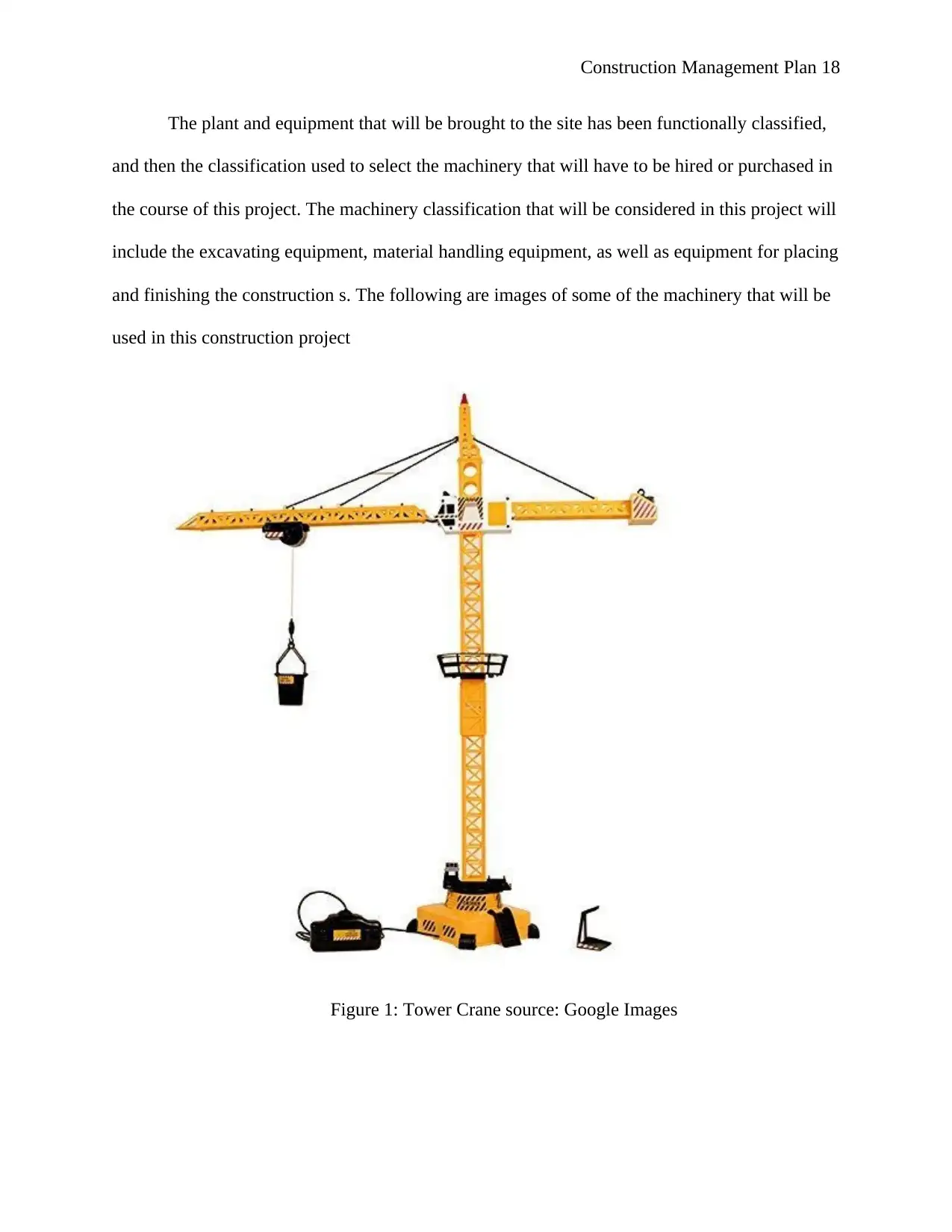
Construction Management Plan 18
The plant and equipment that will be brought to the site has been functionally classified,
and then the classification used to select the machinery that will have to be hired or purchased in
the course of this project. The machinery classification that will be considered in this project will
include the excavating equipment, material handling equipment, as well as equipment for placing
and finishing the construction s. The following are images of some of the machinery that will be
used in this construction project
Figure 1: Tower Crane source: Google Images
The plant and equipment that will be brought to the site has been functionally classified,
and then the classification used to select the machinery that will have to be hired or purchased in
the course of this project. The machinery classification that will be considered in this project will
include the excavating equipment, material handling equipment, as well as equipment for placing
and finishing the construction s. The following are images of some of the machinery that will be
used in this construction project
Figure 1: Tower Crane source: Google Images
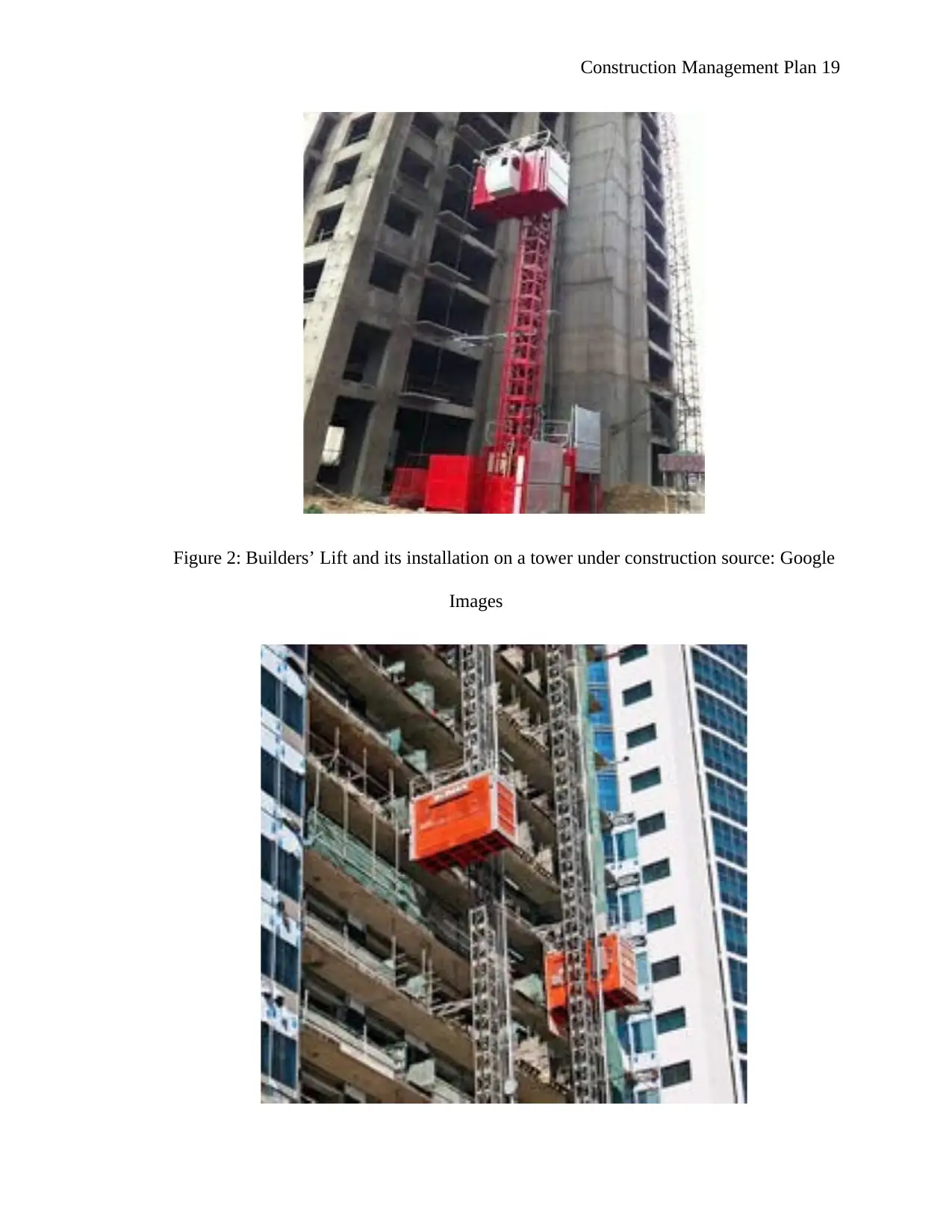
Construction Management Plan 19
Figure 2: Builders’ Lift and its installation on a tower under construction source: Google
Images
Figure 2: Builders’ Lift and its installation on a tower under construction source: Google
Images
Paraphrase This Document
Need a fresh take? Get an instant paraphrase of this document with our AI Paraphraser
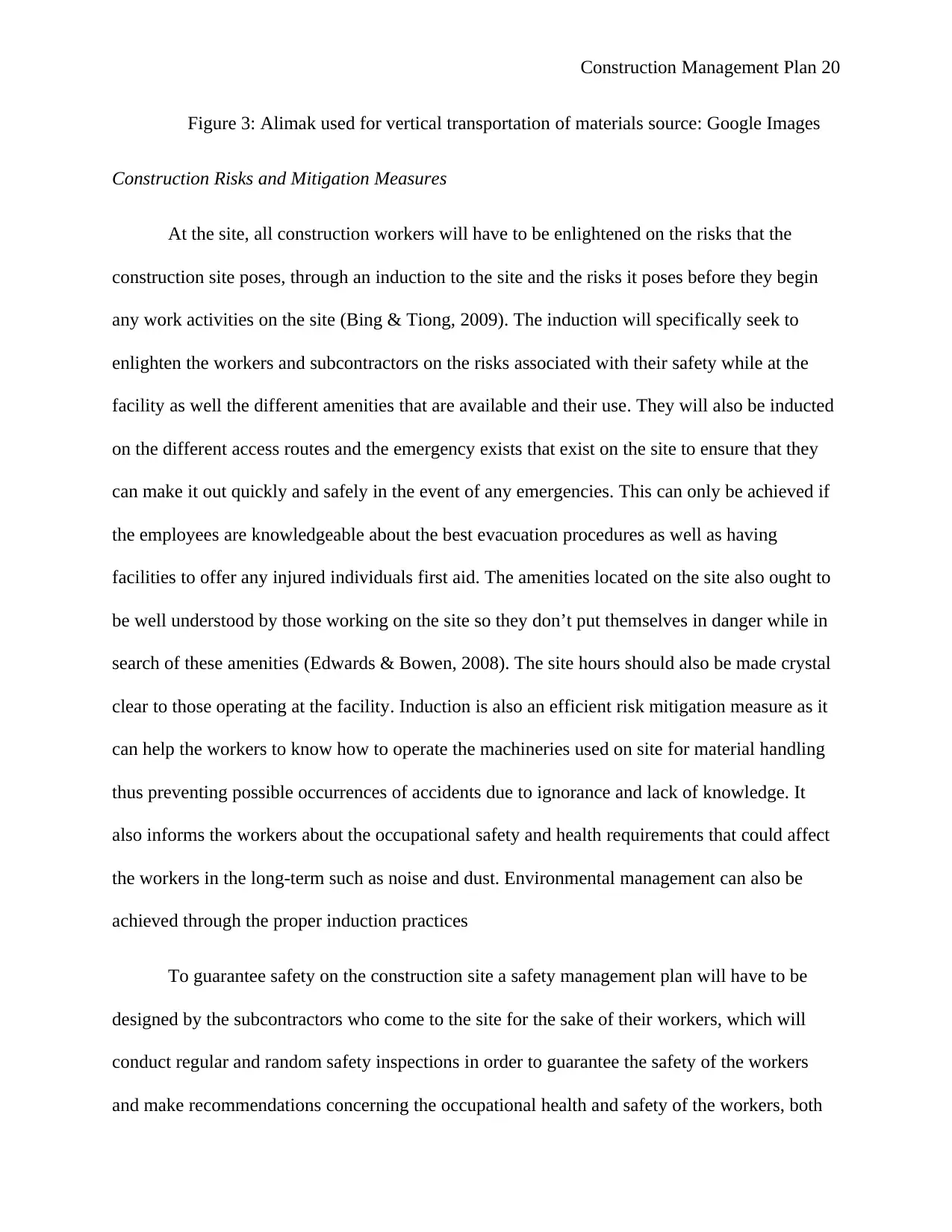
Construction Management Plan 20
Figure 3: Alimak used for vertical transportation of materials source: Google Images
Construction Risks and Mitigation Measures
At the site, all construction workers will have to be enlightened on the risks that the
construction site poses, through an induction to the site and the risks it poses before they begin
any work activities on the site (Bing & Tiong, 2009). The induction will specifically seek to
enlighten the workers and subcontractors on the risks associated with their safety while at the
facility as well the different amenities that are available and their use. They will also be inducted
on the different access routes and the emergency exists that exist on the site to ensure that they
can make it out quickly and safely in the event of any emergencies. This can only be achieved if
the employees are knowledgeable about the best evacuation procedures as well as having
facilities to offer any injured individuals first aid. The amenities located on the site also ought to
be well understood by those working on the site so they don’t put themselves in danger while in
search of these amenities (Edwards & Bowen, 2008). The site hours should also be made crystal
clear to those operating at the facility. Induction is also an efficient risk mitigation measure as it
can help the workers to know how to operate the machineries used on site for material handling
thus preventing possible occurrences of accidents due to ignorance and lack of knowledge. It
also informs the workers about the occupational safety and health requirements that could affect
the workers in the long-term such as noise and dust. Environmental management can also be
achieved through the proper induction practices
To guarantee safety on the construction site a safety management plan will have to be
designed by the subcontractors who come to the site for the sake of their workers, which will
conduct regular and random safety inspections in order to guarantee the safety of the workers
and make recommendations concerning the occupational health and safety of the workers, both
Figure 3: Alimak used for vertical transportation of materials source: Google Images
Construction Risks and Mitigation Measures
At the site, all construction workers will have to be enlightened on the risks that the
construction site poses, through an induction to the site and the risks it poses before they begin
any work activities on the site (Bing & Tiong, 2009). The induction will specifically seek to
enlighten the workers and subcontractors on the risks associated with their safety while at the
facility as well the different amenities that are available and their use. They will also be inducted
on the different access routes and the emergency exists that exist on the site to ensure that they
can make it out quickly and safely in the event of any emergencies. This can only be achieved if
the employees are knowledgeable about the best evacuation procedures as well as having
facilities to offer any injured individuals first aid. The amenities located on the site also ought to
be well understood by those working on the site so they don’t put themselves in danger while in
search of these amenities (Edwards & Bowen, 2008). The site hours should also be made crystal
clear to those operating at the facility. Induction is also an efficient risk mitigation measure as it
can help the workers to know how to operate the machineries used on site for material handling
thus preventing possible occurrences of accidents due to ignorance and lack of knowledge. It
also informs the workers about the occupational safety and health requirements that could affect
the workers in the long-term such as noise and dust. Environmental management can also be
achieved through the proper induction practices
To guarantee safety on the construction site a safety management plan will have to be
designed by the subcontractors who come to the site for the sake of their workers, which will
conduct regular and random safety inspections in order to guarantee the safety of the workers
and make recommendations concerning the occupational health and safety of the workers, both
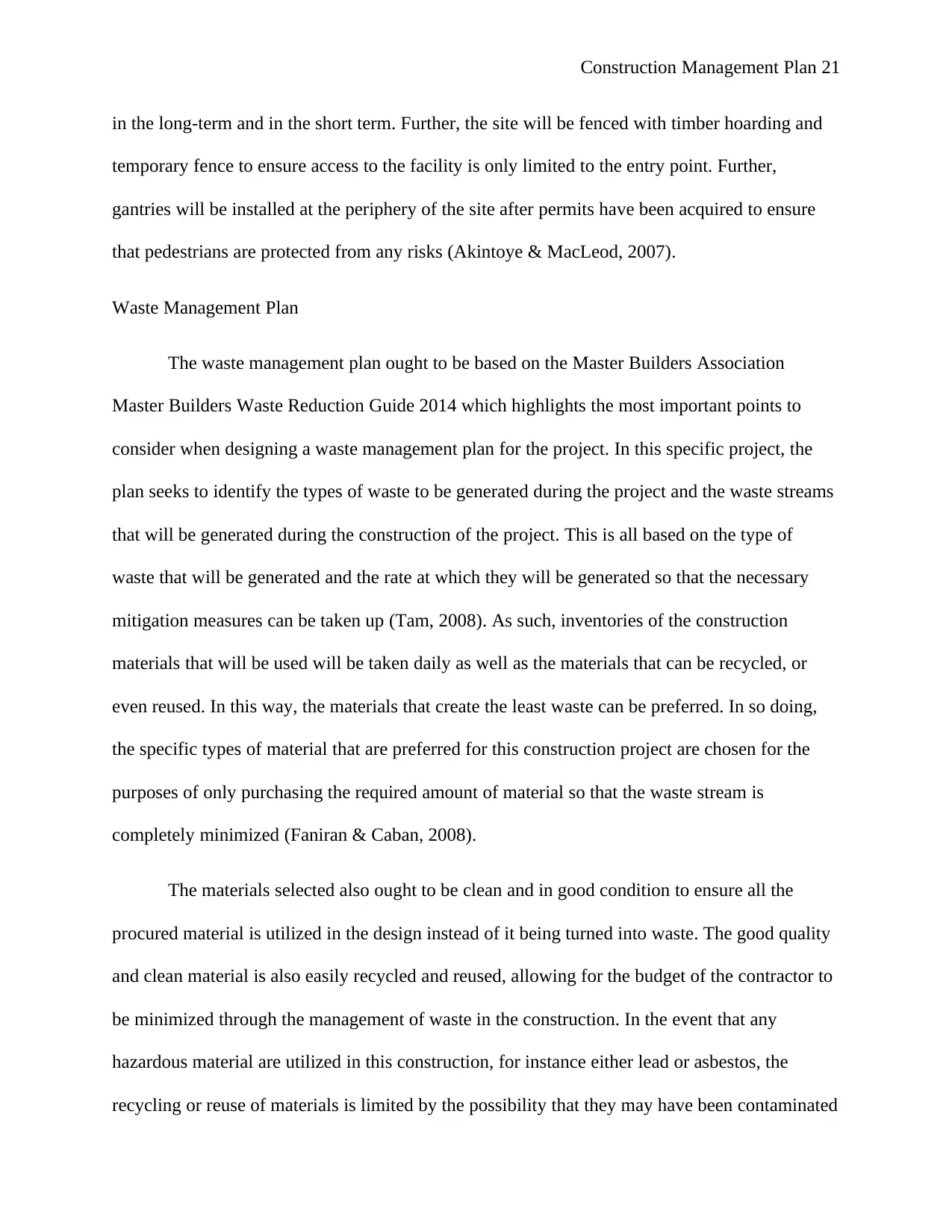
Construction Management Plan 21
in the long-term and in the short term. Further, the site will be fenced with timber hoarding and
temporary fence to ensure access to the facility is only limited to the entry point. Further,
gantries will be installed at the periphery of the site after permits have been acquired to ensure
that pedestrians are protected from any risks (Akintoye & MacLeod, 2007).
Waste Management Plan
The waste management plan ought to be based on the Master Builders Association
Master Builders Waste Reduction Guide 2014 which highlights the most important points to
consider when designing a waste management plan for the project. In this specific project, the
plan seeks to identify the types of waste to be generated during the project and the waste streams
that will be generated during the construction of the project. This is all based on the type of
waste that will be generated and the rate at which they will be generated so that the necessary
mitigation measures can be taken up (Tam, 2008). As such, inventories of the construction
materials that will be used will be taken daily as well as the materials that can be recycled, or
even reused. In this way, the materials that create the least waste can be preferred. In so doing,
the specific types of material that are preferred for this construction project are chosen for the
purposes of only purchasing the required amount of material so that the waste stream is
completely minimized (Faniran & Caban, 2008).
The materials selected also ought to be clean and in good condition to ensure all the
procured material is utilized in the design instead of it being turned into waste. The good quality
and clean material is also easily recycled and reused, allowing for the budget of the contractor to
be minimized through the management of waste in the construction. In the event that any
hazardous material are utilized in this construction, for instance either lead or asbestos, the
recycling or reuse of materials is limited by the possibility that they may have been contaminated
in the long-term and in the short term. Further, the site will be fenced with timber hoarding and
temporary fence to ensure access to the facility is only limited to the entry point. Further,
gantries will be installed at the periphery of the site after permits have been acquired to ensure
that pedestrians are protected from any risks (Akintoye & MacLeod, 2007).
Waste Management Plan
The waste management plan ought to be based on the Master Builders Association
Master Builders Waste Reduction Guide 2014 which highlights the most important points to
consider when designing a waste management plan for the project. In this specific project, the
plan seeks to identify the types of waste to be generated during the project and the waste streams
that will be generated during the construction of the project. This is all based on the type of
waste that will be generated and the rate at which they will be generated so that the necessary
mitigation measures can be taken up (Tam, 2008). As such, inventories of the construction
materials that will be used will be taken daily as well as the materials that can be recycled, or
even reused. In this way, the materials that create the least waste can be preferred. In so doing,
the specific types of material that are preferred for this construction project are chosen for the
purposes of only purchasing the required amount of material so that the waste stream is
completely minimized (Faniran & Caban, 2008).
The materials selected also ought to be clean and in good condition to ensure all the
procured material is utilized in the design instead of it being turned into waste. The good quality
and clean material is also easily recycled and reused, allowing for the budget of the contractor to
be minimized through the management of waste in the construction. In the event that any
hazardous material are utilized in this construction, for instance either lead or asbestos, the
recycling or reuse of materials is limited by the possibility that they may have been contaminated
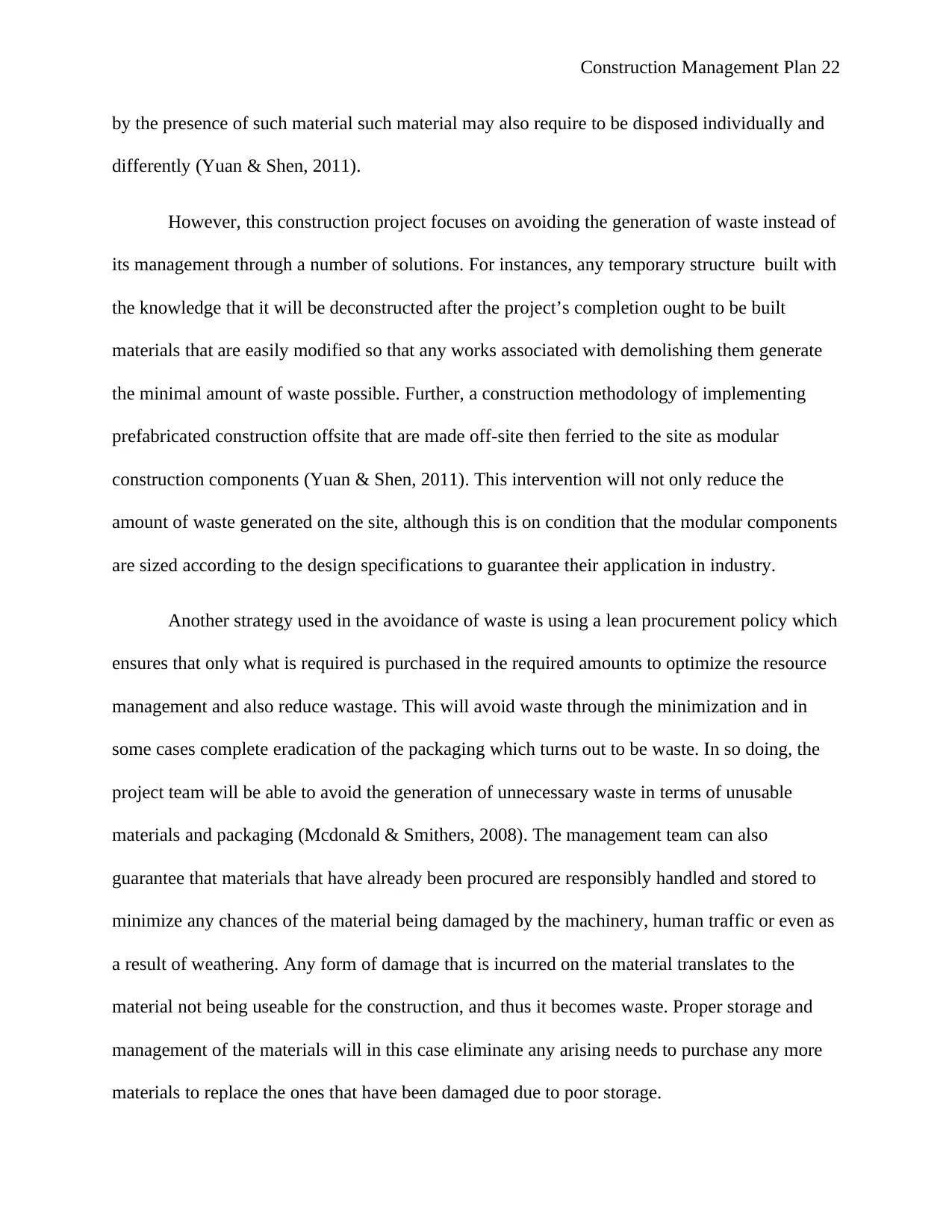
Construction Management Plan 22
by the presence of such material such material may also require to be disposed individually and
differently (Yuan & Shen, 2011).
However, this construction project focuses on avoiding the generation of waste instead of
its management through a number of solutions. For instances, any temporary structure built with
the knowledge that it will be deconstructed after the project’s completion ought to be built
materials that are easily modified so that any works associated with demolishing them generate
the minimal amount of waste possible. Further, a construction methodology of implementing
prefabricated construction offsite that are made off-site then ferried to the site as modular
construction components (Yuan & Shen, 2011). This intervention will not only reduce the
amount of waste generated on the site, although this is on condition that the modular components
are sized according to the design specifications to guarantee their application in industry.
Another strategy used in the avoidance of waste is using a lean procurement policy which
ensures that only what is required is purchased in the required amounts to optimize the resource
management and also reduce wastage. This will avoid waste through the minimization and in
some cases complete eradication of the packaging which turns out to be waste. In so doing, the
project team will be able to avoid the generation of unnecessary waste in terms of unusable
materials and packaging (Mcdonald & Smithers, 2008). The management team can also
guarantee that materials that have already been procured are responsibly handled and stored to
minimize any chances of the material being damaged by the machinery, human traffic or even as
a result of weathering. Any form of damage that is incurred on the material translates to the
material not being useable for the construction, and thus it becomes waste. Proper storage and
management of the materials will in this case eliminate any arising needs to purchase any more
materials to replace the ones that have been damaged due to poor storage.
by the presence of such material such material may also require to be disposed individually and
differently (Yuan & Shen, 2011).
However, this construction project focuses on avoiding the generation of waste instead of
its management through a number of solutions. For instances, any temporary structure built with
the knowledge that it will be deconstructed after the project’s completion ought to be built
materials that are easily modified so that any works associated with demolishing them generate
the minimal amount of waste possible. Further, a construction methodology of implementing
prefabricated construction offsite that are made off-site then ferried to the site as modular
construction components (Yuan & Shen, 2011). This intervention will not only reduce the
amount of waste generated on the site, although this is on condition that the modular components
are sized according to the design specifications to guarantee their application in industry.
Another strategy used in the avoidance of waste is using a lean procurement policy which
ensures that only what is required is purchased in the required amounts to optimize the resource
management and also reduce wastage. This will avoid waste through the minimization and in
some cases complete eradication of the packaging which turns out to be waste. In so doing, the
project team will be able to avoid the generation of unnecessary waste in terms of unusable
materials and packaging (Mcdonald & Smithers, 2008). The management team can also
guarantee that materials that have already been procured are responsibly handled and stored to
minimize any chances of the material being damaged by the machinery, human traffic or even as
a result of weathering. Any form of damage that is incurred on the material translates to the
material not being useable for the construction, and thus it becomes waste. Proper storage and
management of the materials will in this case eliminate any arising needs to purchase any more
materials to replace the ones that have been damaged due to poor storage.
Secure Best Marks with AI Grader
Need help grading? Try our AI Grader for instant feedback on your assignments.

Construction Management Plan 23
For the management of the little unavoidable waste that will be generated on the site, a
qualified service provider or contractor will be hired so they can provide waste disposal or other
waste management solutions for the streams of waste that will be generated. These contractors
are also very resourceful in providing insights for waste avoidance and waste recycling within
the site. The project team also ought to understand the principle of the waste management plan
through an induction so that it can facilitate the implementation of other waste management
solutions within the site such as placing bins in accessible places and teaching the stakeholders
how to use them. To prevent things from being accidentally disposed into the waste
management systems, storage management and organization is a key aspect which ensures that
material are stored appropriately and in easily accessible places to guarantee the safety of the
workers and the durability of the materials to prevent waste (Yuan, 2013). This also guarantees
the aesthetics of the material storage requirements so that they appear orderly and thus further
enforcing good condition of the materials and their cleanliness. Managing the waste on the site
will also call for the establishment of a waste collection system or plan to ensure that the hired
contractors collect the recyclable materials and the waste for different purposes regularly. This
will prevent the accumulation and build-up of wastes on the site.
During the construction, it is important for the project teams to delegate responsibilities
so that all those who enter the site premises are aware of how they play a part into the waste
management plan. It is also important for the project team to communicate with the other
stakeholders in order to get any feedback about the interventions that have been implemented
into the waste management plan and its effectiveness. Ensuring that all stakeholders of the site
are on board with regard to its application and the role that each one of them plays in ensuring its
effectiveness is also very vital in the effectiveness of a waste management plan. The team could
For the management of the little unavoidable waste that will be generated on the site, a
qualified service provider or contractor will be hired so they can provide waste disposal or other
waste management solutions for the streams of waste that will be generated. These contractors
are also very resourceful in providing insights for waste avoidance and waste recycling within
the site. The project team also ought to understand the principle of the waste management plan
through an induction so that it can facilitate the implementation of other waste management
solutions within the site such as placing bins in accessible places and teaching the stakeholders
how to use them. To prevent things from being accidentally disposed into the waste
management systems, storage management and organization is a key aspect which ensures that
material are stored appropriately and in easily accessible places to guarantee the safety of the
workers and the durability of the materials to prevent waste (Yuan, 2013). This also guarantees
the aesthetics of the material storage requirements so that they appear orderly and thus further
enforcing good condition of the materials and their cleanliness. Managing the waste on the site
will also call for the establishment of a waste collection system or plan to ensure that the hired
contractors collect the recyclable materials and the waste for different purposes regularly. This
will prevent the accumulation and build-up of wastes on the site.
During the construction, it is important for the project teams to delegate responsibilities
so that all those who enter the site premises are aware of how they play a part into the waste
management plan. It is also important for the project team to communicate with the other
stakeholders in order to get any feedback about the interventions that have been implemented
into the waste management plan and its effectiveness. Ensuring that all stakeholders of the site
are on board with regard to its application and the role that each one of them plays in ensuring its
effectiveness is also very vital in the effectiveness of a waste management plan. The team could
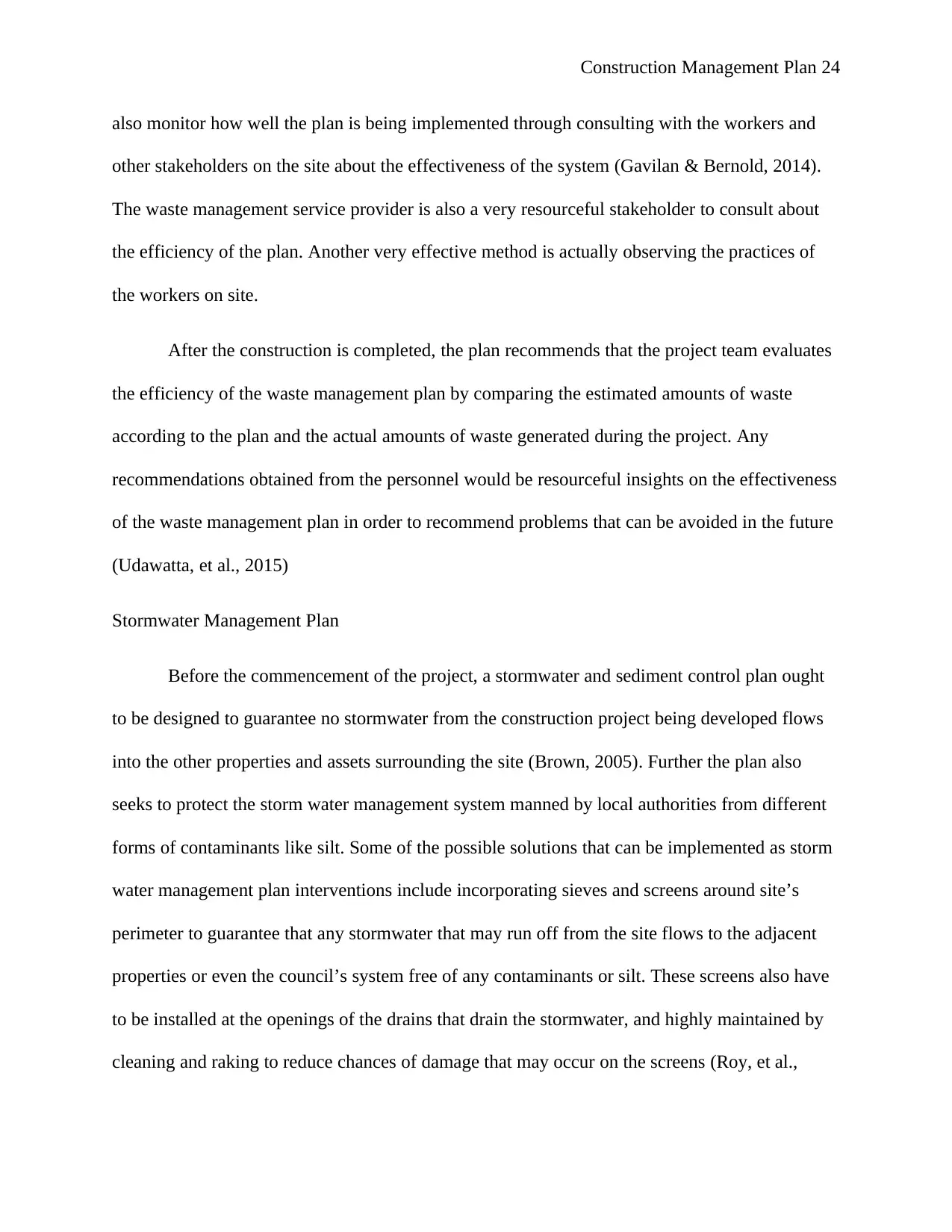
Construction Management Plan 24
also monitor how well the plan is being implemented through consulting with the workers and
other stakeholders on the site about the effectiveness of the system (Gavilan & Bernold, 2014).
The waste management service provider is also a very resourceful stakeholder to consult about
the efficiency of the plan. Another very effective method is actually observing the practices of
the workers on site.
After the construction is completed, the plan recommends that the project team evaluates
the efficiency of the waste management plan by comparing the estimated amounts of waste
according to the plan and the actual amounts of waste generated during the project. Any
recommendations obtained from the personnel would be resourceful insights on the effectiveness
of the waste management plan in order to recommend problems that can be avoided in the future
(Udawatta, et al., 2015)
Stormwater Management Plan
Before the commencement of the project, a stormwater and sediment control plan ought
to be designed to guarantee no stormwater from the construction project being developed flows
into the other properties and assets surrounding the site (Brown, 2005). Further the plan also
seeks to protect the storm water management system manned by local authorities from different
forms of contaminants like silt. Some of the possible solutions that can be implemented as storm
water management plan interventions include incorporating sieves and screens around site’s
perimeter to guarantee that any stormwater that may run off from the site flows to the adjacent
properties or even the council’s system free of any contaminants or silt. These screens also have
to be installed at the openings of the drains that drain the stormwater, and highly maintained by
cleaning and raking to reduce chances of damage that may occur on the screens (Roy, et al.,
also monitor how well the plan is being implemented through consulting with the workers and
other stakeholders on the site about the effectiveness of the system (Gavilan & Bernold, 2014).
The waste management service provider is also a very resourceful stakeholder to consult about
the efficiency of the plan. Another very effective method is actually observing the practices of
the workers on site.
After the construction is completed, the plan recommends that the project team evaluates
the efficiency of the waste management plan by comparing the estimated amounts of waste
according to the plan and the actual amounts of waste generated during the project. Any
recommendations obtained from the personnel would be resourceful insights on the effectiveness
of the waste management plan in order to recommend problems that can be avoided in the future
(Udawatta, et al., 2015)
Stormwater Management Plan
Before the commencement of the project, a stormwater and sediment control plan ought
to be designed to guarantee no stormwater from the construction project being developed flows
into the other properties and assets surrounding the site (Brown, 2005). Further the plan also
seeks to protect the storm water management system manned by local authorities from different
forms of contaminants like silt. Some of the possible solutions that can be implemented as storm
water management plan interventions include incorporating sieves and screens around site’s
perimeter to guarantee that any stormwater that may run off from the site flows to the adjacent
properties or even the council’s system free of any contaminants or silt. These screens also have
to be installed at the openings of the drains that drain the stormwater, and highly maintained by
cleaning and raking to reduce chances of damage that may occur on the screens (Roy, et al.,

Construction Management Plan 25
2008). This is due to the impact that any debris or contaminants caught by the sieves will have
on the condition of these mitigation measure.
As the construction progresses, slab drainage ought to be installed progressively with
every phase of the construction process in order direct the stormwater into the council drains
through the screens. This will guarantee that any silt or debris that is washed away with the storm
water is caught by the screen to ensure it does not make its way into the drains (Lloyd, et al.,
2002)
Traffic management
Traffic management will guarantee that the operation of roads remains reasonably
practical, such that the deliveries of the materials for the construction or even other construction
processes do not interfere with the transport system demands of the residents around the site and
other road users. The construction will adopt a strategy for the deliveries such that the materials
are only brought in when they are required on site which is commonly known as the just-in-time
strategy (Doody & Doody, 2003). This will ensure that no storage services are required on site to
prevent trucks coming to deliver materials and causing a snarl up of traffic that will affect the
residents and other road users.
During unloading, a number of precautions will be taken to guarantee that no workers or
pedestrians are caught up in the unloading bay when materials are being unloaded. This will be
achieved through guaranteeing minimized and highly monitored movement of materials to
ensure that no individual is kept at risk during unloading. In addition, all the personnel
authorized in the trucks used for the transportation of materials are to be having competent
people directing and helping vehicles to reverse. Further, during unloading of any materials
2008). This is due to the impact that any debris or contaminants caught by the sieves will have
on the condition of these mitigation measure.
As the construction progresses, slab drainage ought to be installed progressively with
every phase of the construction process in order direct the stormwater into the council drains
through the screens. This will guarantee that any silt or debris that is washed away with the storm
water is caught by the screen to ensure it does not make its way into the drains (Lloyd, et al.,
2002)
Traffic management
Traffic management will guarantee that the operation of roads remains reasonably
practical, such that the deliveries of the materials for the construction or even other construction
processes do not interfere with the transport system demands of the residents around the site and
other road users. The construction will adopt a strategy for the deliveries such that the materials
are only brought in when they are required on site which is commonly known as the just-in-time
strategy (Doody & Doody, 2003). This will ensure that no storage services are required on site to
prevent trucks coming to deliver materials and causing a snarl up of traffic that will affect the
residents and other road users.
During unloading, a number of precautions will be taken to guarantee that no workers or
pedestrians are caught up in the unloading bay when materials are being unloaded. This will be
achieved through guaranteeing minimized and highly monitored movement of materials to
ensure that no individual is kept at risk during unloading. In addition, all the personnel
authorized in the trucks used for the transportation of materials are to be having competent
people directing and helping vehicles to reverse. Further, during unloading of any materials
Paraphrase This Document
Need a fresh take? Get an instant paraphrase of this document with our AI Paraphraser
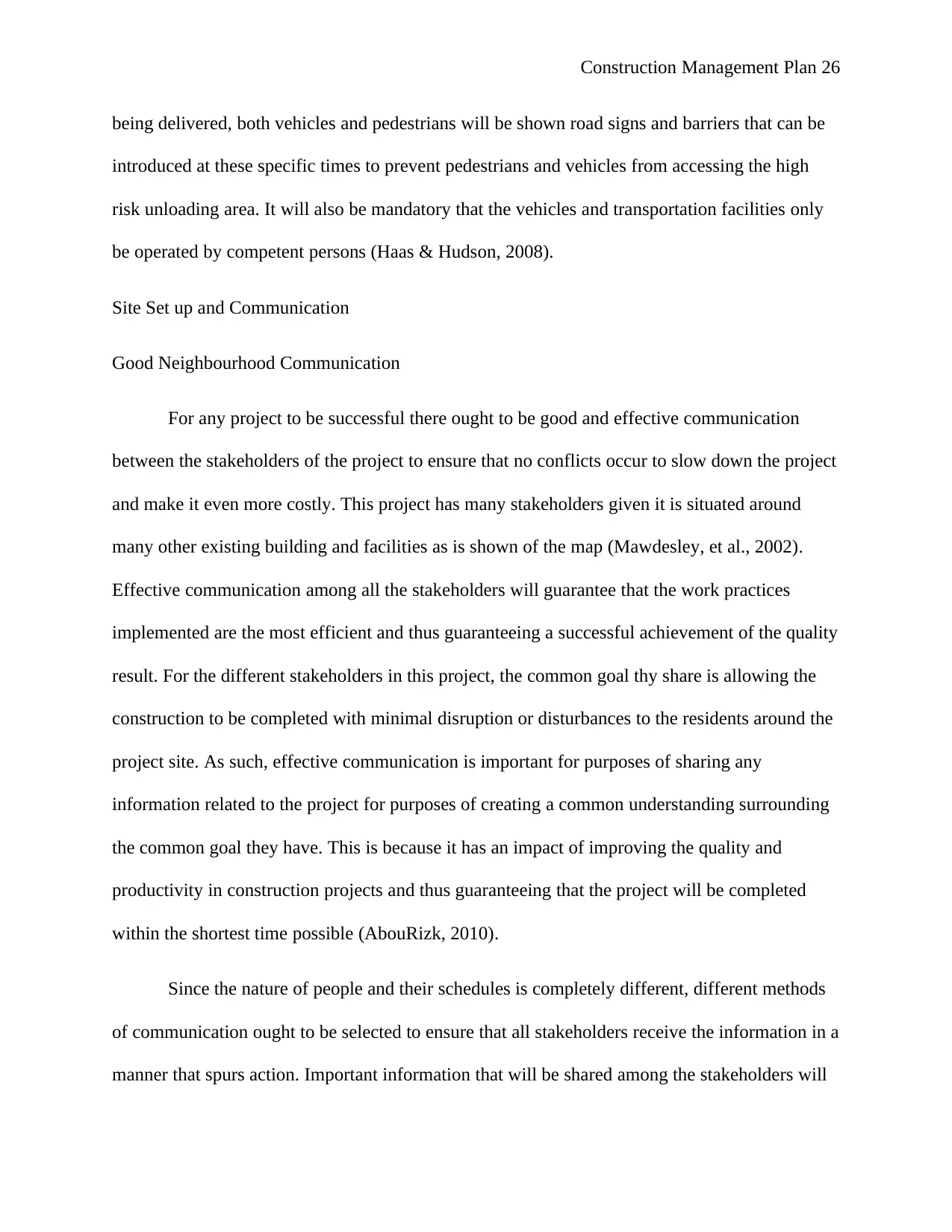
Construction Management Plan 26
being delivered, both vehicles and pedestrians will be shown road signs and barriers that can be
introduced at these specific times to prevent pedestrians and vehicles from accessing the high
risk unloading area. It will also be mandatory that the vehicles and transportation facilities only
be operated by competent persons (Haas & Hudson, 2008).
Site Set up and Communication
Good Neighbourhood Communication
For any project to be successful there ought to be good and effective communication
between the stakeholders of the project to ensure that no conflicts occur to slow down the project
and make it even more costly. This project has many stakeholders given it is situated around
many other existing building and facilities as is shown of the map (Mawdesley, et al., 2002).
Effective communication among all the stakeholders will guarantee that the work practices
implemented are the most efficient and thus guaranteeing a successful achievement of the quality
result. For the different stakeholders in this project, the common goal thy share is allowing the
construction to be completed with minimal disruption or disturbances to the residents around the
project site. As such, effective communication is important for purposes of sharing any
information related to the project for purposes of creating a common understanding surrounding
the common goal they have. This is because it has an impact of improving the quality and
productivity in construction projects and thus guaranteeing that the project will be completed
within the shortest time possible (AbouRizk, 2010).
Since the nature of people and their schedules is completely different, different methods
of communication ought to be selected to ensure that all stakeholders receive the information in a
manner that spurs action. Important information that will be shared among the stakeholders will
being delivered, both vehicles and pedestrians will be shown road signs and barriers that can be
introduced at these specific times to prevent pedestrians and vehicles from accessing the high
risk unloading area. It will also be mandatory that the vehicles and transportation facilities only
be operated by competent persons (Haas & Hudson, 2008).
Site Set up and Communication
Good Neighbourhood Communication
For any project to be successful there ought to be good and effective communication
between the stakeholders of the project to ensure that no conflicts occur to slow down the project
and make it even more costly. This project has many stakeholders given it is situated around
many other existing building and facilities as is shown of the map (Mawdesley, et al., 2002).
Effective communication among all the stakeholders will guarantee that the work practices
implemented are the most efficient and thus guaranteeing a successful achievement of the quality
result. For the different stakeholders in this project, the common goal thy share is allowing the
construction to be completed with minimal disruption or disturbances to the residents around the
project site. As such, effective communication is important for purposes of sharing any
information related to the project for purposes of creating a common understanding surrounding
the common goal they have. This is because it has an impact of improving the quality and
productivity in construction projects and thus guaranteeing that the project will be completed
within the shortest time possible (AbouRizk, 2010).
Since the nature of people and their schedules is completely different, different methods
of communication ought to be selected to ensure that all stakeholders receive the information in a
manner that spurs action. Important information that will be shared among the stakeholders will
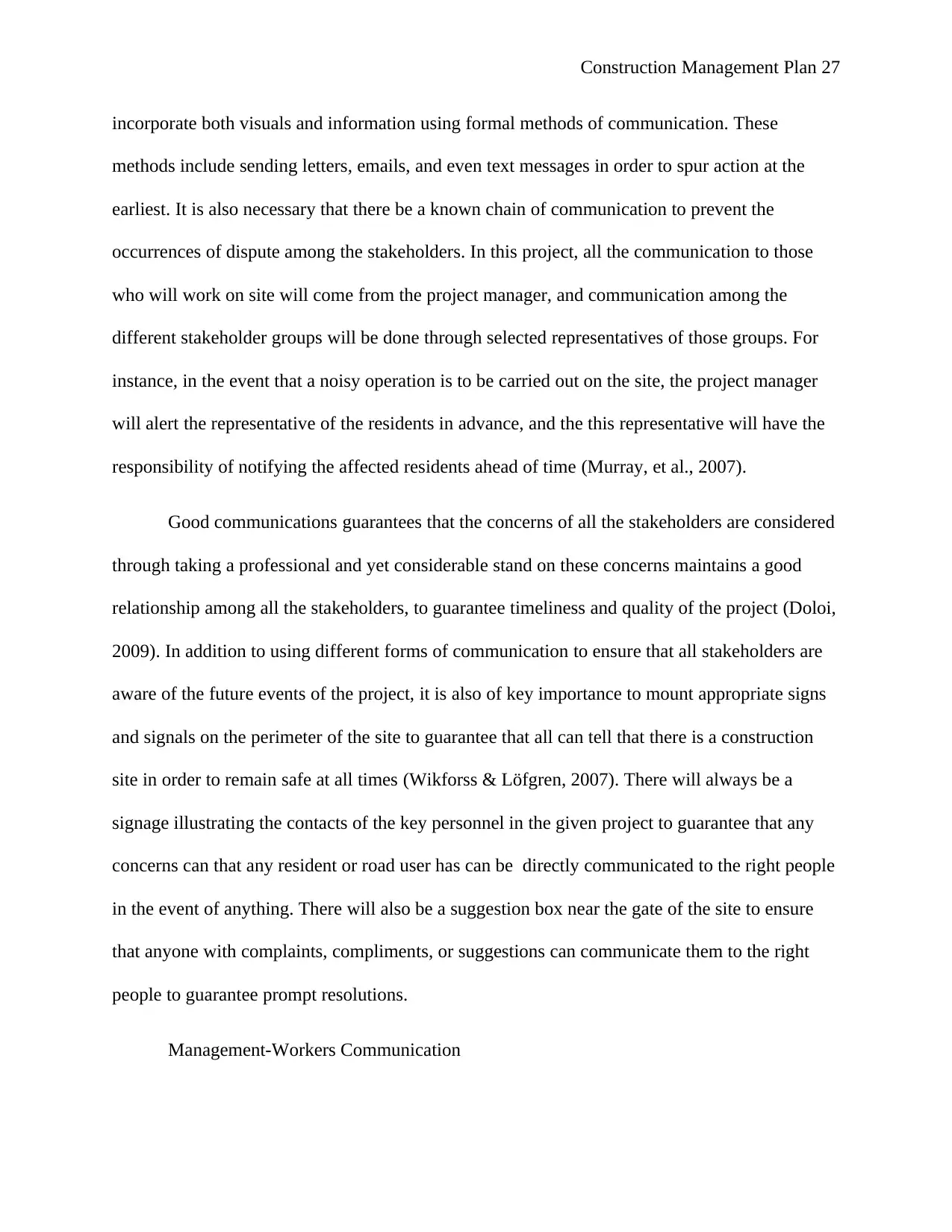
Construction Management Plan 27
incorporate both visuals and information using formal methods of communication. These
methods include sending letters, emails, and even text messages in order to spur action at the
earliest. It is also necessary that there be a known chain of communication to prevent the
occurrences of dispute among the stakeholders. In this project, all the communication to those
who will work on site will come from the project manager, and communication among the
different stakeholder groups will be done through selected representatives of those groups. For
instance, in the event that a noisy operation is to be carried out on the site, the project manager
will alert the representative of the residents in advance, and the this representative will have the
responsibility of notifying the affected residents ahead of time (Murray, et al., 2007).
Good communications guarantees that the concerns of all the stakeholders are considered
through taking a professional and yet considerable stand on these concerns maintains a good
relationship among all the stakeholders, to guarantee timeliness and quality of the project (Doloi,
2009). In addition to using different forms of communication to ensure that all stakeholders are
aware of the future events of the project, it is also of key importance to mount appropriate signs
and signals on the perimeter of the site to guarantee that all can tell that there is a construction
site in order to remain safe at all times (Wikforss & Löfgren, 2007). There will always be a
signage illustrating the contacts of the key personnel in the given project to guarantee that any
concerns can that any resident or road user has can be directly communicated to the right people
in the event of anything. There will also be a suggestion box near the gate of the site to ensure
that anyone with complaints, compliments, or suggestions can communicate them to the right
people to guarantee prompt resolutions.
Management-Workers Communication
incorporate both visuals and information using formal methods of communication. These
methods include sending letters, emails, and even text messages in order to spur action at the
earliest. It is also necessary that there be a known chain of communication to prevent the
occurrences of dispute among the stakeholders. In this project, all the communication to those
who will work on site will come from the project manager, and communication among the
different stakeholder groups will be done through selected representatives of those groups. For
instance, in the event that a noisy operation is to be carried out on the site, the project manager
will alert the representative of the residents in advance, and the this representative will have the
responsibility of notifying the affected residents ahead of time (Murray, et al., 2007).
Good communications guarantees that the concerns of all the stakeholders are considered
through taking a professional and yet considerable stand on these concerns maintains a good
relationship among all the stakeholders, to guarantee timeliness and quality of the project (Doloi,
2009). In addition to using different forms of communication to ensure that all stakeholders are
aware of the future events of the project, it is also of key importance to mount appropriate signs
and signals on the perimeter of the site to guarantee that all can tell that there is a construction
site in order to remain safe at all times (Wikforss & Löfgren, 2007). There will always be a
signage illustrating the contacts of the key personnel in the given project to guarantee that any
concerns can that any resident or road user has can be directly communicated to the right people
in the event of anything. There will also be a suggestion box near the gate of the site to ensure
that anyone with complaints, compliments, or suggestions can communicate them to the right
people to guarantee prompt resolutions.
Management-Workers Communication
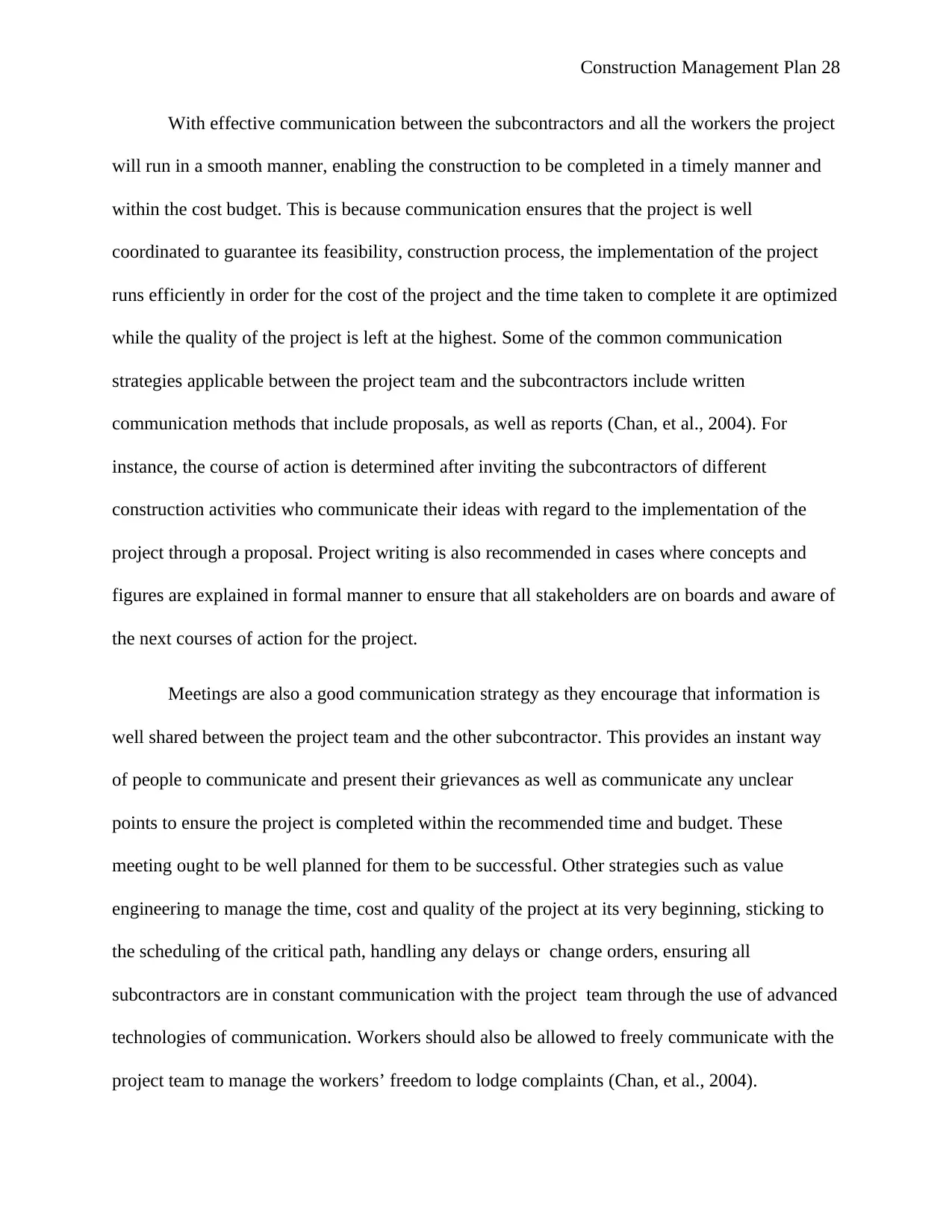
Construction Management Plan 28
With effective communication between the subcontractors and all the workers the project
will run in a smooth manner, enabling the construction to be completed in a timely manner and
within the cost budget. This is because communication ensures that the project is well
coordinated to guarantee its feasibility, construction process, the implementation of the project
runs efficiently in order for the cost of the project and the time taken to complete it are optimized
while the quality of the project is left at the highest. Some of the common communication
strategies applicable between the project team and the subcontractors include written
communication methods that include proposals, as well as reports (Chan, et al., 2004). For
instance, the course of action is determined after inviting the subcontractors of different
construction activities who communicate their ideas with regard to the implementation of the
project through a proposal. Project writing is also recommended in cases where concepts and
figures are explained in formal manner to ensure that all stakeholders are on boards and aware of
the next courses of action for the project.
Meetings are also a good communication strategy as they encourage that information is
well shared between the project team and the other subcontractor. This provides an instant way
of people to communicate and present their grievances as well as communicate any unclear
points to ensure the project is completed within the recommended time and budget. These
meeting ought to be well planned for them to be successful. Other strategies such as value
engineering to manage the time, cost and quality of the project at its very beginning, sticking to
the scheduling of the critical path, handling any delays or change orders, ensuring all
subcontractors are in constant communication with the project team through the use of advanced
technologies of communication. Workers should also be allowed to freely communicate with the
project team to manage the workers’ freedom to lodge complaints (Chan, et al., 2004).
With effective communication between the subcontractors and all the workers the project
will run in a smooth manner, enabling the construction to be completed in a timely manner and
within the cost budget. This is because communication ensures that the project is well
coordinated to guarantee its feasibility, construction process, the implementation of the project
runs efficiently in order for the cost of the project and the time taken to complete it are optimized
while the quality of the project is left at the highest. Some of the common communication
strategies applicable between the project team and the subcontractors include written
communication methods that include proposals, as well as reports (Chan, et al., 2004). For
instance, the course of action is determined after inviting the subcontractors of different
construction activities who communicate their ideas with regard to the implementation of the
project through a proposal. Project writing is also recommended in cases where concepts and
figures are explained in formal manner to ensure that all stakeholders are on boards and aware of
the next courses of action for the project.
Meetings are also a good communication strategy as they encourage that information is
well shared between the project team and the other subcontractor. This provides an instant way
of people to communicate and present their grievances as well as communicate any unclear
points to ensure the project is completed within the recommended time and budget. These
meeting ought to be well planned for them to be successful. Other strategies such as value
engineering to manage the time, cost and quality of the project at its very beginning, sticking to
the scheduling of the critical path, handling any delays or change orders, ensuring all
subcontractors are in constant communication with the project team through the use of advanced
technologies of communication. Workers should also be allowed to freely communicate with the
project team to manage the workers’ freedom to lodge complaints (Chan, et al., 2004).
Secure Best Marks with AI Grader
Need help grading? Try our AI Grader for instant feedback on your assignments.
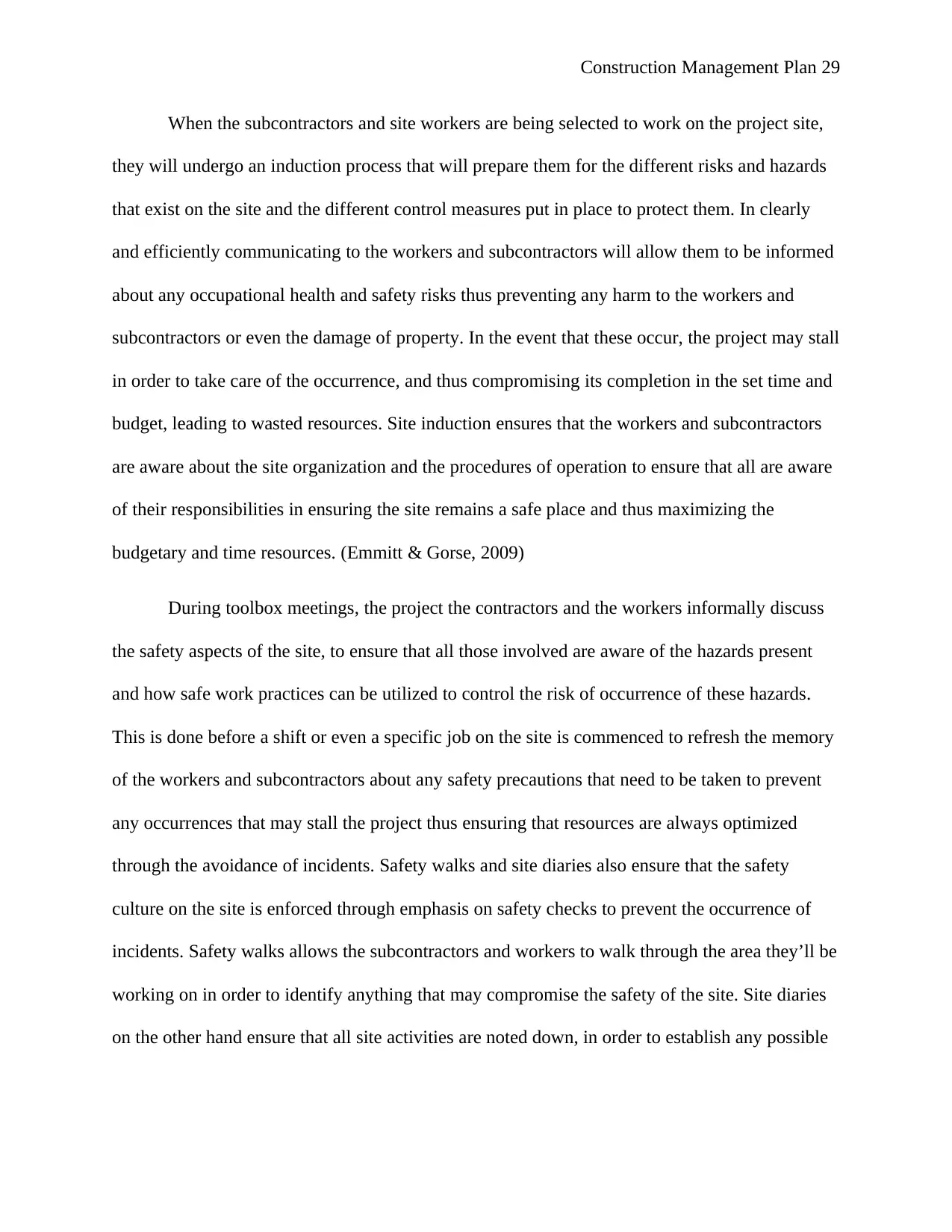
Construction Management Plan 29
When the subcontractors and site workers are being selected to work on the project site,
they will undergo an induction process that will prepare them for the different risks and hazards
that exist on the site and the different control measures put in place to protect them. In clearly
and efficiently communicating to the workers and subcontractors will allow them to be informed
about any occupational health and safety risks thus preventing any harm to the workers and
subcontractors or even the damage of property. In the event that these occur, the project may stall
in order to take care of the occurrence, and thus compromising its completion in the set time and
budget, leading to wasted resources. Site induction ensures that the workers and subcontractors
are aware about the site organization and the procedures of operation to ensure that all are aware
of their responsibilities in ensuring the site remains a safe place and thus maximizing the
budgetary and time resources. (Emmitt & Gorse, 2009)
During toolbox meetings, the project the contractors and the workers informally discuss
the safety aspects of the site, to ensure that all those involved are aware of the hazards present
and how safe work practices can be utilized to control the risk of occurrence of these hazards.
This is done before a shift or even a specific job on the site is commenced to refresh the memory
of the workers and subcontractors about any safety precautions that need to be taken to prevent
any occurrences that may stall the project thus ensuring that resources are always optimized
through the avoidance of incidents. Safety walks and site diaries also ensure that the safety
culture on the site is enforced through emphasis on safety checks to prevent the occurrence of
incidents. Safety walks allows the subcontractors and workers to walk through the area they’ll be
working on in order to identify anything that may compromise the safety of the site. Site diaries
on the other hand ensure that all site activities are noted down, in order to establish any possible
When the subcontractors and site workers are being selected to work on the project site,
they will undergo an induction process that will prepare them for the different risks and hazards
that exist on the site and the different control measures put in place to protect them. In clearly
and efficiently communicating to the workers and subcontractors will allow them to be informed
about any occupational health and safety risks thus preventing any harm to the workers and
subcontractors or even the damage of property. In the event that these occur, the project may stall
in order to take care of the occurrence, and thus compromising its completion in the set time and
budget, leading to wasted resources. Site induction ensures that the workers and subcontractors
are aware about the site organization and the procedures of operation to ensure that all are aware
of their responsibilities in ensuring the site remains a safe place and thus maximizing the
budgetary and time resources. (Emmitt & Gorse, 2009)
During toolbox meetings, the project the contractors and the workers informally discuss
the safety aspects of the site, to ensure that all those involved are aware of the hazards present
and how safe work practices can be utilized to control the risk of occurrence of these hazards.
This is done before a shift or even a specific job on the site is commenced to refresh the memory
of the workers and subcontractors about any safety precautions that need to be taken to prevent
any occurrences that may stall the project thus ensuring that resources are always optimized
through the avoidance of incidents. Safety walks and site diaries also ensure that the safety
culture on the site is enforced through emphasis on safety checks to prevent the occurrence of
incidents. Safety walks allows the subcontractors and workers to walk through the area they’ll be
working on in order to identify anything that may compromise the safety of the site. Site diaries
on the other hand ensure that all site activities are noted down, in order to establish any possible
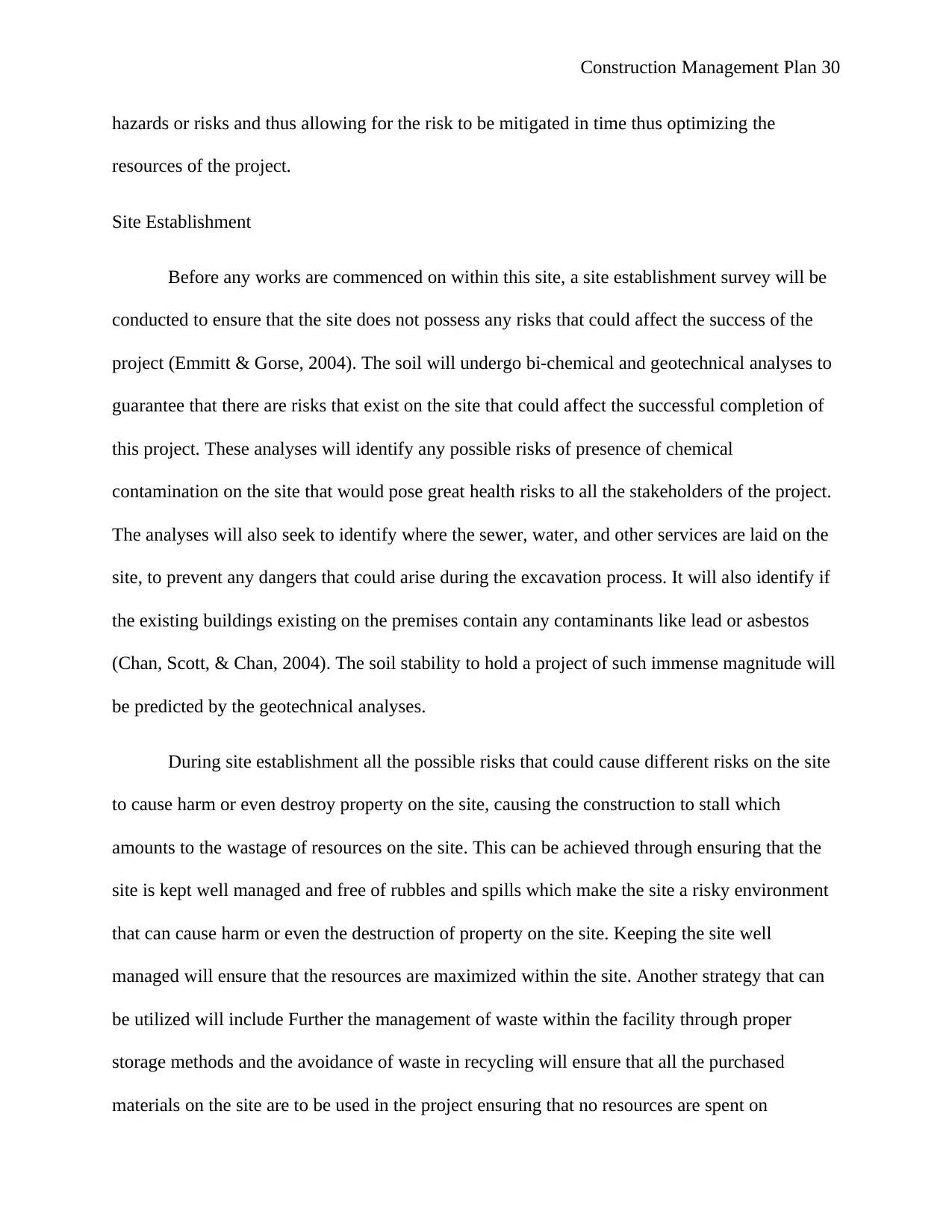
Construction Management Plan 30
hazards or risks and thus allowing for the risk to be mitigated in time thus optimizing the
resources of the project.
Site Establishment
Before any works are commenced on within this site, a site establishment survey will be
conducted to ensure that the site does not possess any risks that could affect the success of the
project (Emmitt & Gorse, 2004). The soil will undergo bi-chemical and geotechnical analyses to
guarantee that there are risks that exist on the site that could affect the successful completion of
this project. These analyses will identify any possible risks of presence of chemical
contamination on the site that would pose great health risks to all the stakeholders of the project.
The analyses will also seek to identify where the sewer, water, and other services are laid on the
site, to prevent any dangers that could arise during the excavation process. It will also identify if
the existing buildings existing on the premises contain any contaminants like lead or asbestos
(Chan, Scott, & Chan, 2004). The soil stability to hold a project of such immense magnitude will
be predicted by the geotechnical analyses.
During site establishment all the possible risks that could cause different risks on the site
to cause harm or even destroy property on the site, causing the construction to stall which
amounts to the wastage of resources on the site. This can be achieved through ensuring that the
site is kept well managed and free of rubbles and spills which make the site a risky environment
that can cause harm or even the destruction of property on the site. Keeping the site well
managed will ensure that the resources are maximized within the site. Another strategy that can
be utilized will include Further the management of waste within the facility through proper
storage methods and the avoidance of waste in recycling will ensure that all the purchased
materials on the site are to be used in the project ensuring that no resources are spent on
hazards or risks and thus allowing for the risk to be mitigated in time thus optimizing the
resources of the project.
Site Establishment
Before any works are commenced on within this site, a site establishment survey will be
conducted to ensure that the site does not possess any risks that could affect the success of the
project (Emmitt & Gorse, 2004). The soil will undergo bi-chemical and geotechnical analyses to
guarantee that there are risks that exist on the site that could affect the successful completion of
this project. These analyses will identify any possible risks of presence of chemical
contamination on the site that would pose great health risks to all the stakeholders of the project.
The analyses will also seek to identify where the sewer, water, and other services are laid on the
site, to prevent any dangers that could arise during the excavation process. It will also identify if
the existing buildings existing on the premises contain any contaminants like lead or asbestos
(Chan, Scott, & Chan, 2004). The soil stability to hold a project of such immense magnitude will
be predicted by the geotechnical analyses.
During site establishment all the possible risks that could cause different risks on the site
to cause harm or even destroy property on the site, causing the construction to stall which
amounts to the wastage of resources on the site. This can be achieved through ensuring that the
site is kept well managed and free of rubbles and spills which make the site a risky environment
that can cause harm or even the destruction of property on the site. Keeping the site well
managed will ensure that the resources are maximized within the site. Another strategy that can
be utilized will include Further the management of waste within the facility through proper
storage methods and the avoidance of waste in recycling will ensure that all the purchased
materials on the site are to be used in the project ensuring that no resources are spent on
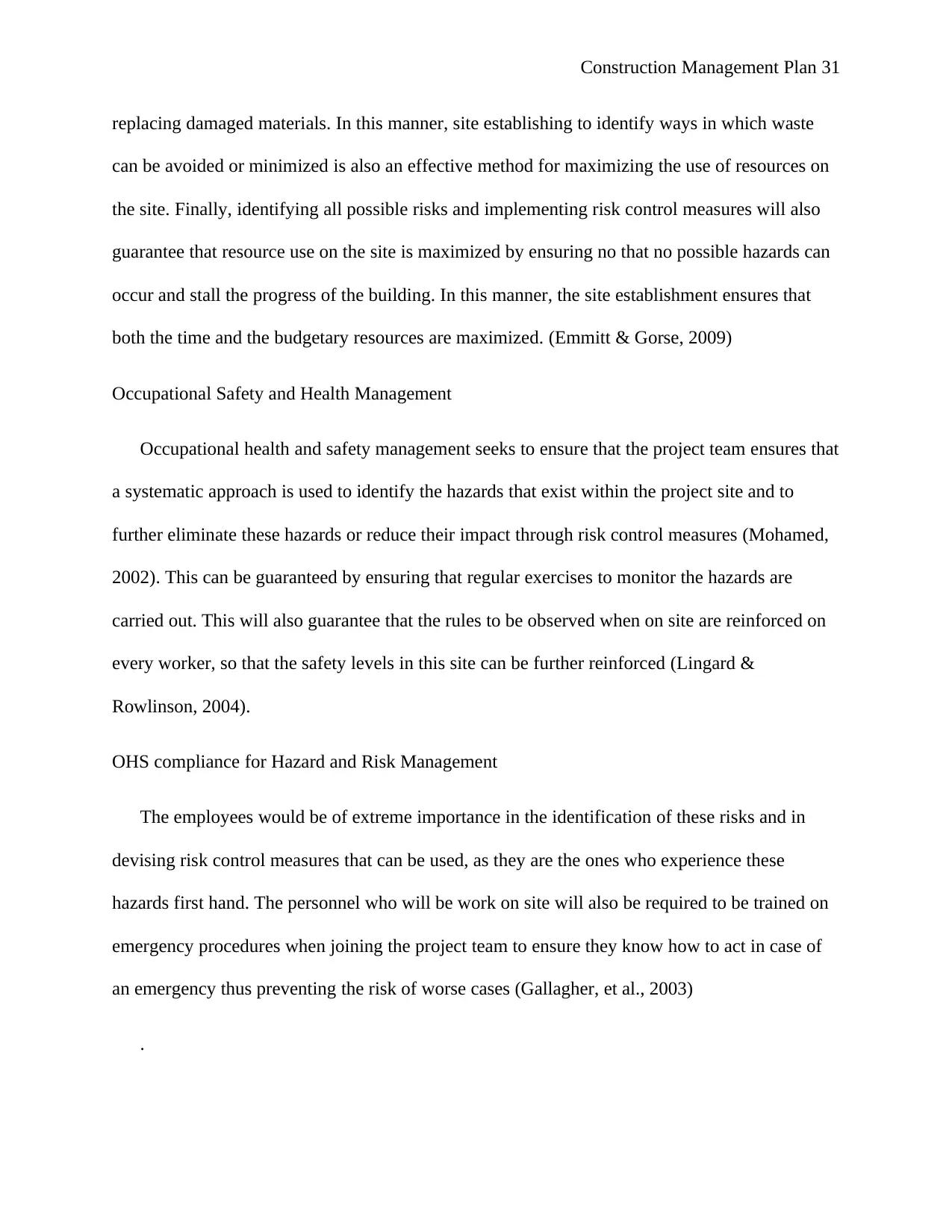
Construction Management Plan 31
replacing damaged materials. In this manner, site establishing to identify ways in which waste
can be avoided or minimized is also an effective method for maximizing the use of resources on
the site. Finally, identifying all possible risks and implementing risk control measures will also
guarantee that resource use on the site is maximized by ensuring no that no possible hazards can
occur and stall the progress of the building. In this manner, the site establishment ensures that
both the time and the budgetary resources are maximized. (Emmitt & Gorse, 2009)
Occupational Safety and Health Management
Occupational health and safety management seeks to ensure that the project team ensures that
a systematic approach is used to identify the hazards that exist within the project site and to
further eliminate these hazards or reduce their impact through risk control measures (Mohamed,
2002). This can be guaranteed by ensuring that regular exercises to monitor the hazards are
carried out. This will also guarantee that the rules to be observed when on site are reinforced on
every worker, so that the safety levels in this site can be further reinforced (Lingard &
Rowlinson, 2004).
OHS compliance for Hazard and Risk Management
The employees would be of extreme importance in the identification of these risks and in
devising risk control measures that can be used, as they are the ones who experience these
hazards first hand. The personnel who will be work on site will also be required to be trained on
emergency procedures when joining the project team to ensure they know how to act in case of
an emergency thus preventing the risk of worse cases (Gallagher, et al., 2003)
.
replacing damaged materials. In this manner, site establishing to identify ways in which waste
can be avoided or minimized is also an effective method for maximizing the use of resources on
the site. Finally, identifying all possible risks and implementing risk control measures will also
guarantee that resource use on the site is maximized by ensuring no that no possible hazards can
occur and stall the progress of the building. In this manner, the site establishment ensures that
both the time and the budgetary resources are maximized. (Emmitt & Gorse, 2009)
Occupational Safety and Health Management
Occupational health and safety management seeks to ensure that the project team ensures that
a systematic approach is used to identify the hazards that exist within the project site and to
further eliminate these hazards or reduce their impact through risk control measures (Mohamed,
2002). This can be guaranteed by ensuring that regular exercises to monitor the hazards are
carried out. This will also guarantee that the rules to be observed when on site are reinforced on
every worker, so that the safety levels in this site can be further reinforced (Lingard &
Rowlinson, 2004).
OHS compliance for Hazard and Risk Management
The employees would be of extreme importance in the identification of these risks and in
devising risk control measures that can be used, as they are the ones who experience these
hazards first hand. The personnel who will be work on site will also be required to be trained on
emergency procedures when joining the project team to ensure they know how to act in case of
an emergency thus preventing the risk of worse cases (Gallagher, et al., 2003)
.
Paraphrase This Document
Need a fresh take? Get an instant paraphrase of this document with our AI Paraphraser

Construction Management Plan 32
Further, the project team will ensure that the property is completely fenced with timber
hoarding or other forms of resilient erections to prevent any occurrences of incidences caused by
materials falling outside the project site and posing a threat to the residents of the neighbouring
area. Further, the team also ought to have installed safety signage indicating that the area is a
construction site to encourage people outside the site and the workers to be aware of any risks
that could occur in the vicinity of this area (Sanchez, et al., 2017). This guarantees that people
remain vigilant and are able to protect themselves in the event of an incident.
Services within the site like electricity which may pose the risk of electrocuting anyone
who is not aware will also be eliminated by terminating the transmission of the line to remove
any possible cases of injury or damage. Ensuring the recycling of materials also guarantees that
the occupational health and safety of the workers is guaranteed by reducing the amount of waste
generated from the site (Teo & Ling, 2006). Following the correct procedure of construction
activities will also be mandatory to ensure that any possible incidences do not occur as a result of
ignorance. The adjacent buildings will also be protected to ensure no hazards from the project
site can spread the risks to the adjacent buildings thus guaranteeing safety for the residents of the
neighbouring community. All parts of the building will have to be left in a safe state after the
construction has been completed to ensure no hazards on the project site can risk the damage of
property or harm to those who reside near the site. Finally any cases of rabbles or pebbles on the
construction site will be quickly cleaned to guarantee that hazards related to falls are minimized
through great house-keeping (Koehn & Datta, 2003).
OHS compliance for Emergency and Fire Situations
In emergency cases such as the occurrences of fires, the contacts and the names of the
project team will be placed at the entrance of the site to allow people to notify the right people
Further, the project team will ensure that the property is completely fenced with timber
hoarding or other forms of resilient erections to prevent any occurrences of incidences caused by
materials falling outside the project site and posing a threat to the residents of the neighbouring
area. Further, the team also ought to have installed safety signage indicating that the area is a
construction site to encourage people outside the site and the workers to be aware of any risks
that could occur in the vicinity of this area (Sanchez, et al., 2017). This guarantees that people
remain vigilant and are able to protect themselves in the event of an incident.
Services within the site like electricity which may pose the risk of electrocuting anyone
who is not aware will also be eliminated by terminating the transmission of the line to remove
any possible cases of injury or damage. Ensuring the recycling of materials also guarantees that
the occupational health and safety of the workers is guaranteed by reducing the amount of waste
generated from the site (Teo & Ling, 2006). Following the correct procedure of construction
activities will also be mandatory to ensure that any possible incidences do not occur as a result of
ignorance. The adjacent buildings will also be protected to ensure no hazards from the project
site can spread the risks to the adjacent buildings thus guaranteeing safety for the residents of the
neighbouring community. All parts of the building will have to be left in a safe state after the
construction has been completed to ensure no hazards on the project site can risk the damage of
property or harm to those who reside near the site. Finally any cases of rabbles or pebbles on the
construction site will be quickly cleaned to guarantee that hazards related to falls are minimized
through great house-keeping (Koehn & Datta, 2003).
OHS compliance for Emergency and Fire Situations
In emergency cases such as the occurrences of fires, the contacts and the names of the
project team will be placed at the entrance of the site to allow people to notify the right people
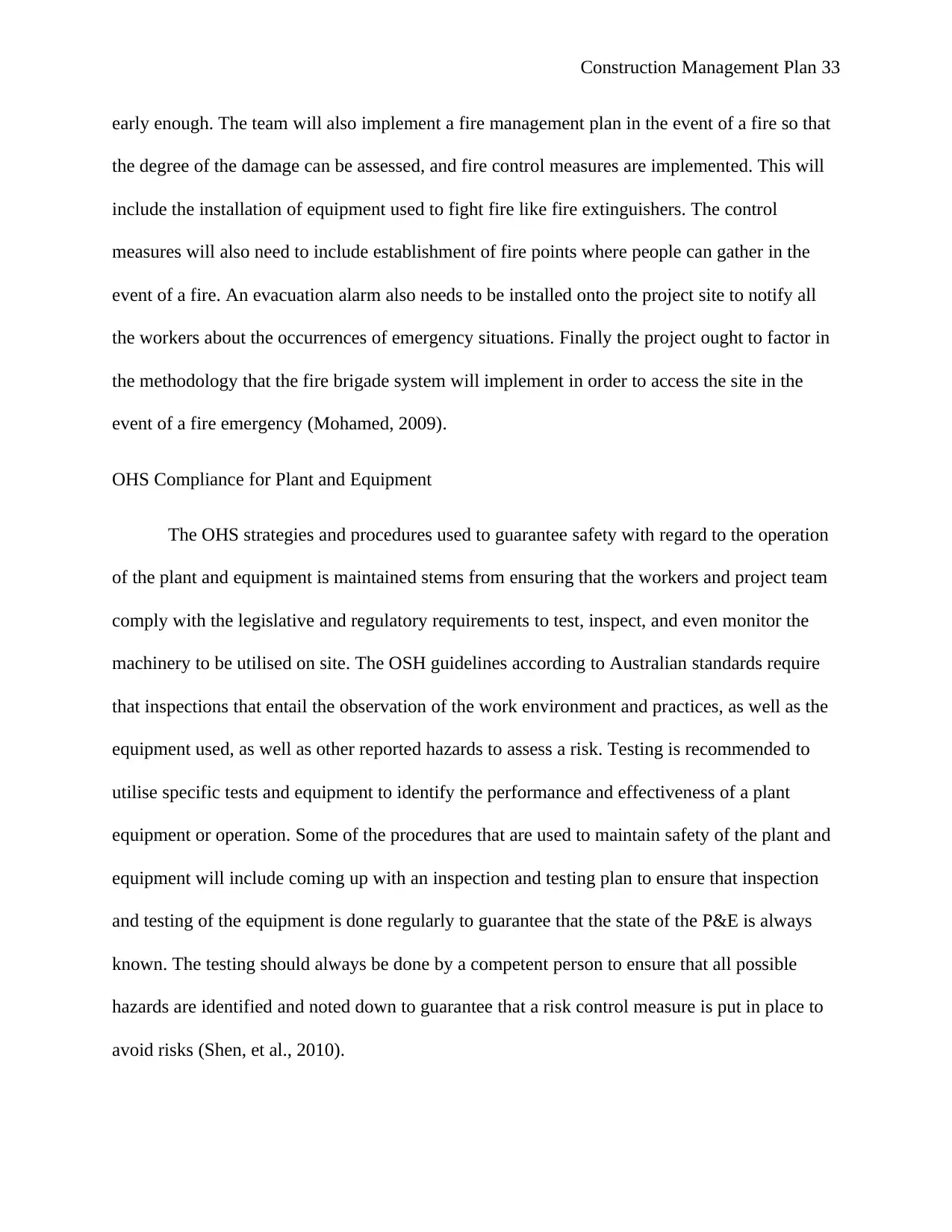
Construction Management Plan 33
early enough. The team will also implement a fire management plan in the event of a fire so that
the degree of the damage can be assessed, and fire control measures are implemented. This will
include the installation of equipment used to fight fire like fire extinguishers. The control
measures will also need to include establishment of fire points where people can gather in the
event of a fire. An evacuation alarm also needs to be installed onto the project site to notify all
the workers about the occurrences of emergency situations. Finally the project ought to factor in
the methodology that the fire brigade system will implement in order to access the site in the
event of a fire emergency (Mohamed, 2009).
OHS Compliance for Plant and Equipment
The OHS strategies and procedures used to guarantee safety with regard to the operation
of the plant and equipment is maintained stems from ensuring that the workers and project team
comply with the legislative and regulatory requirements to test, inspect, and even monitor the
machinery to be utilised on site. The OSH guidelines according to Australian standards require
that inspections that entail the observation of the work environment and practices, as well as the
equipment used, as well as other reported hazards to assess a risk. Testing is recommended to
utilise specific tests and equipment to identify the performance and effectiveness of a plant
equipment or operation. Some of the procedures that are used to maintain safety of the plant and
equipment will include coming up with an inspection and testing plan to ensure that inspection
and testing of the equipment is done regularly to guarantee that the state of the P&E is always
known. The testing should always be done by a competent person to ensure that all possible
hazards are identified and noted down to guarantee that a risk control measure is put in place to
avoid risks (Shen, et al., 2010).
early enough. The team will also implement a fire management plan in the event of a fire so that
the degree of the damage can be assessed, and fire control measures are implemented. This will
include the installation of equipment used to fight fire like fire extinguishers. The control
measures will also need to include establishment of fire points where people can gather in the
event of a fire. An evacuation alarm also needs to be installed onto the project site to notify all
the workers about the occurrences of emergency situations. Finally the project ought to factor in
the methodology that the fire brigade system will implement in order to access the site in the
event of a fire emergency (Mohamed, 2009).
OHS Compliance for Plant and Equipment
The OHS strategies and procedures used to guarantee safety with regard to the operation
of the plant and equipment is maintained stems from ensuring that the workers and project team
comply with the legislative and regulatory requirements to test, inspect, and even monitor the
machinery to be utilised on site. The OSH guidelines according to Australian standards require
that inspections that entail the observation of the work environment and practices, as well as the
equipment used, as well as other reported hazards to assess a risk. Testing is recommended to
utilise specific tests and equipment to identify the performance and effectiveness of a plant
equipment or operation. Some of the procedures that are used to maintain safety of the plant and
equipment will include coming up with an inspection and testing plan to ensure that inspection
and testing of the equipment is done regularly to guarantee that the state of the P&E is always
known. The testing should always be done by a competent person to ensure that all possible
hazards are identified and noted down to guarantee that a risk control measure is put in place to
avoid risks (Shen, et al., 2010).
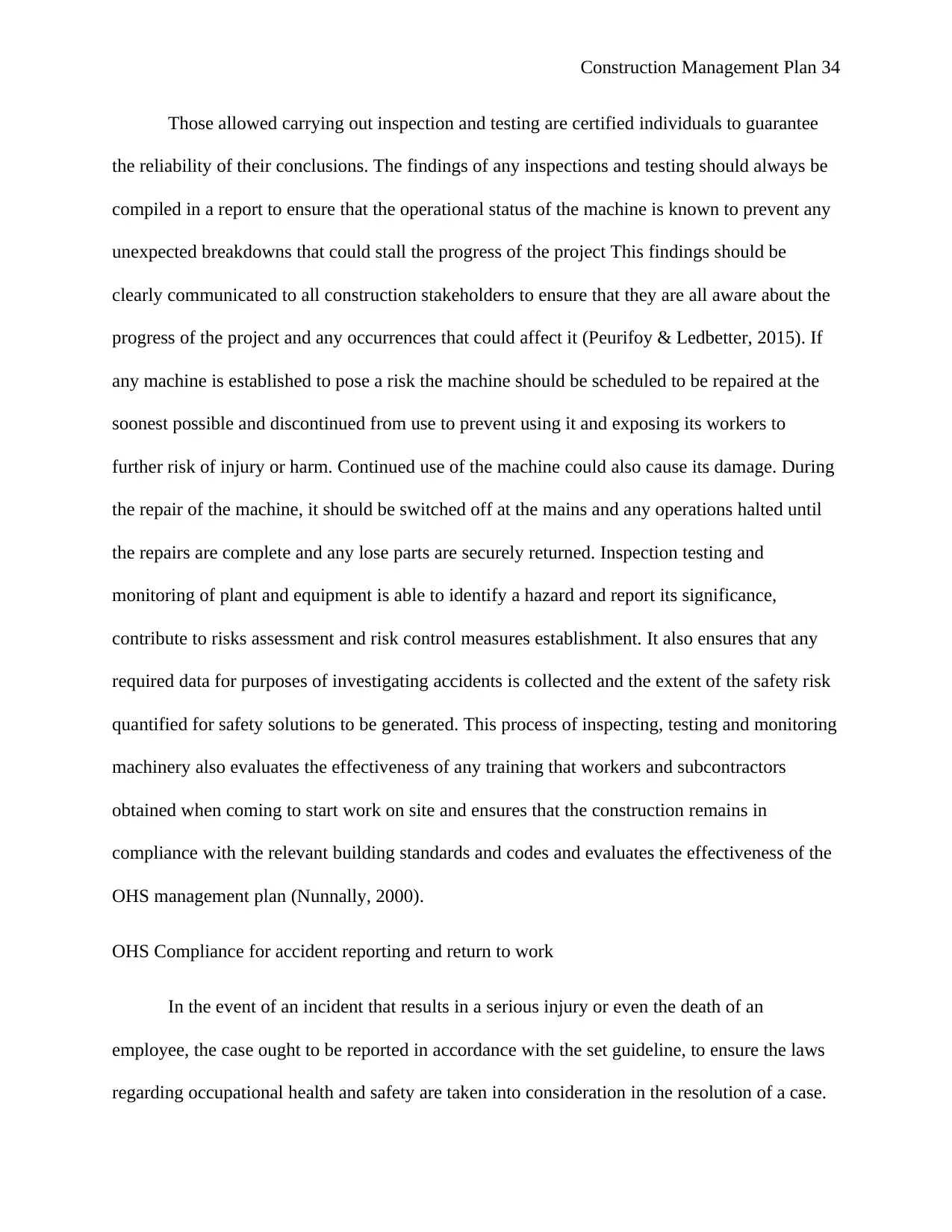
Construction Management Plan 34
Those allowed carrying out inspection and testing are certified individuals to guarantee
the reliability of their conclusions. The findings of any inspections and testing should always be
compiled in a report to ensure that the operational status of the machine is known to prevent any
unexpected breakdowns that could stall the progress of the project This findings should be
clearly communicated to all construction stakeholders to ensure that they are all aware about the
progress of the project and any occurrences that could affect it (Peurifoy & Ledbetter, 2015). If
any machine is established to pose a risk the machine should be scheduled to be repaired at the
soonest possible and discontinued from use to prevent using it and exposing its workers to
further risk of injury or harm. Continued use of the machine could also cause its damage. During
the repair of the machine, it should be switched off at the mains and any operations halted until
the repairs are complete and any lose parts are securely returned. Inspection testing and
monitoring of plant and equipment is able to identify a hazard and report its significance,
contribute to risks assessment and risk control measures establishment. It also ensures that any
required data for purposes of investigating accidents is collected and the extent of the safety risk
quantified for safety solutions to be generated. This process of inspecting, testing and monitoring
machinery also evaluates the effectiveness of any training that workers and subcontractors
obtained when coming to start work on site and ensures that the construction remains in
compliance with the relevant building standards and codes and evaluates the effectiveness of the
OHS management plan (Nunnally, 2000).
OHS Compliance for accident reporting and return to work
In the event of an incident that results in a serious injury or even the death of an
employee, the case ought to be reported in accordance with the set guideline, to ensure the laws
regarding occupational health and safety are taken into consideration in the resolution of a case.
Those allowed carrying out inspection and testing are certified individuals to guarantee
the reliability of their conclusions. The findings of any inspections and testing should always be
compiled in a report to ensure that the operational status of the machine is known to prevent any
unexpected breakdowns that could stall the progress of the project This findings should be
clearly communicated to all construction stakeholders to ensure that they are all aware about the
progress of the project and any occurrences that could affect it (Peurifoy & Ledbetter, 2015). If
any machine is established to pose a risk the machine should be scheduled to be repaired at the
soonest possible and discontinued from use to prevent using it and exposing its workers to
further risk of injury or harm. Continued use of the machine could also cause its damage. During
the repair of the machine, it should be switched off at the mains and any operations halted until
the repairs are complete and any lose parts are securely returned. Inspection testing and
monitoring of plant and equipment is able to identify a hazard and report its significance,
contribute to risks assessment and risk control measures establishment. It also ensures that any
required data for purposes of investigating accidents is collected and the extent of the safety risk
quantified for safety solutions to be generated. This process of inspecting, testing and monitoring
machinery also evaluates the effectiveness of any training that workers and subcontractors
obtained when coming to start work on site and ensures that the construction remains in
compliance with the relevant building standards and codes and evaluates the effectiveness of the
OHS management plan (Nunnally, 2000).
OHS Compliance for accident reporting and return to work
In the event of an incident that results in a serious injury or even the death of an
employee, the case ought to be reported in accordance with the set guideline, to ensure the laws
regarding occupational health and safety are taken into consideration in the resolution of a case.
Secure Best Marks with AI Grader
Need help grading? Try our AI Grader for instant feedback on your assignments.
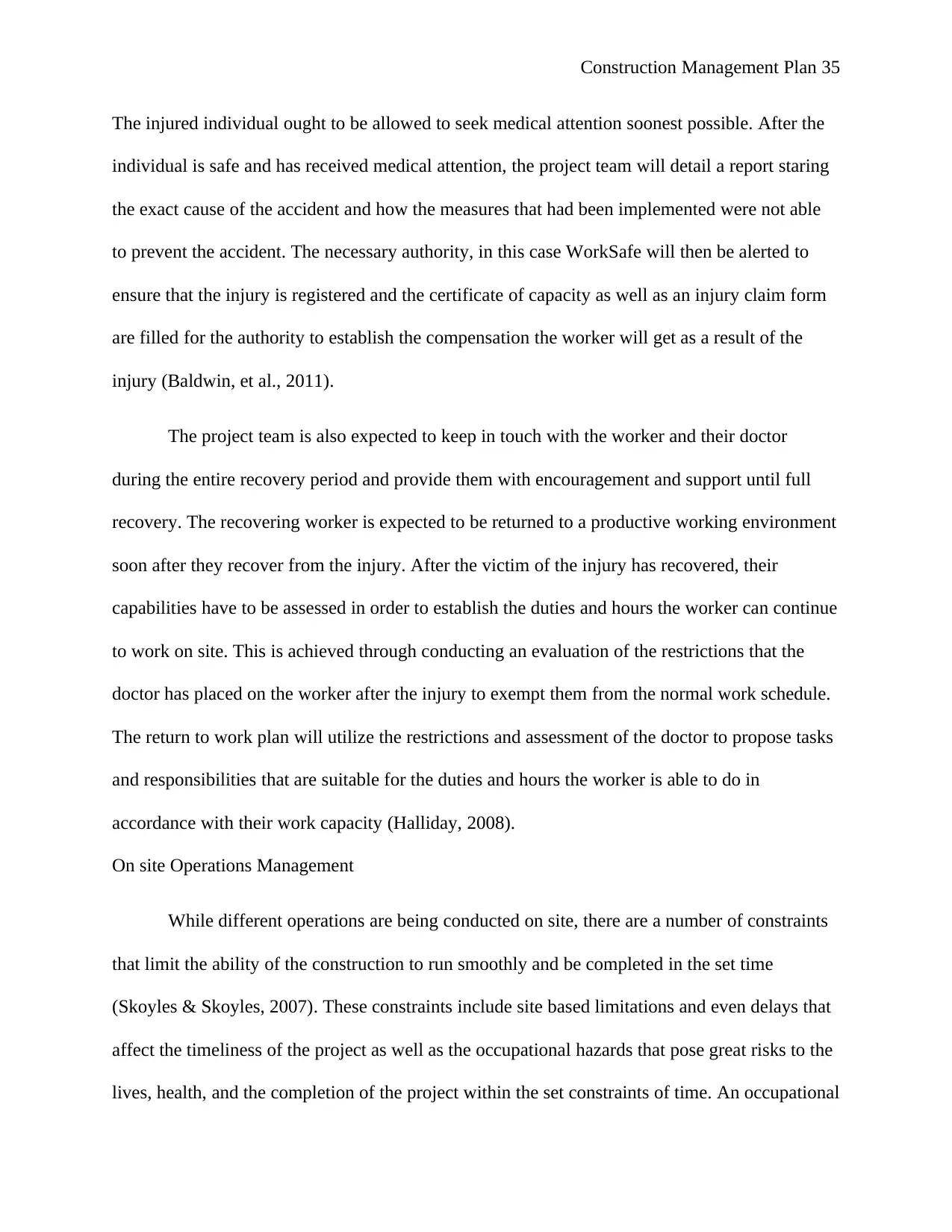
Construction Management Plan 35
The injured individual ought to be allowed to seek medical attention soonest possible. After the
individual is safe and has received medical attention, the project team will detail a report staring
the exact cause of the accident and how the measures that had been implemented were not able
to prevent the accident. The necessary authority, in this case WorkSafe will then be alerted to
ensure that the injury is registered and the certificate of capacity as well as an injury claim form
are filled for the authority to establish the compensation the worker will get as a result of the
injury (Baldwin, et al., 2011).
The project team is also expected to keep in touch with the worker and their doctor
during the entire recovery period and provide them with encouragement and support until full
recovery. The recovering worker is expected to be returned to a productive working environment
soon after they recover from the injury. After the victim of the injury has recovered, their
capabilities have to be assessed in order to establish the duties and hours the worker can continue
to work on site. This is achieved through conducting an evaluation of the restrictions that the
doctor has placed on the worker after the injury to exempt them from the normal work schedule.
The return to work plan will utilize the restrictions and assessment of the doctor to propose tasks
and responsibilities that are suitable for the duties and hours the worker is able to do in
accordance with their work capacity (Halliday, 2008).
On site Operations Management
While different operations are being conducted on site, there are a number of constraints
that limit the ability of the construction to run smoothly and be completed in the set time
(Skoyles & Skoyles, 2007). These constraints include site based limitations and even delays that
affect the timeliness of the project as well as the occupational hazards that pose great risks to the
lives, health, and the completion of the project within the set constraints of time. An occupational
The injured individual ought to be allowed to seek medical attention soonest possible. After the
individual is safe and has received medical attention, the project team will detail a report staring
the exact cause of the accident and how the measures that had been implemented were not able
to prevent the accident. The necessary authority, in this case WorkSafe will then be alerted to
ensure that the injury is registered and the certificate of capacity as well as an injury claim form
are filled for the authority to establish the compensation the worker will get as a result of the
injury (Baldwin, et al., 2011).
The project team is also expected to keep in touch with the worker and their doctor
during the entire recovery period and provide them with encouragement and support until full
recovery. The recovering worker is expected to be returned to a productive working environment
soon after they recover from the injury. After the victim of the injury has recovered, their
capabilities have to be assessed in order to establish the duties and hours the worker can continue
to work on site. This is achieved through conducting an evaluation of the restrictions that the
doctor has placed on the worker after the injury to exempt them from the normal work schedule.
The return to work plan will utilize the restrictions and assessment of the doctor to propose tasks
and responsibilities that are suitable for the duties and hours the worker is able to do in
accordance with their work capacity (Halliday, 2008).
On site Operations Management
While different operations are being conducted on site, there are a number of constraints
that limit the ability of the construction to run smoothly and be completed in the set time
(Skoyles & Skoyles, 2007). These constraints include site based limitations and even delays that
affect the timeliness of the project as well as the occupational hazards that pose great risks to the
lives, health, and the completion of the project within the set constraints of time. An occupational
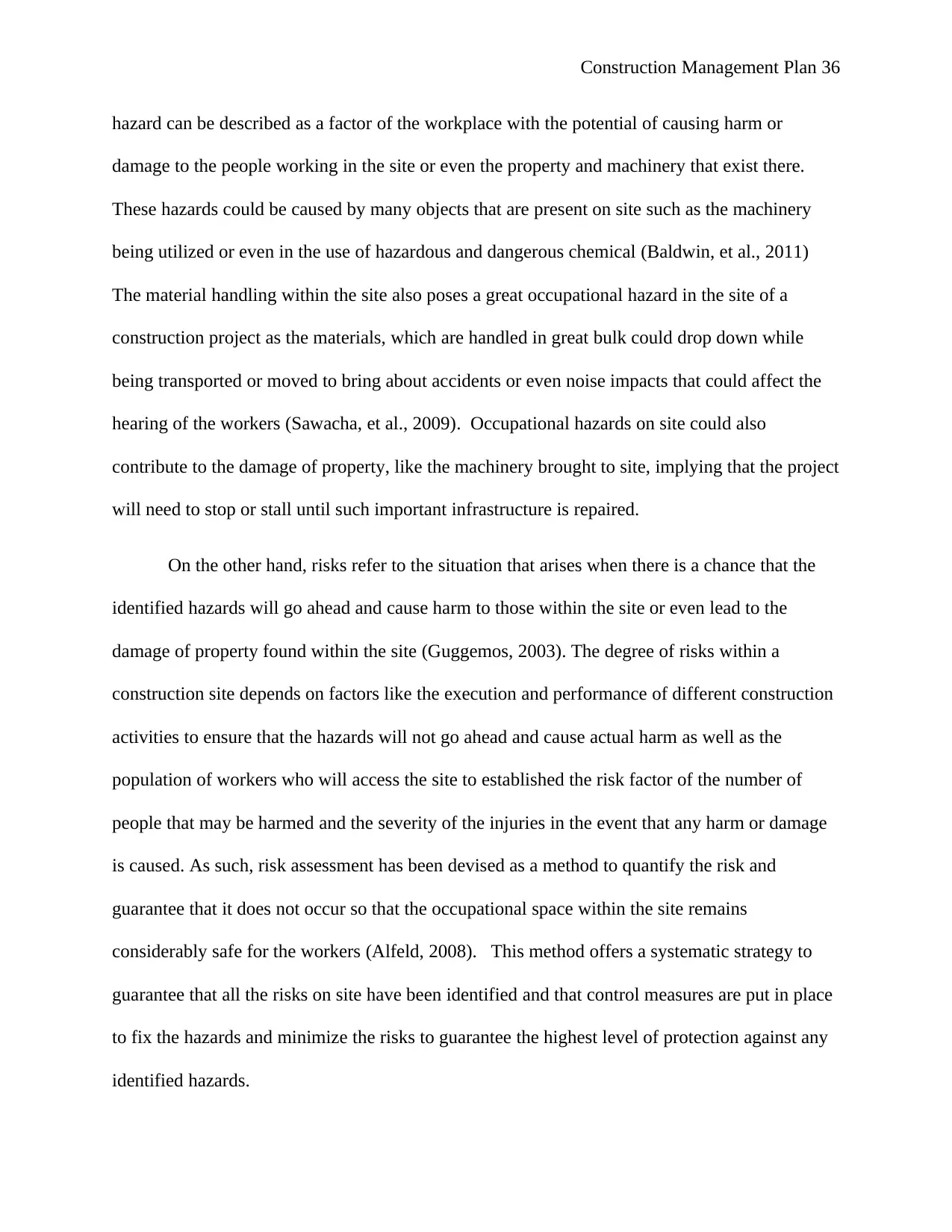
Construction Management Plan 36
hazard can be described as a factor of the workplace with the potential of causing harm or
damage to the people working in the site or even the property and machinery that exist there.
These hazards could be caused by many objects that are present on site such as the machinery
being utilized or even in the use of hazardous and dangerous chemical (Baldwin, et al., 2011)
The material handling within the site also poses a great occupational hazard in the site of a
construction project as the materials, which are handled in great bulk could drop down while
being transported or moved to bring about accidents or even noise impacts that could affect the
hearing of the workers (Sawacha, et al., 2009). Occupational hazards on site could also
contribute to the damage of property, like the machinery brought to site, implying that the project
will need to stop or stall until such important infrastructure is repaired.
On the other hand, risks refer to the situation that arises when there is a chance that the
identified hazards will go ahead and cause harm to those within the site or even lead to the
damage of property found within the site (Guggemos, 2003). The degree of risks within a
construction site depends on factors like the execution and performance of different construction
activities to ensure that the hazards will not go ahead and cause actual harm as well as the
population of workers who will access the site to established the risk factor of the number of
people that may be harmed and the severity of the injuries in the event that any harm or damage
is caused. As such, risk assessment has been devised as a method to quantify the risk and
guarantee that it does not occur so that the occupational space within the site remains
considerably safe for the workers (Alfeld, 2008). This method offers a systematic strategy to
guarantee that all the risks on site have been identified and that control measures are put in place
to fix the hazards and minimize the risks to guarantee the highest level of protection against any
identified hazards.
hazard can be described as a factor of the workplace with the potential of causing harm or
damage to the people working in the site or even the property and machinery that exist there.
These hazards could be caused by many objects that are present on site such as the machinery
being utilized or even in the use of hazardous and dangerous chemical (Baldwin, et al., 2011)
The material handling within the site also poses a great occupational hazard in the site of a
construction project as the materials, which are handled in great bulk could drop down while
being transported or moved to bring about accidents or even noise impacts that could affect the
hearing of the workers (Sawacha, et al., 2009). Occupational hazards on site could also
contribute to the damage of property, like the machinery brought to site, implying that the project
will need to stop or stall until such important infrastructure is repaired.
On the other hand, risks refer to the situation that arises when there is a chance that the
identified hazards will go ahead and cause harm to those within the site or even lead to the
damage of property found within the site (Guggemos, 2003). The degree of risks within a
construction site depends on factors like the execution and performance of different construction
activities to ensure that the hazards will not go ahead and cause actual harm as well as the
population of workers who will access the site to established the risk factor of the number of
people that may be harmed and the severity of the injuries in the event that any harm or damage
is caused. As such, risk assessment has been devised as a method to quantify the risk and
guarantee that it does not occur so that the occupational space within the site remains
considerably safe for the workers (Alfeld, 2008). This method offers a systematic strategy to
guarantee that all the risks on site have been identified and that control measures are put in place
to fix the hazards and minimize the risks to guarantee the highest level of protection against any
identified hazards.

Construction Management Plan 37
Possible hazards on site can be identified through consultations with the professionals
who carry out these tasks on a daily basis, as they are the most resourceful people to identify any
potential issues regarding the health and safety of the stakeholders (Toole, 2002). The hazards
will be identified through identifying any forms of hazards that could result in damaging
property and even the loss of the lives of those in the workers, as well as the potential causes of
harm to the workers. It also calls for the project team to seek to establish the different ways in
which people could get hurt when there are on site and the possibility that this could occur in
order to measure the level of this risks. The project team after identifying the hazards will then
move to find ways that these risks can be managed and handled in order to implement these
measures as risk control measures that will be specifically effective for the problems of this site.
These measures will be the most effective, reasonable, and practical solutions for the different
hazards that will be noted in the project site (Fang, et al., 2001).
To manage the occurrences of any of these risks, the project team will also regularly
monitor the risk control measures in order to identify their effectiveness in protecting the safety
of the workers and all those who visit the site (Meckler & Hyman, 2010). This will be done
through consulting the workers themselves and also through conducting research about emerging
technologies, policies, and even interventions that are proving to be more effective. The workers
would be very resourceful in providing insights for identifying for these hazards can be fixed in
order for the risk of injuries or damaging properties are completely minimized. This is so
because they are the ones that know what hazards they face while on site when they are doing
they jobs. This would be very helpful when identifying the risks that the workers face on a daily
basis when doing their part. This will require for the possibility of occurrence to be identified as
well as the kind of damage or hurt that the occurrence would cause (Shen, et al., 2010). To
Possible hazards on site can be identified through consultations with the professionals
who carry out these tasks on a daily basis, as they are the most resourceful people to identify any
potential issues regarding the health and safety of the stakeholders (Toole, 2002). The hazards
will be identified through identifying any forms of hazards that could result in damaging
property and even the loss of the lives of those in the workers, as well as the potential causes of
harm to the workers. It also calls for the project team to seek to establish the different ways in
which people could get hurt when there are on site and the possibility that this could occur in
order to measure the level of this risks. The project team after identifying the hazards will then
move to find ways that these risks can be managed and handled in order to implement these
measures as risk control measures that will be specifically effective for the problems of this site.
These measures will be the most effective, reasonable, and practical solutions for the different
hazards that will be noted in the project site (Fang, et al., 2001).
To manage the occurrences of any of these risks, the project team will also regularly
monitor the risk control measures in order to identify their effectiveness in protecting the safety
of the workers and all those who visit the site (Meckler & Hyman, 2010). This will be done
through consulting the workers themselves and also through conducting research about emerging
technologies, policies, and even interventions that are proving to be more effective. The workers
would be very resourceful in providing insights for identifying for these hazards can be fixed in
order for the risk of injuries or damaging properties are completely minimized. This is so
because they are the ones that know what hazards they face while on site when they are doing
they jobs. This would be very helpful when identifying the risks that the workers face on a daily
basis when doing their part. This will require for the possibility of occurrence to be identified as
well as the kind of damage or hurt that the occurrence would cause (Shen, et al., 2010). To
Paraphrase This Document
Need a fresh take? Get an instant paraphrase of this document with our AI Paraphraser
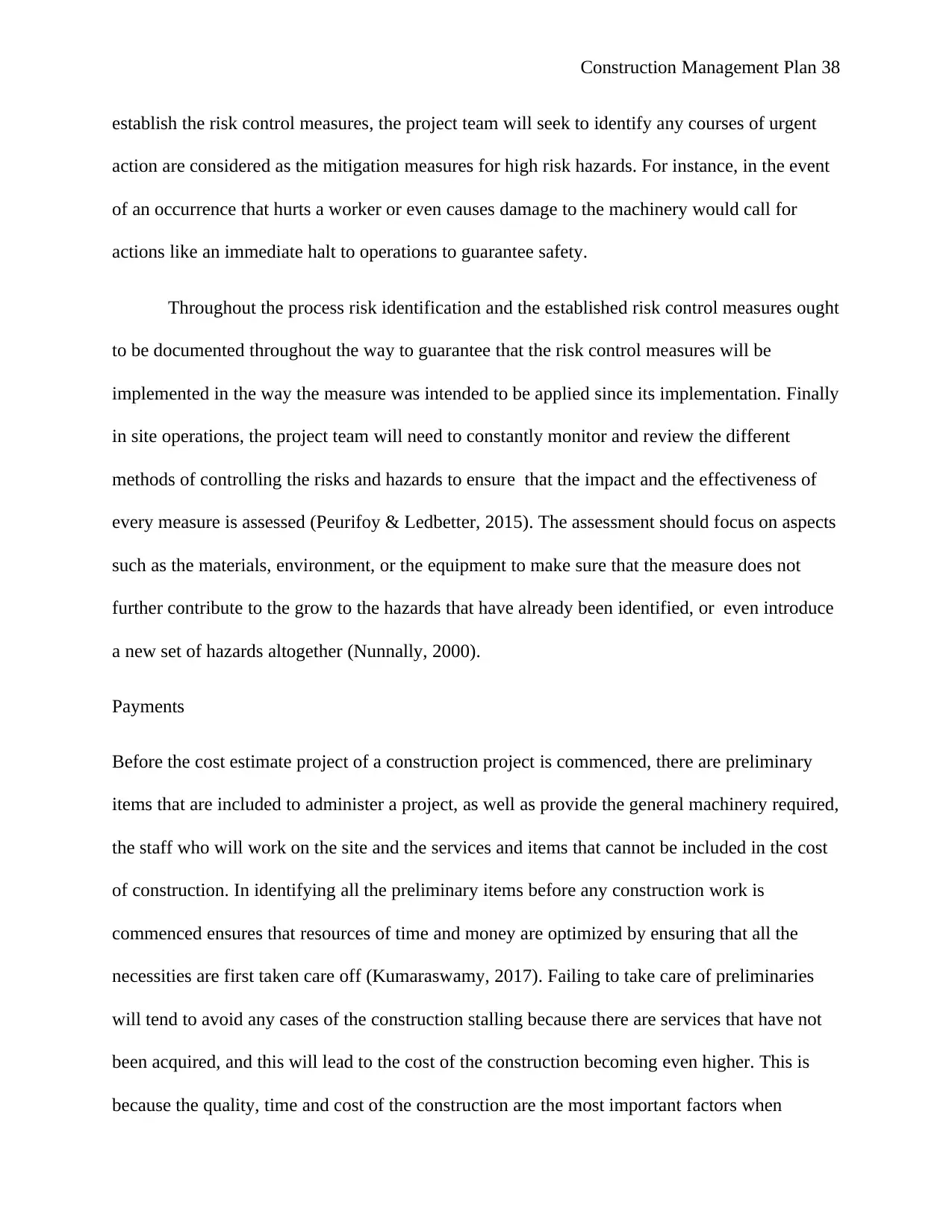
Construction Management Plan 38
establish the risk control measures, the project team will seek to identify any courses of urgent
action are considered as the mitigation measures for high risk hazards. For instance, in the event
of an occurrence that hurts a worker or even causes damage to the machinery would call for
actions like an immediate halt to operations to guarantee safety.
Throughout the process risk identification and the established risk control measures ought
to be documented throughout the way to guarantee that the risk control measures will be
implemented in the way the measure was intended to be applied since its implementation. Finally
in site operations, the project team will need to constantly monitor and review the different
methods of controlling the risks and hazards to ensure that the impact and the effectiveness of
every measure is assessed (Peurifoy & Ledbetter, 2015). The assessment should focus on aspects
such as the materials, environment, or the equipment to make sure that the measure does not
further contribute to the grow to the hazards that have already been identified, or even introduce
a new set of hazards altogether (Nunnally, 2000).
Payments
Before the cost estimate project of a construction project is commenced, there are preliminary
items that are included to administer a project, as well as provide the general machinery required,
the staff who will work on the site and the services and items that cannot be included in the cost
of construction. In identifying all the preliminary items before any construction work is
commenced ensures that resources of time and money are optimized by ensuring that all the
necessities are first taken care off (Kumaraswamy, 2017). Failing to take care of preliminaries
will tend to avoid any cases of the construction stalling because there are services that have not
been acquired, and this will lead to the cost of the construction becoming even higher. This is
because the quality, time and cost of the construction are the most important factors when
establish the risk control measures, the project team will seek to identify any courses of urgent
action are considered as the mitigation measures for high risk hazards. For instance, in the event
of an occurrence that hurts a worker or even causes damage to the machinery would call for
actions like an immediate halt to operations to guarantee safety.
Throughout the process risk identification and the established risk control measures ought
to be documented throughout the way to guarantee that the risk control measures will be
implemented in the way the measure was intended to be applied since its implementation. Finally
in site operations, the project team will need to constantly monitor and review the different
methods of controlling the risks and hazards to ensure that the impact and the effectiveness of
every measure is assessed (Peurifoy & Ledbetter, 2015). The assessment should focus on aspects
such as the materials, environment, or the equipment to make sure that the measure does not
further contribute to the grow to the hazards that have already been identified, or even introduce
a new set of hazards altogether (Nunnally, 2000).
Payments
Before the cost estimate project of a construction project is commenced, there are preliminary
items that are included to administer a project, as well as provide the general machinery required,
the staff who will work on the site and the services and items that cannot be included in the cost
of construction. In identifying all the preliminary items before any construction work is
commenced ensures that resources of time and money are optimized by ensuring that all the
necessities are first taken care off (Kumaraswamy, 2017). Failing to take care of preliminaries
will tend to avoid any cases of the construction stalling because there are services that have not
been acquired, and this will lead to the cost of the construction becoming even higher. This is
because the quality, time and cost of the construction are the most important factors when
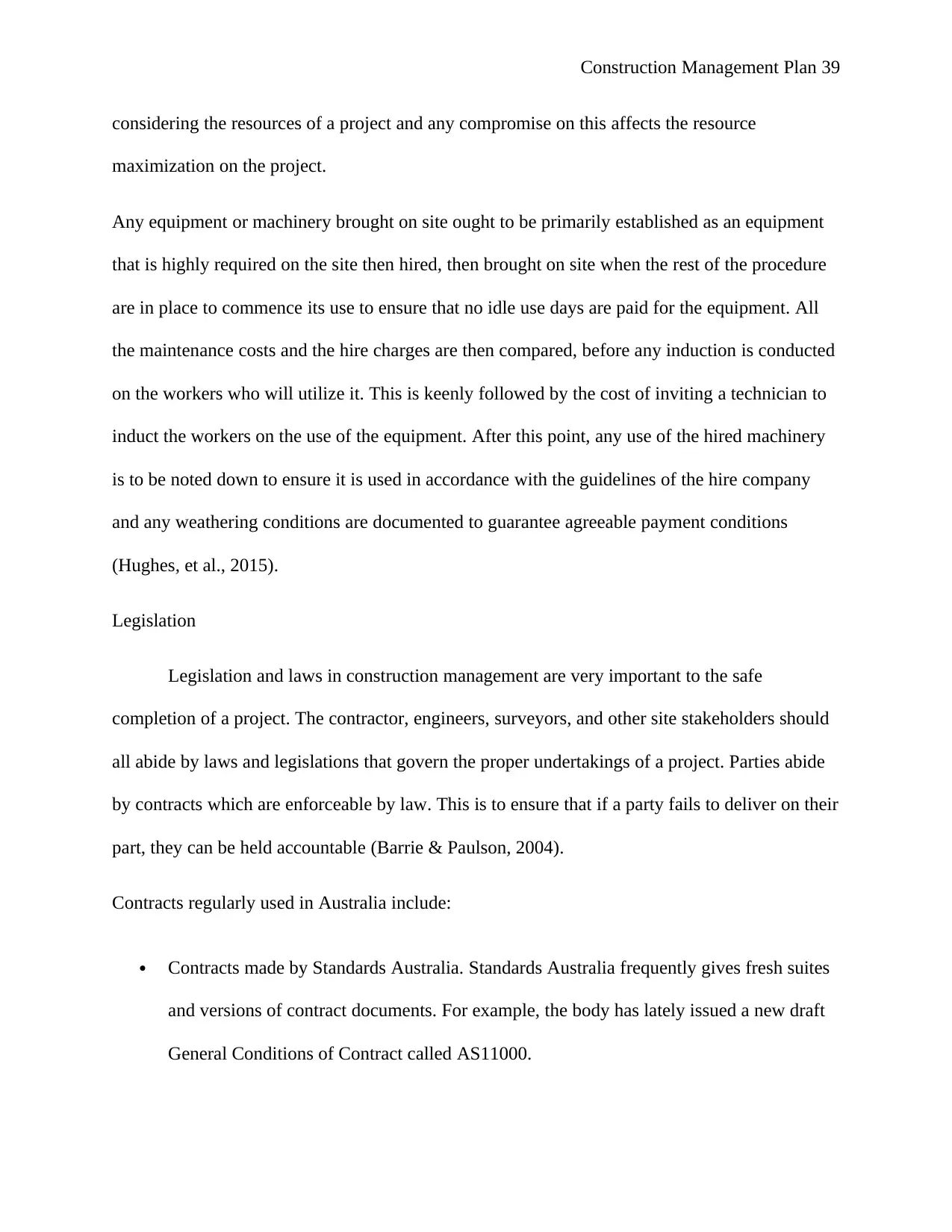
Construction Management Plan 39
considering the resources of a project and any compromise on this affects the resource
maximization on the project.
Any equipment or machinery brought on site ought to be primarily established as an equipment
that is highly required on the site then hired, then brought on site when the rest of the procedure
are in place to commence its use to ensure that no idle use days are paid for the equipment. All
the maintenance costs and the hire charges are then compared, before any induction is conducted
on the workers who will utilize it. This is keenly followed by the cost of inviting a technician to
induct the workers on the use of the equipment. After this point, any use of the hired machinery
is to be noted down to ensure it is used in accordance with the guidelines of the hire company
and any weathering conditions are documented to guarantee agreeable payment conditions
(Hughes, et al., 2015).
Legislation
Legislation and laws in construction management are very important to the safe
completion of a project. The contractor, engineers, surveyors, and other site stakeholders should
all abide by laws and legislations that govern the proper undertakings of a project. Parties abide
by contracts which are enforceable by law. This is to ensure that if a party fails to deliver on their
part, they can be held accountable (Barrie & Paulson, 2004).
Contracts regularly used in Australia include:
Contracts made by Standards Australia. Standards Australia frequently gives fresh suites
and versions of contract documents. For example, the body has lately issued a new draft
General Conditions of Contract called AS11000.
considering the resources of a project and any compromise on this affects the resource
maximization on the project.
Any equipment or machinery brought on site ought to be primarily established as an equipment
that is highly required on the site then hired, then brought on site when the rest of the procedure
are in place to commence its use to ensure that no idle use days are paid for the equipment. All
the maintenance costs and the hire charges are then compared, before any induction is conducted
on the workers who will utilize it. This is keenly followed by the cost of inviting a technician to
induct the workers on the use of the equipment. After this point, any use of the hired machinery
is to be noted down to ensure it is used in accordance with the guidelines of the hire company
and any weathering conditions are documented to guarantee agreeable payment conditions
(Hughes, et al., 2015).
Legislation
Legislation and laws in construction management are very important to the safe
completion of a project. The contractor, engineers, surveyors, and other site stakeholders should
all abide by laws and legislations that govern the proper undertakings of a project. Parties abide
by contracts which are enforceable by law. This is to ensure that if a party fails to deliver on their
part, they can be held accountable (Barrie & Paulson, 2004).
Contracts regularly used in Australia include:
Contracts made by Standards Australia. Standards Australia frequently gives fresh suites
and versions of contract documents. For example, the body has lately issued a new draft
General Conditions of Contract called AS11000.
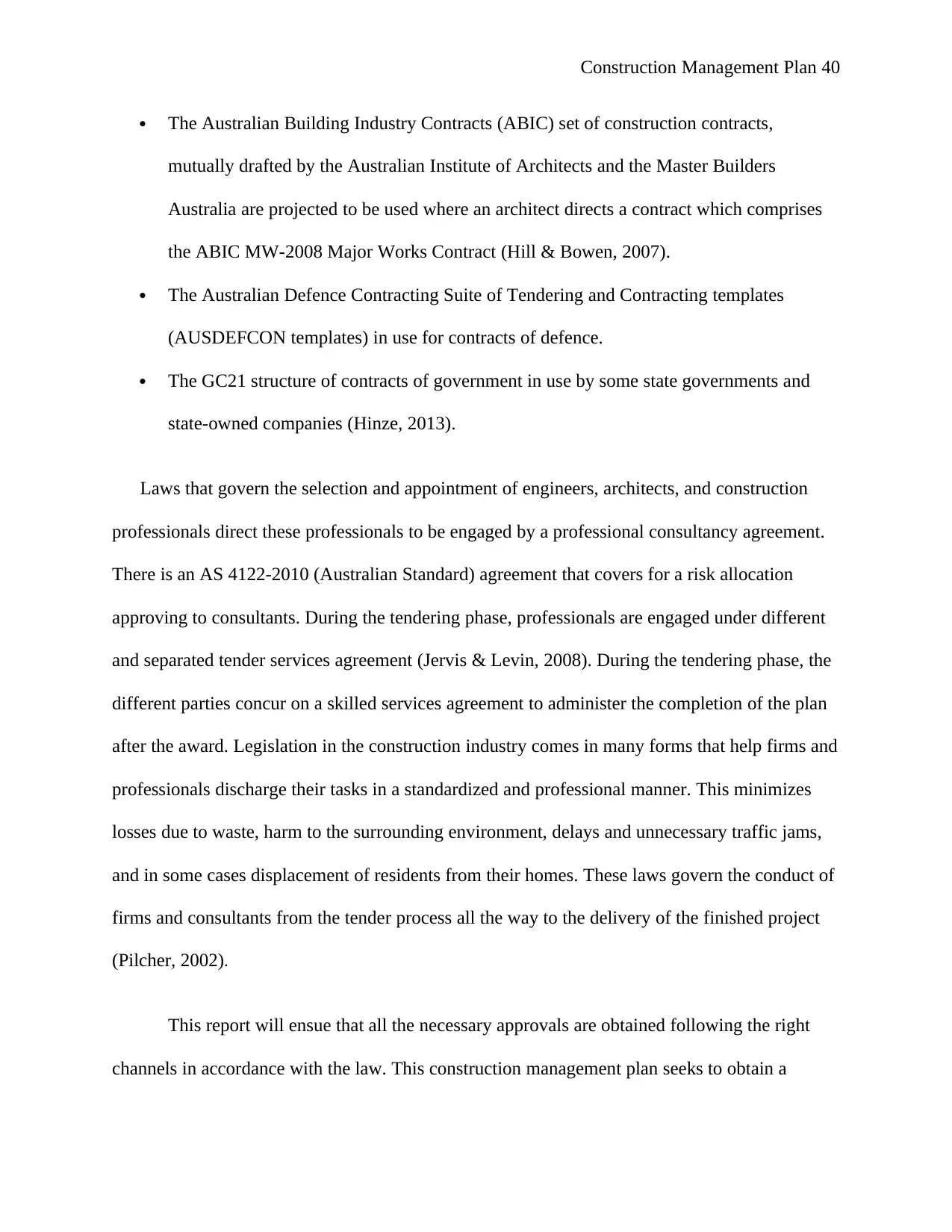
Construction Management Plan 40
The Australian Building Industry Contracts (ABIC) set of construction contracts,
mutually drafted by the Australian Institute of Architects and the Master Builders
Australia are projected to be used where an architect directs a contract which comprises
the ABIC MW-2008 Major Works Contract (Hill & Bowen, 2007).
The Australian Defence Contracting Suite of Tendering and Contracting templates
(AUSDEFCON templates) in use for contracts of defence.
The GC21 structure of contracts of government in use by some state governments and
state-owned companies (Hinze, 2013).
Laws that govern the selection and appointment of engineers, architects, and construction
professionals direct these professionals to be engaged by a professional consultancy agreement.
There is an AS 4122-2010 (Australian Standard) agreement that covers for a risk allocation
approving to consultants. During the tendering phase, professionals are engaged under different
and separated tender services agreement (Jervis & Levin, 2008). During the tendering phase, the
different parties concur on a skilled services agreement to administer the completion of the plan
after the award. Legislation in the construction industry comes in many forms that help firms and
professionals discharge their tasks in a standardized and professional manner. This minimizes
losses due to waste, harm to the surrounding environment, delays and unnecessary traffic jams,
and in some cases displacement of residents from their homes. These laws govern the conduct of
firms and consultants from the tender process all the way to the delivery of the finished project
(Pilcher, 2002).
This report will ensue that all the necessary approvals are obtained following the right
channels in accordance with the law. This construction management plan seeks to obtain a
The Australian Building Industry Contracts (ABIC) set of construction contracts,
mutually drafted by the Australian Institute of Architects and the Master Builders
Australia are projected to be used where an architect directs a contract which comprises
the ABIC MW-2008 Major Works Contract (Hill & Bowen, 2007).
The Australian Defence Contracting Suite of Tendering and Contracting templates
(AUSDEFCON templates) in use for contracts of defence.
The GC21 structure of contracts of government in use by some state governments and
state-owned companies (Hinze, 2013).
Laws that govern the selection and appointment of engineers, architects, and construction
professionals direct these professionals to be engaged by a professional consultancy agreement.
There is an AS 4122-2010 (Australian Standard) agreement that covers for a risk allocation
approving to consultants. During the tendering phase, professionals are engaged under different
and separated tender services agreement (Jervis & Levin, 2008). During the tendering phase, the
different parties concur on a skilled services agreement to administer the completion of the plan
after the award. Legislation in the construction industry comes in many forms that help firms and
professionals discharge their tasks in a standardized and professional manner. This minimizes
losses due to waste, harm to the surrounding environment, delays and unnecessary traffic jams,
and in some cases displacement of residents from their homes. These laws govern the conduct of
firms and consultants from the tender process all the way to the delivery of the finished project
(Pilcher, 2002).
This report will ensue that all the necessary approvals are obtained following the right
channels in accordance with the law. This construction management plan seeks to obtain a
Secure Best Marks with AI Grader
Need help grading? Try our AI Grader for instant feedback on your assignments.
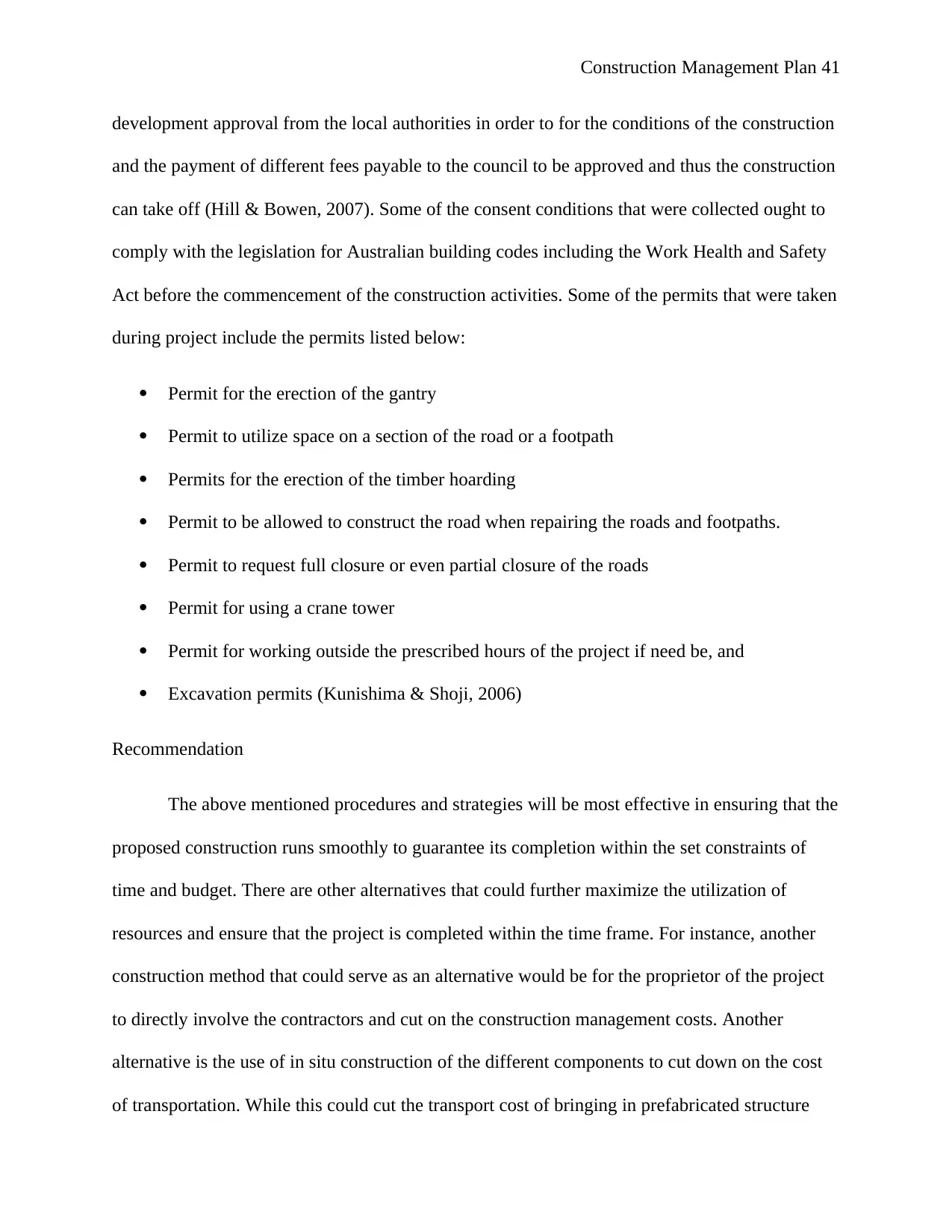
Construction Management Plan 41
development approval from the local authorities in order to for the conditions of the construction
and the payment of different fees payable to the council to be approved and thus the construction
can take off (Hill & Bowen, 2007). Some of the consent conditions that were collected ought to
comply with the legislation for Australian building codes including the Work Health and Safety
Act before the commencement of the construction activities. Some of the permits that were taken
during project include the permits listed below:
Permit for the erection of the gantry
Permit to utilize space on a section of the road or a footpath
Permits for the erection of the timber hoarding
Permit to be allowed to construct the road when repairing the roads and footpaths.
Permit to request full closure or even partial closure of the roads
Permit for using a crane tower
Permit for working outside the prescribed hours of the project if need be, and
Excavation permits (Kunishima & Shoji, 2006)
Recommendation
The above mentioned procedures and strategies will be most effective in ensuring that the
proposed construction runs smoothly to guarantee its completion within the set constraints of
time and budget. There are other alternatives that could further maximize the utilization of
resources and ensure that the project is completed within the time frame. For instance, another
construction method that could serve as an alternative would be for the proprietor of the project
to directly involve the contractors and cut on the construction management costs. Another
alternative is the use of in situ construction of the different components to cut down on the cost
of transportation. While this could cut the transport cost of bringing in prefabricated structure
development approval from the local authorities in order to for the conditions of the construction
and the payment of different fees payable to the council to be approved and thus the construction
can take off (Hill & Bowen, 2007). Some of the consent conditions that were collected ought to
comply with the legislation for Australian building codes including the Work Health and Safety
Act before the commencement of the construction activities. Some of the permits that were taken
during project include the permits listed below:
Permit for the erection of the gantry
Permit to utilize space on a section of the road or a footpath
Permits for the erection of the timber hoarding
Permit to be allowed to construct the road when repairing the roads and footpaths.
Permit to request full closure or even partial closure of the roads
Permit for using a crane tower
Permit for working outside the prescribed hours of the project if need be, and
Excavation permits (Kunishima & Shoji, 2006)
Recommendation
The above mentioned procedures and strategies will be most effective in ensuring that the
proposed construction runs smoothly to guarantee its completion within the set constraints of
time and budget. There are other alternatives that could further maximize the utilization of
resources and ensure that the project is completed within the time frame. For instance, another
construction method that could serve as an alternative would be for the proprietor of the project
to directly involve the contractors and cut on the construction management costs. Another
alternative is the use of in situ construction of the different components to cut down on the cost
of transportation. While this could cut the transport cost of bringing in prefabricated structure
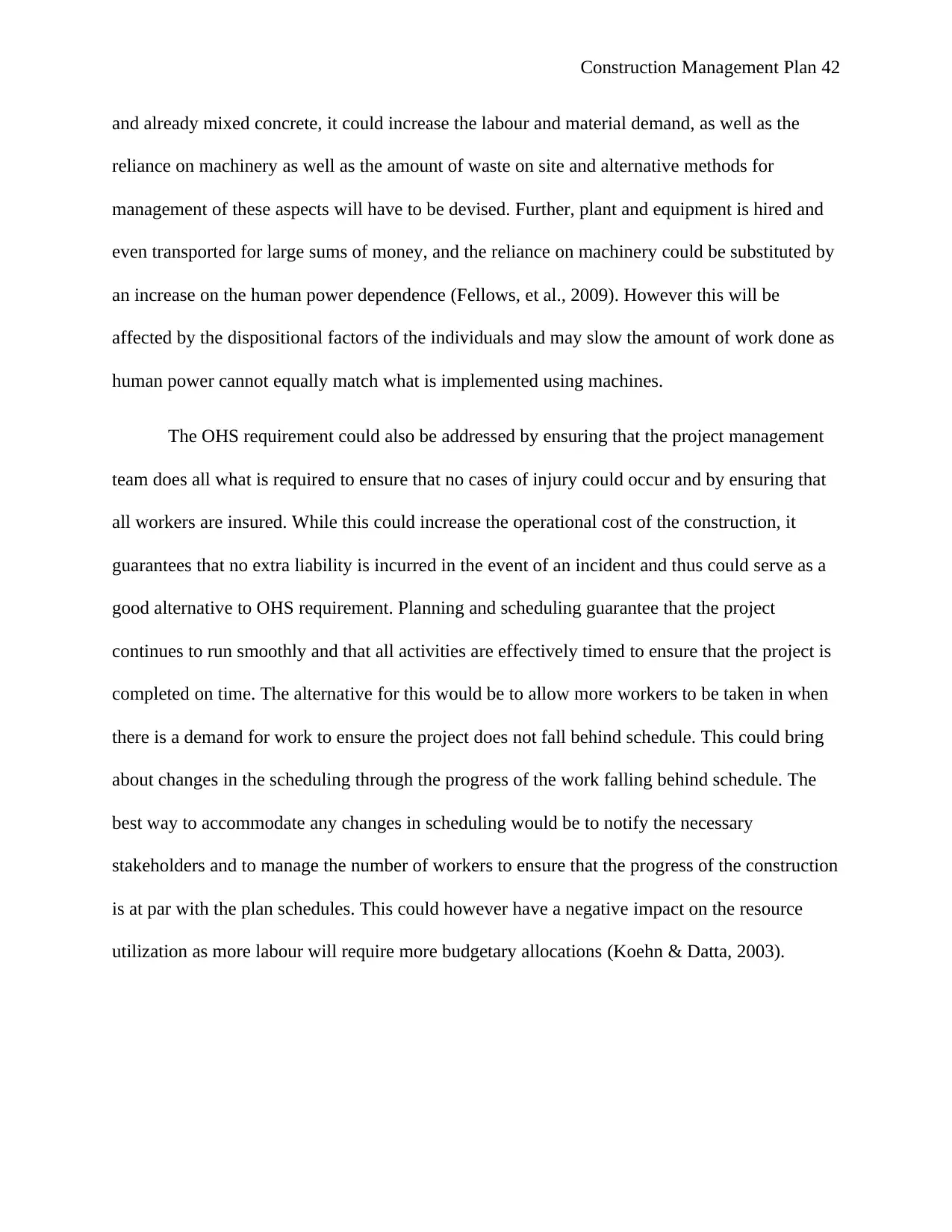
Construction Management Plan 42
and already mixed concrete, it could increase the labour and material demand, as well as the
reliance on machinery as well as the amount of waste on site and alternative methods for
management of these aspects will have to be devised. Further, plant and equipment is hired and
even transported for large sums of money, and the reliance on machinery could be substituted by
an increase on the human power dependence (Fellows, et al., 2009). However this will be
affected by the dispositional factors of the individuals and may slow the amount of work done as
human power cannot equally match what is implemented using machines.
The OHS requirement could also be addressed by ensuring that the project management
team does all what is required to ensure that no cases of injury could occur and by ensuring that
all workers are insured. While this could increase the operational cost of the construction, it
guarantees that no extra liability is incurred in the event of an incident and thus could serve as a
good alternative to OHS requirement. Planning and scheduling guarantee that the project
continues to run smoothly and that all activities are effectively timed to ensure that the project is
completed on time. The alternative for this would be to allow more workers to be taken in when
there is a demand for work to ensure the project does not fall behind schedule. This could bring
about changes in the scheduling through the progress of the work falling behind schedule. The
best way to accommodate any changes in scheduling would be to notify the necessary
stakeholders and to manage the number of workers to ensure that the progress of the construction
is at par with the plan schedules. This could however have a negative impact on the resource
utilization as more labour will require more budgetary allocations (Koehn & Datta, 2003).
and already mixed concrete, it could increase the labour and material demand, as well as the
reliance on machinery as well as the amount of waste on site and alternative methods for
management of these aspects will have to be devised. Further, plant and equipment is hired and
even transported for large sums of money, and the reliance on machinery could be substituted by
an increase on the human power dependence (Fellows, et al., 2009). However this will be
affected by the dispositional factors of the individuals and may slow the amount of work done as
human power cannot equally match what is implemented using machines.
The OHS requirement could also be addressed by ensuring that the project management
team does all what is required to ensure that no cases of injury could occur and by ensuring that
all workers are insured. While this could increase the operational cost of the construction, it
guarantees that no extra liability is incurred in the event of an incident and thus could serve as a
good alternative to OHS requirement. Planning and scheduling guarantee that the project
continues to run smoothly and that all activities are effectively timed to ensure that the project is
completed on time. The alternative for this would be to allow more workers to be taken in when
there is a demand for work to ensure the project does not fall behind schedule. This could bring
about changes in the scheduling through the progress of the work falling behind schedule. The
best way to accommodate any changes in scheduling would be to notify the necessary
stakeholders and to manage the number of workers to ensure that the progress of the construction
is at par with the plan schedules. This could however have a negative impact on the resource
utilization as more labour will require more budgetary allocations (Koehn & Datta, 2003).
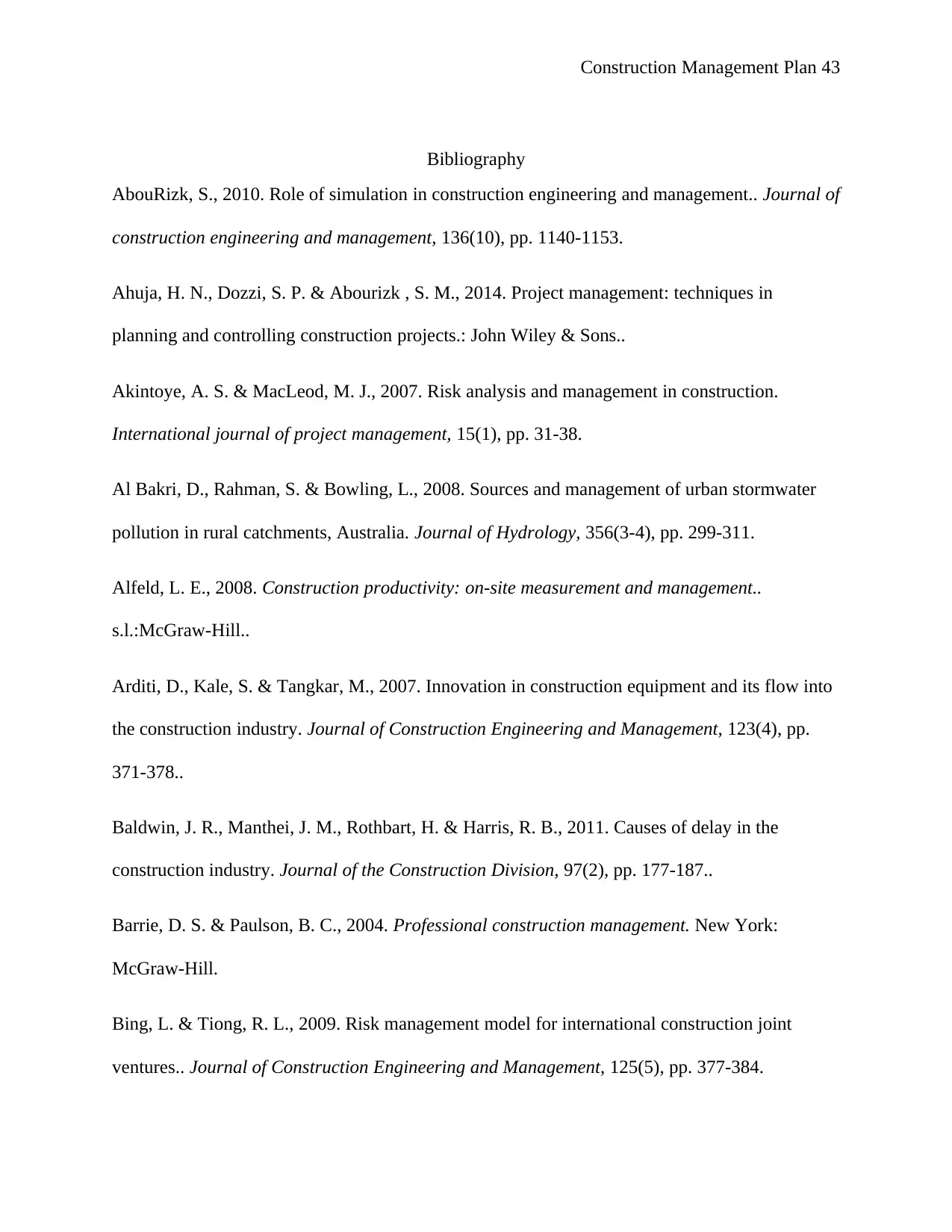
Construction Management Plan 43
Bibliography
AbouRizk, S., 2010. Role of simulation in construction engineering and management.. Journal of
construction engineering and management, 136(10), pp. 1140-1153.
Ahuja, H. N., Dozzi, S. P. & Abourizk , S. M., 2014. Project management: techniques in
planning and controlling construction projects.: John Wiley & Sons..
Akintoye, A. S. & MacLeod, M. J., 2007. Risk analysis and management in construction.
International journal of project management, 15(1), pp. 31-38.
Al Bakri, D., Rahman, S. & Bowling, L., 2008. Sources and management of urban stormwater
pollution in rural catchments, Australia. Journal of Hydrology, 356(3-4), pp. 299-311.
Alfeld, L. E., 2008. Construction productivity: on-site measurement and management..
s.l.:McGraw-Hill..
Arditi, D., Kale, S. & Tangkar, M., 2007. Innovation in construction equipment and its flow into
the construction industry. Journal of Construction Engineering and Management, 123(4), pp.
371-378..
Baldwin, J. R., Manthei, J. M., Rothbart, H. & Harris, R. B., 2011. Causes of delay in the
construction industry. Journal of the Construction Division, 97(2), pp. 177-187..
Barrie, D. S. & Paulson, B. C., 2004. Professional construction management. New York:
McGraw-Hill.
Bing, L. & Tiong, R. L., 2009. Risk management model for international construction joint
ventures.. Journal of Construction Engineering and Management, 125(5), pp. 377-384.
Bibliography
AbouRizk, S., 2010. Role of simulation in construction engineering and management.. Journal of
construction engineering and management, 136(10), pp. 1140-1153.
Ahuja, H. N., Dozzi, S. P. & Abourizk , S. M., 2014. Project management: techniques in
planning and controlling construction projects.: John Wiley & Sons..
Akintoye, A. S. & MacLeod, M. J., 2007. Risk analysis and management in construction.
International journal of project management, 15(1), pp. 31-38.
Al Bakri, D., Rahman, S. & Bowling, L., 2008. Sources and management of urban stormwater
pollution in rural catchments, Australia. Journal of Hydrology, 356(3-4), pp. 299-311.
Alfeld, L. E., 2008. Construction productivity: on-site measurement and management..
s.l.:McGraw-Hill..
Arditi, D., Kale, S. & Tangkar, M., 2007. Innovation in construction equipment and its flow into
the construction industry. Journal of Construction Engineering and Management, 123(4), pp.
371-378..
Baldwin, J. R., Manthei, J. M., Rothbart, H. & Harris, R. B., 2011. Causes of delay in the
construction industry. Journal of the Construction Division, 97(2), pp. 177-187..
Barrie, D. S. & Paulson, B. C., 2004. Professional construction management. New York:
McGraw-Hill.
Bing, L. & Tiong, R. L., 2009. Risk management model for international construction joint
ventures.. Journal of Construction Engineering and Management, 125(5), pp. 377-384.
Paraphrase This Document
Need a fresh take? Get an instant paraphrase of this document with our AI Paraphraser
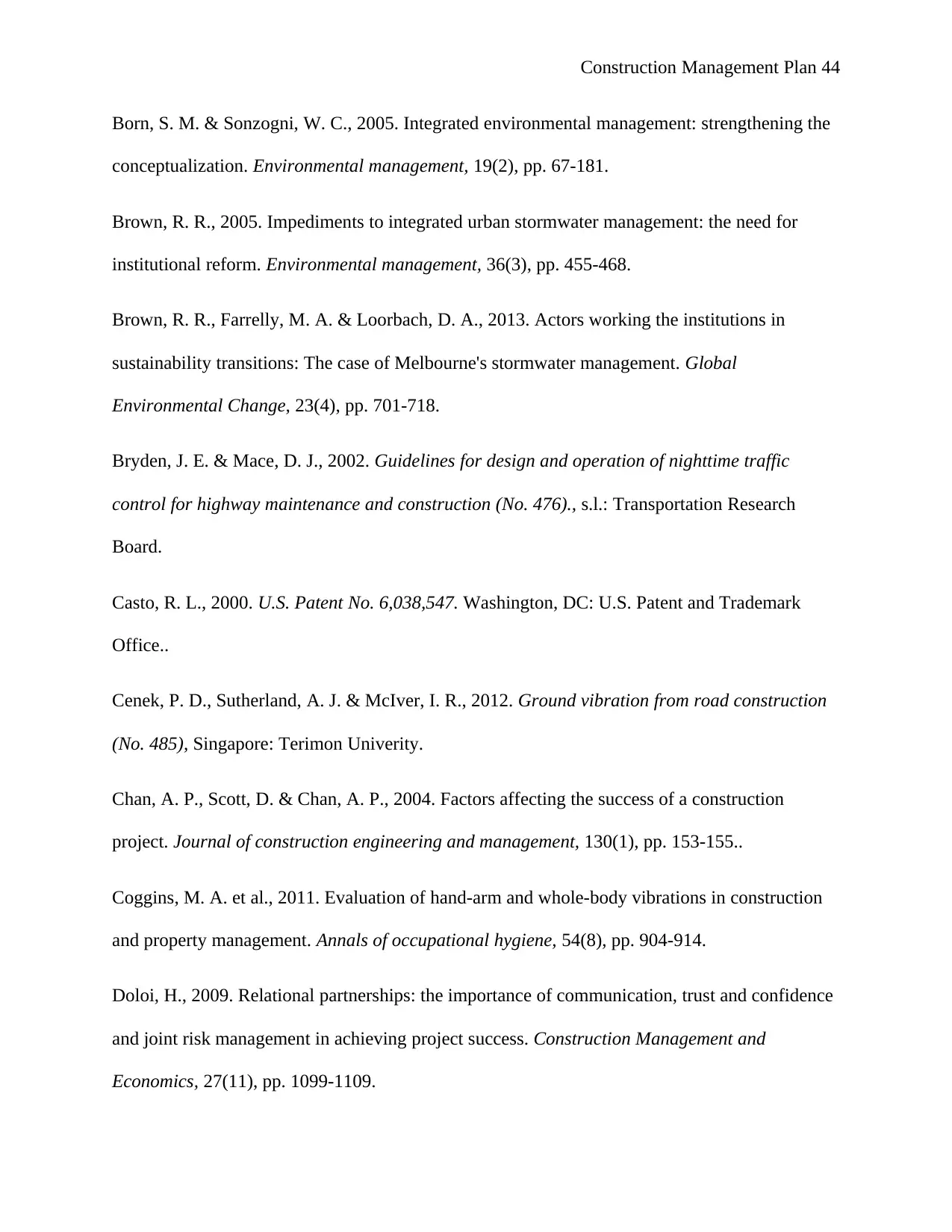
Construction Management Plan 44
Born, S. M. & Sonzogni, W. C., 2005. Integrated environmental management: strengthening the
conceptualization. Environmental management, 19(2), pp. 67-181.
Brown, R. R., 2005. Impediments to integrated urban stormwater management: the need for
institutional reform. Environmental management, 36(3), pp. 455-468.
Brown, R. R., Farrelly, M. A. & Loorbach, D. A., 2013. Actors working the institutions in
sustainability transitions: The case of Melbourne's stormwater management. Global
Environmental Change, 23(4), pp. 701-718.
Bryden, J. E. & Mace, D. J., 2002. Guidelines for design and operation of nighttime traffic
control for highway maintenance and construction (No. 476)., s.l.: Transportation Research
Board.
Casto, R. L., 2000. U.S. Patent No. 6,038,547. Washington, DC: U.S. Patent and Trademark
Office..
Cenek, P. D., Sutherland, A. J. & McIver, I. R., 2012. Ground vibration from road construction
(No. 485), Singapore: Terimon Univerity.
Chan, A. P., Scott, D. & Chan, A. P., 2004. Factors affecting the success of a construction
project. Journal of construction engineering and management, 130(1), pp. 153-155..
Coggins, M. A. et al., 2011. Evaluation of hand-arm and whole-body vibrations in construction
and property management. Annals of occupational hygiene, 54(8), pp. 904-914.
Doloi, H., 2009. Relational partnerships: the importance of communication, trust and confidence
and joint risk management in achieving project success. Construction Management and
Economics, 27(11), pp. 1099-1109.
Born, S. M. & Sonzogni, W. C., 2005. Integrated environmental management: strengthening the
conceptualization. Environmental management, 19(2), pp. 67-181.
Brown, R. R., 2005. Impediments to integrated urban stormwater management: the need for
institutional reform. Environmental management, 36(3), pp. 455-468.
Brown, R. R., Farrelly, M. A. & Loorbach, D. A., 2013. Actors working the institutions in
sustainability transitions: The case of Melbourne's stormwater management. Global
Environmental Change, 23(4), pp. 701-718.
Bryden, J. E. & Mace, D. J., 2002. Guidelines for design and operation of nighttime traffic
control for highway maintenance and construction (No. 476)., s.l.: Transportation Research
Board.
Casto, R. L., 2000. U.S. Patent No. 6,038,547. Washington, DC: U.S. Patent and Trademark
Office..
Cenek, P. D., Sutherland, A. J. & McIver, I. R., 2012. Ground vibration from road construction
(No. 485), Singapore: Terimon Univerity.
Chan, A. P., Scott, D. & Chan, A. P., 2004. Factors affecting the success of a construction
project. Journal of construction engineering and management, 130(1), pp. 153-155..
Coggins, M. A. et al., 2011. Evaluation of hand-arm and whole-body vibrations in construction
and property management. Annals of occupational hygiene, 54(8), pp. 904-914.
Doloi, H., 2009. Relational partnerships: the importance of communication, trust and confidence
and joint risk management in achieving project success. Construction Management and
Economics, 27(11), pp. 1099-1109.
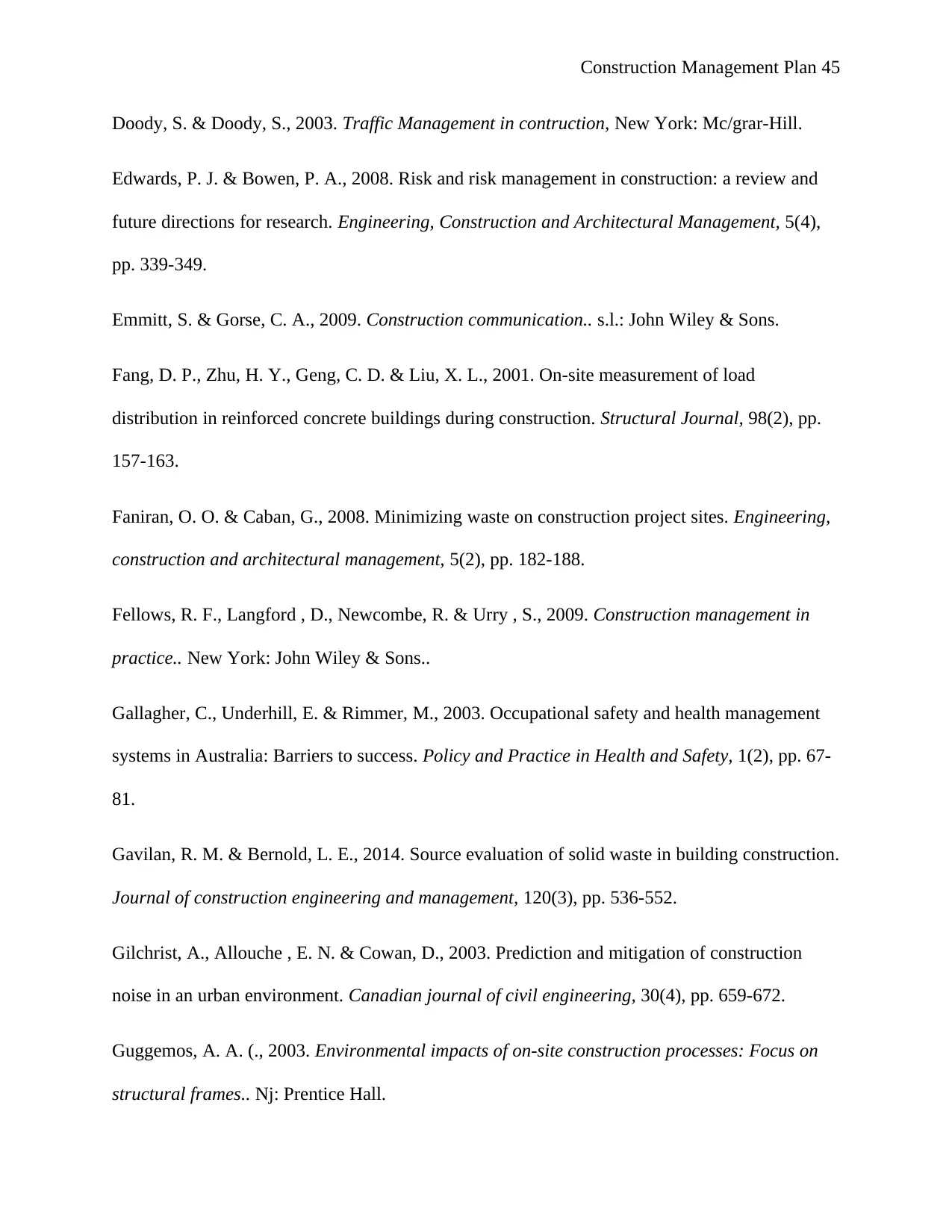
Construction Management Plan 45
Doody, S. & Doody, S., 2003. Traffic Management in contruction, New York: Mc/grar-Hill.
Edwards, P. J. & Bowen, P. A., 2008. Risk and risk management in construction: a review and
future directions for research. Engineering, Construction and Architectural Management, 5(4),
pp. 339-349.
Emmitt, S. & Gorse, C. A., 2009. Construction communication.. s.l.: John Wiley & Sons.
Fang, D. P., Zhu, H. Y., Geng, C. D. & Liu, X. L., 2001. On-site measurement of load
distribution in reinforced concrete buildings during construction. Structural Journal, 98(2), pp.
157-163.
Faniran, O. O. & Caban, G., 2008. Minimizing waste on construction project sites. Engineering,
construction and architectural management, 5(2), pp. 182-188.
Fellows, R. F., Langford , D., Newcombe, R. & Urry , S., 2009. Construction management in
practice.. New York: John Wiley & Sons..
Gallagher, C., Underhill, E. & Rimmer, M., 2003. Occupational safety and health management
systems in Australia: Barriers to success. Policy and Practice in Health and Safety, 1(2), pp. 67-
81.
Gavilan, R. M. & Bernold, L. E., 2014. Source evaluation of solid waste in building construction.
Journal of construction engineering and management, 120(3), pp. 536-552.
Gilchrist, A., Allouche , E. N. & Cowan, D., 2003. Prediction and mitigation of construction
noise in an urban environment. Canadian journal of civil engineering, 30(4), pp. 659-672.
Guggemos, A. A. (., 2003. Environmental impacts of on-site construction processes: Focus on
structural frames.. Nj: Prentice Hall.
Doody, S. & Doody, S., 2003. Traffic Management in contruction, New York: Mc/grar-Hill.
Edwards, P. J. & Bowen, P. A., 2008. Risk and risk management in construction: a review and
future directions for research. Engineering, Construction and Architectural Management, 5(4),
pp. 339-349.
Emmitt, S. & Gorse, C. A., 2009. Construction communication.. s.l.: John Wiley & Sons.
Fang, D. P., Zhu, H. Y., Geng, C. D. & Liu, X. L., 2001. On-site measurement of load
distribution in reinforced concrete buildings during construction. Structural Journal, 98(2), pp.
157-163.
Faniran, O. O. & Caban, G., 2008. Minimizing waste on construction project sites. Engineering,
construction and architectural management, 5(2), pp. 182-188.
Fellows, R. F., Langford , D., Newcombe, R. & Urry , S., 2009. Construction management in
practice.. New York: John Wiley & Sons..
Gallagher, C., Underhill, E. & Rimmer, M., 2003. Occupational safety and health management
systems in Australia: Barriers to success. Policy and Practice in Health and Safety, 1(2), pp. 67-
81.
Gavilan, R. M. & Bernold, L. E., 2014. Source evaluation of solid waste in building construction.
Journal of construction engineering and management, 120(3), pp. 536-552.
Gilchrist, A., Allouche , E. N. & Cowan, D., 2003. Prediction and mitigation of construction
noise in an urban environment. Canadian journal of civil engineering, 30(4), pp. 659-672.
Guggemos, A. A. (., 2003. Environmental impacts of on-site construction processes: Focus on
structural frames.. Nj: Prentice Hall.
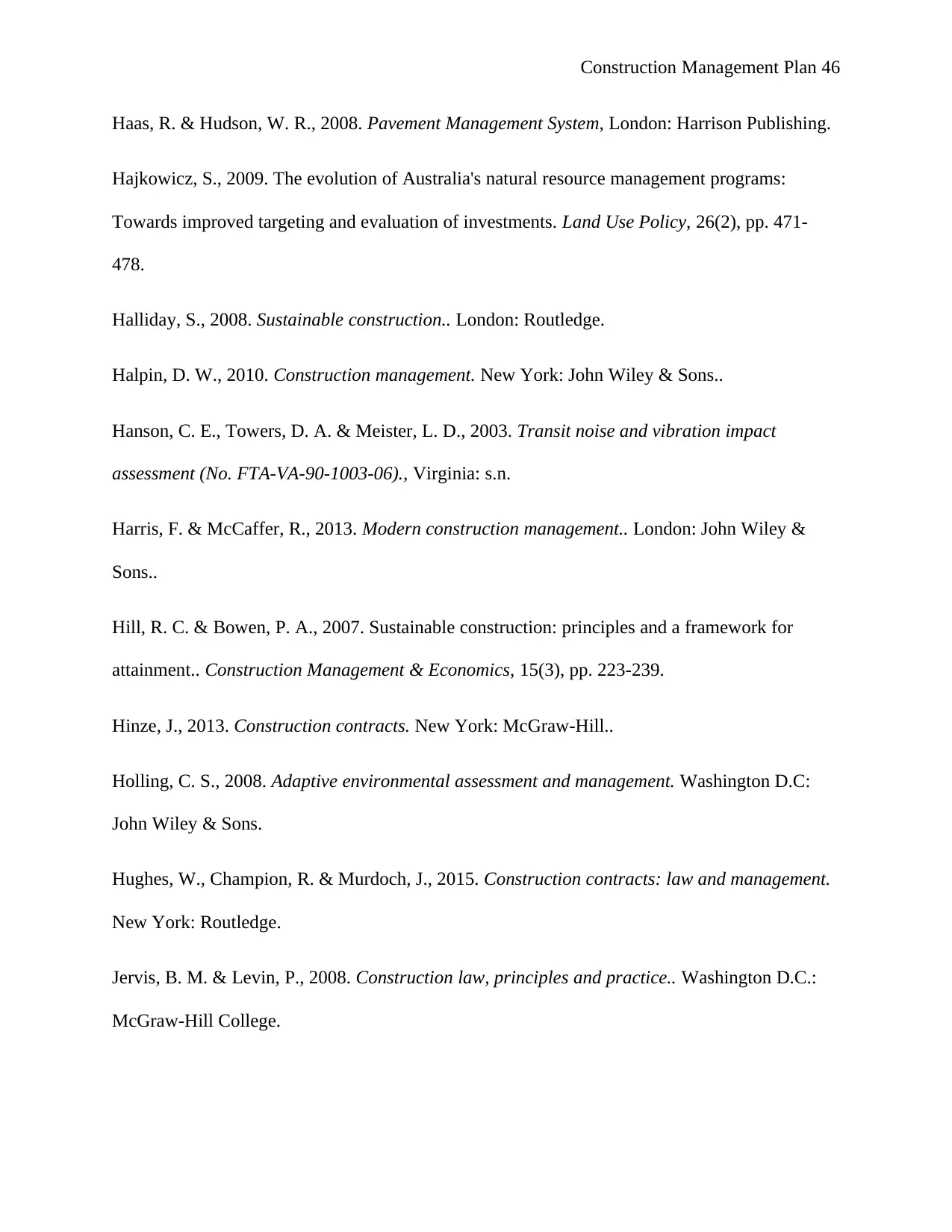
Construction Management Plan 46
Haas, R. & Hudson, W. R., 2008. Pavement Management System, London: Harrison Publishing.
Hajkowicz, S., 2009. The evolution of Australia's natural resource management programs:
Towards improved targeting and evaluation of investments. Land Use Policy, 26(2), pp. 471-
478.
Halliday, S., 2008. Sustainable construction.. London: Routledge.
Halpin, D. W., 2010. Construction management. New York: John Wiley & Sons..
Hanson, C. E., Towers, D. A. & Meister, L. D., 2003. Transit noise and vibration impact
assessment (No. FTA-VA-90-1003-06)., Virginia: s.n.
Harris, F. & McCaffer, R., 2013. Modern construction management.. London: John Wiley &
Sons..
Hill, R. C. & Bowen, P. A., 2007. Sustainable construction: principles and a framework for
attainment.. Construction Management & Economics, 15(3), pp. 223-239.
Hinze, J., 2013. Construction contracts. New York: McGraw-Hill..
Holling, C. S., 2008. Adaptive environmental assessment and management. Washington D.C:
John Wiley & Sons.
Hughes, W., Champion, R. & Murdoch, J., 2015. Construction contracts: law and management.
New York: Routledge.
Jervis, B. M. & Levin, P., 2008. Construction law, principles and practice.. Washington D.C.:
McGraw-Hill College.
Haas, R. & Hudson, W. R., 2008. Pavement Management System, London: Harrison Publishing.
Hajkowicz, S., 2009. The evolution of Australia's natural resource management programs:
Towards improved targeting and evaluation of investments. Land Use Policy, 26(2), pp. 471-
478.
Halliday, S., 2008. Sustainable construction.. London: Routledge.
Halpin, D. W., 2010. Construction management. New York: John Wiley & Sons..
Hanson, C. E., Towers, D. A. & Meister, L. D., 2003. Transit noise and vibration impact
assessment (No. FTA-VA-90-1003-06)., Virginia: s.n.
Harris, F. & McCaffer, R., 2013. Modern construction management.. London: John Wiley &
Sons..
Hill, R. C. & Bowen, P. A., 2007. Sustainable construction: principles and a framework for
attainment.. Construction Management & Economics, 15(3), pp. 223-239.
Hinze, J., 2013. Construction contracts. New York: McGraw-Hill..
Holling, C. S., 2008. Adaptive environmental assessment and management. Washington D.C:
John Wiley & Sons.
Hughes, W., Champion, R. & Murdoch, J., 2015. Construction contracts: law and management.
New York: Routledge.
Jervis, B. M. & Levin, P., 2008. Construction law, principles and practice.. Washington D.C.:
McGraw-Hill College.
Secure Best Marks with AI Grader
Need help grading? Try our AI Grader for instant feedback on your assignments.
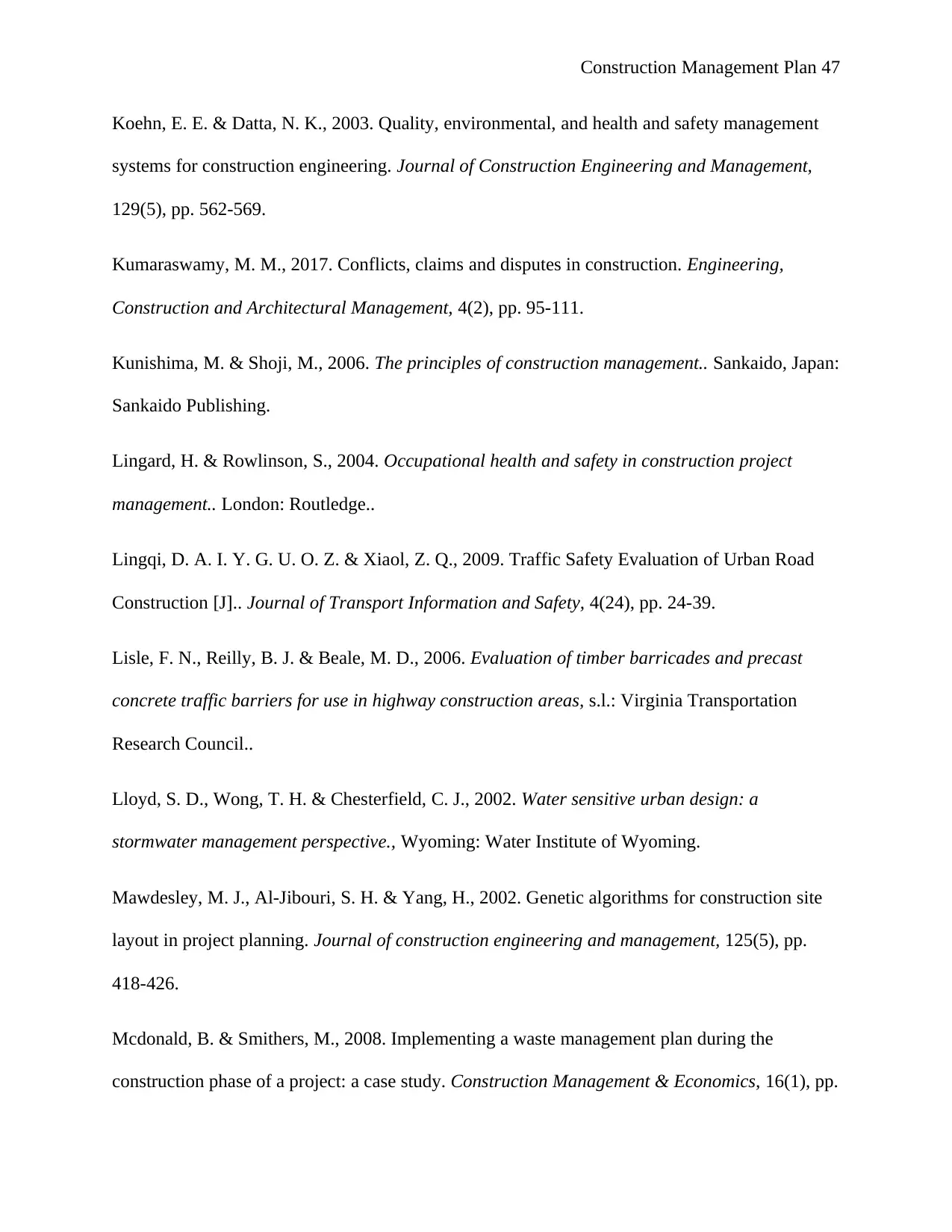
Construction Management Plan 47
Koehn, E. E. & Datta, N. K., 2003. Quality, environmental, and health and safety management
systems for construction engineering. Journal of Construction Engineering and Management,
129(5), pp. 562-569.
Kumaraswamy, M. M., 2017. Conflicts, claims and disputes in construction. Engineering,
Construction and Architectural Management, 4(2), pp. 95-111.
Kunishima, M. & Shoji, M., 2006. The principles of construction management.. Sankaido, Japan:
Sankaido Publishing.
Lingard, H. & Rowlinson, S., 2004. Occupational health and safety in construction project
management.. London: Routledge..
Lingqi, D. A. I. Y. G. U. O. Z. & Xiaol, Z. Q., 2009. Traffic Safety Evaluation of Urban Road
Construction [J].. Journal of Transport Information and Safety, 4(24), pp. 24-39.
Lisle, F. N., Reilly, B. J. & Beale, M. D., 2006. Evaluation of timber barricades and precast
concrete traffic barriers for use in highway construction areas, s.l.: Virginia Transportation
Research Council..
Lloyd, S. D., Wong, T. H. & Chesterfield, C. J., 2002. Water sensitive urban design: a
stormwater management perspective., Wyoming: Water Institute of Wyoming.
Mawdesley, M. J., Al-Jibouri, S. H. & Yang, H., 2002. Genetic algorithms for construction site
layout in project planning. Journal of construction engineering and management, 125(5), pp.
418-426.
Mcdonald, B. & Smithers, M., 2008. Implementing a waste management plan during the
construction phase of a project: a case study. Construction Management & Economics, 16(1), pp.
Koehn, E. E. & Datta, N. K., 2003. Quality, environmental, and health and safety management
systems for construction engineering. Journal of Construction Engineering and Management,
129(5), pp. 562-569.
Kumaraswamy, M. M., 2017. Conflicts, claims and disputes in construction. Engineering,
Construction and Architectural Management, 4(2), pp. 95-111.
Kunishima, M. & Shoji, M., 2006. The principles of construction management.. Sankaido, Japan:
Sankaido Publishing.
Lingard, H. & Rowlinson, S., 2004. Occupational health and safety in construction project
management.. London: Routledge..
Lingqi, D. A. I. Y. G. U. O. Z. & Xiaol, Z. Q., 2009. Traffic Safety Evaluation of Urban Road
Construction [J].. Journal of Transport Information and Safety, 4(24), pp. 24-39.
Lisle, F. N., Reilly, B. J. & Beale, M. D., 2006. Evaluation of timber barricades and precast
concrete traffic barriers for use in highway construction areas, s.l.: Virginia Transportation
Research Council..
Lloyd, S. D., Wong, T. H. & Chesterfield, C. J., 2002. Water sensitive urban design: a
stormwater management perspective., Wyoming: Water Institute of Wyoming.
Mawdesley, M. J., Al-Jibouri, S. H. & Yang, H., 2002. Genetic algorithms for construction site
layout in project planning. Journal of construction engineering and management, 125(5), pp.
418-426.
Mcdonald, B. & Smithers, M., 2008. Implementing a waste management plan during the
construction phase of a project: a case study. Construction Management & Economics, 16(1), pp.
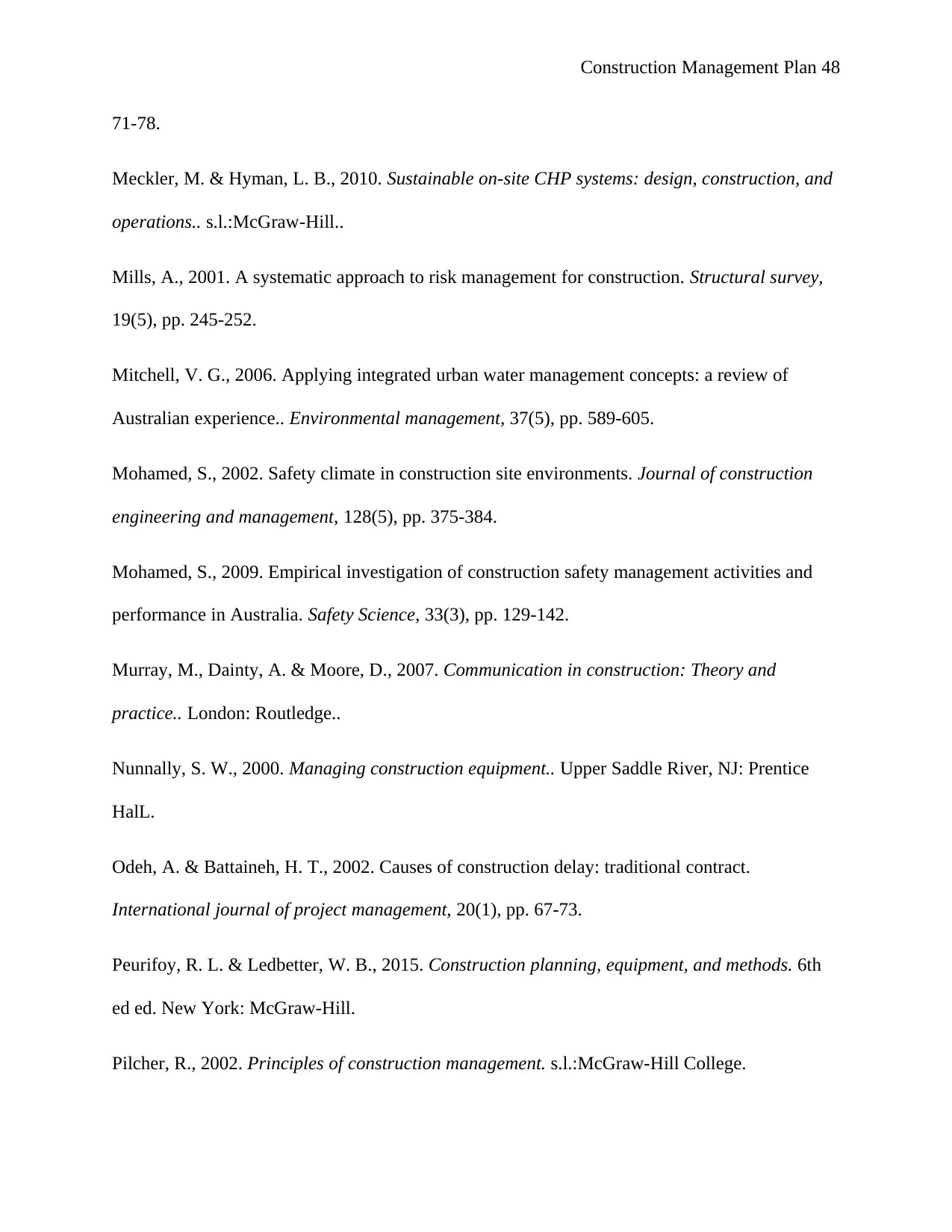
Construction Management Plan 48
71-78.
Meckler, M. & Hyman, L. B., 2010. Sustainable on-site CHP systems: design, construction, and
operations.. s.l.:McGraw-Hill..
Mills, A., 2001. A systematic approach to risk management for construction. Structural survey,
19(5), pp. 245-252.
Mitchell, V. G., 2006. Applying integrated urban water management concepts: a review of
Australian experience.. Environmental management, 37(5), pp. 589-605.
Mohamed, S., 2002. Safety climate in construction site environments. Journal of construction
engineering and management, 128(5), pp. 375-384.
Mohamed, S., 2009. Empirical investigation of construction safety management activities and
performance in Australia. Safety Science, 33(3), pp. 129-142.
Murray, M., Dainty, A. & Moore, D., 2007. Communication in construction: Theory and
practice.. London: Routledge..
Nunnally, S. W., 2000. Managing construction equipment.. Upper Saddle River, NJ: Prentice
HalL.
Odeh, A. & Battaineh, H. T., 2002. Causes of construction delay: traditional contract.
International journal of project management, 20(1), pp. 67-73.
Peurifoy, R. L. & Ledbetter, W. B., 2015. Construction planning, equipment, and methods. 6th
ed ed. New York: McGraw-Hill.
Pilcher, R., 2002. Principles of construction management. s.l.:McGraw-Hill College.
71-78.
Meckler, M. & Hyman, L. B., 2010. Sustainable on-site CHP systems: design, construction, and
operations.. s.l.:McGraw-Hill..
Mills, A., 2001. A systematic approach to risk management for construction. Structural survey,
19(5), pp. 245-252.
Mitchell, V. G., 2006. Applying integrated urban water management concepts: a review of
Australian experience.. Environmental management, 37(5), pp. 589-605.
Mohamed, S., 2002. Safety climate in construction site environments. Journal of construction
engineering and management, 128(5), pp. 375-384.
Mohamed, S., 2009. Empirical investigation of construction safety management activities and
performance in Australia. Safety Science, 33(3), pp. 129-142.
Murray, M., Dainty, A. & Moore, D., 2007. Communication in construction: Theory and
practice.. London: Routledge..
Nunnally, S. W., 2000. Managing construction equipment.. Upper Saddle River, NJ: Prentice
HalL.
Odeh, A. & Battaineh, H. T., 2002. Causes of construction delay: traditional contract.
International journal of project management, 20(1), pp. 67-73.
Peurifoy, R. L. & Ledbetter, W. B., 2015. Construction planning, equipment, and methods. 6th
ed ed. New York: McGraw-Hill.
Pilcher, R., 2002. Principles of construction management. s.l.:McGraw-Hill College.
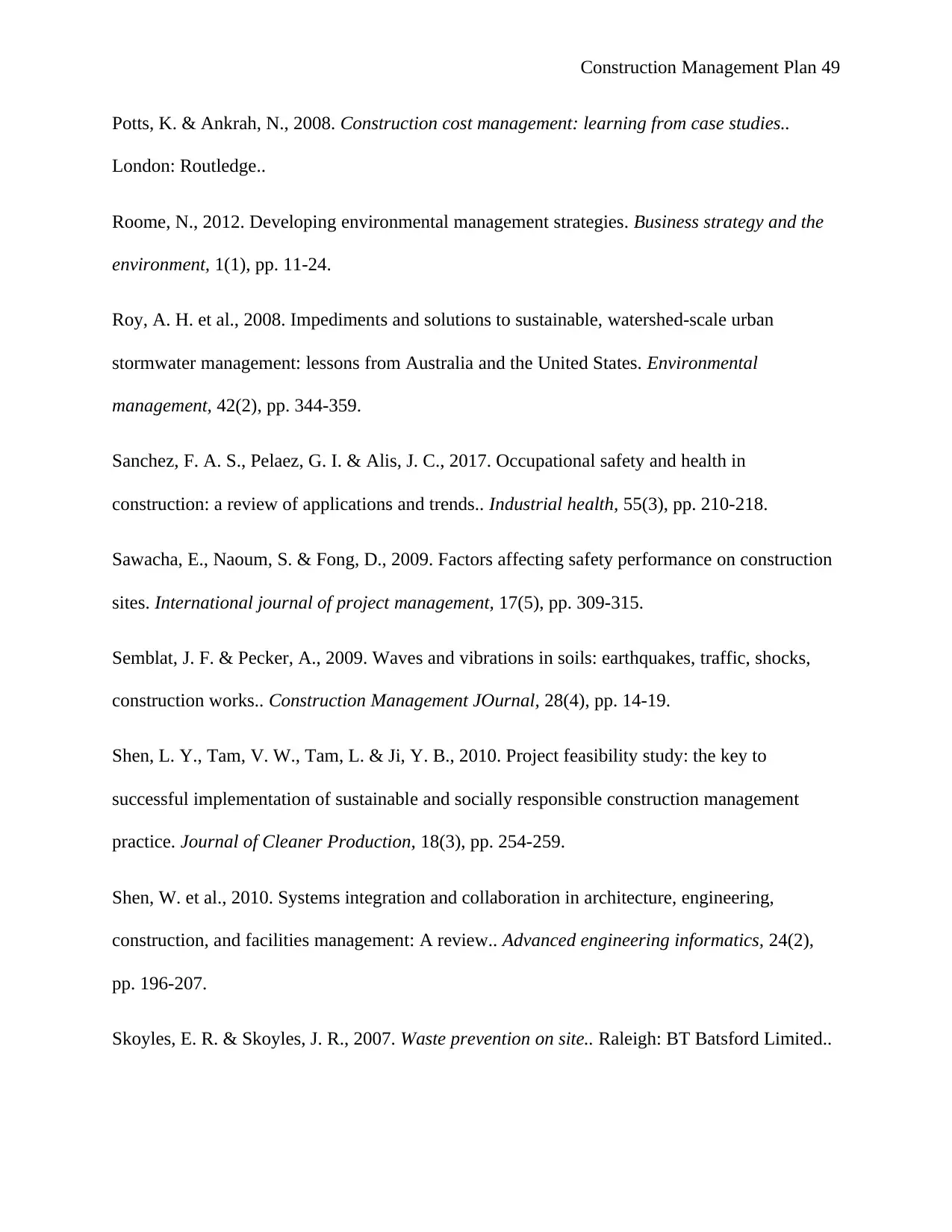
Construction Management Plan 49
Potts, K. & Ankrah, N., 2008. Construction cost management: learning from case studies..
London: Routledge..
Roome, N., 2012. Developing environmental management strategies. Business strategy and the
environment, 1(1), pp. 11-24.
Roy, A. H. et al., 2008. Impediments and solutions to sustainable, watershed-scale urban
stormwater management: lessons from Australia and the United States. Environmental
management, 42(2), pp. 344-359.
Sanchez, F. A. S., Pelaez, G. I. & Alis, J. C., 2017. Occupational safety and health in
construction: a review of applications and trends.. Industrial health, 55(3), pp. 210-218.
Sawacha, E., Naoum, S. & Fong, D., 2009. Factors affecting safety performance on construction
sites. International journal of project management, 17(5), pp. 309-315.
Semblat, J. F. & Pecker, A., 2009. Waves and vibrations in soils: earthquakes, traffic, shocks,
construction works.. Construction Management JOurnal, 28(4), pp. 14-19.
Shen, L. Y., Tam, V. W., Tam, L. & Ji, Y. B., 2010. Project feasibility study: the key to
successful implementation of sustainable and socially responsible construction management
practice. Journal of Cleaner Production, 18(3), pp. 254-259.
Shen, W. et al., 2010. Systems integration and collaboration in architecture, engineering,
construction, and facilities management: A review.. Advanced engineering informatics, 24(2),
pp. 196-207.
Skoyles, E. R. & Skoyles, J. R., 2007. Waste prevention on site.. Raleigh: BT Batsford Limited..
Potts, K. & Ankrah, N., 2008. Construction cost management: learning from case studies..
London: Routledge..
Roome, N., 2012. Developing environmental management strategies. Business strategy and the
environment, 1(1), pp. 11-24.
Roy, A. H. et al., 2008. Impediments and solutions to sustainable, watershed-scale urban
stormwater management: lessons from Australia and the United States. Environmental
management, 42(2), pp. 344-359.
Sanchez, F. A. S., Pelaez, G. I. & Alis, J. C., 2017. Occupational safety and health in
construction: a review of applications and trends.. Industrial health, 55(3), pp. 210-218.
Sawacha, E., Naoum, S. & Fong, D., 2009. Factors affecting safety performance on construction
sites. International journal of project management, 17(5), pp. 309-315.
Semblat, J. F. & Pecker, A., 2009. Waves and vibrations in soils: earthquakes, traffic, shocks,
construction works.. Construction Management JOurnal, 28(4), pp. 14-19.
Shen, L. Y., Tam, V. W., Tam, L. & Ji, Y. B., 2010. Project feasibility study: the key to
successful implementation of sustainable and socially responsible construction management
practice. Journal of Cleaner Production, 18(3), pp. 254-259.
Shen, W. et al., 2010. Systems integration and collaboration in architecture, engineering,
construction, and facilities management: A review.. Advanced engineering informatics, 24(2),
pp. 196-207.
Skoyles, E. R. & Skoyles, J. R., 2007. Waste prevention on site.. Raleigh: BT Batsford Limited..
Paraphrase This Document
Need a fresh take? Get an instant paraphrase of this document with our AI Paraphraser
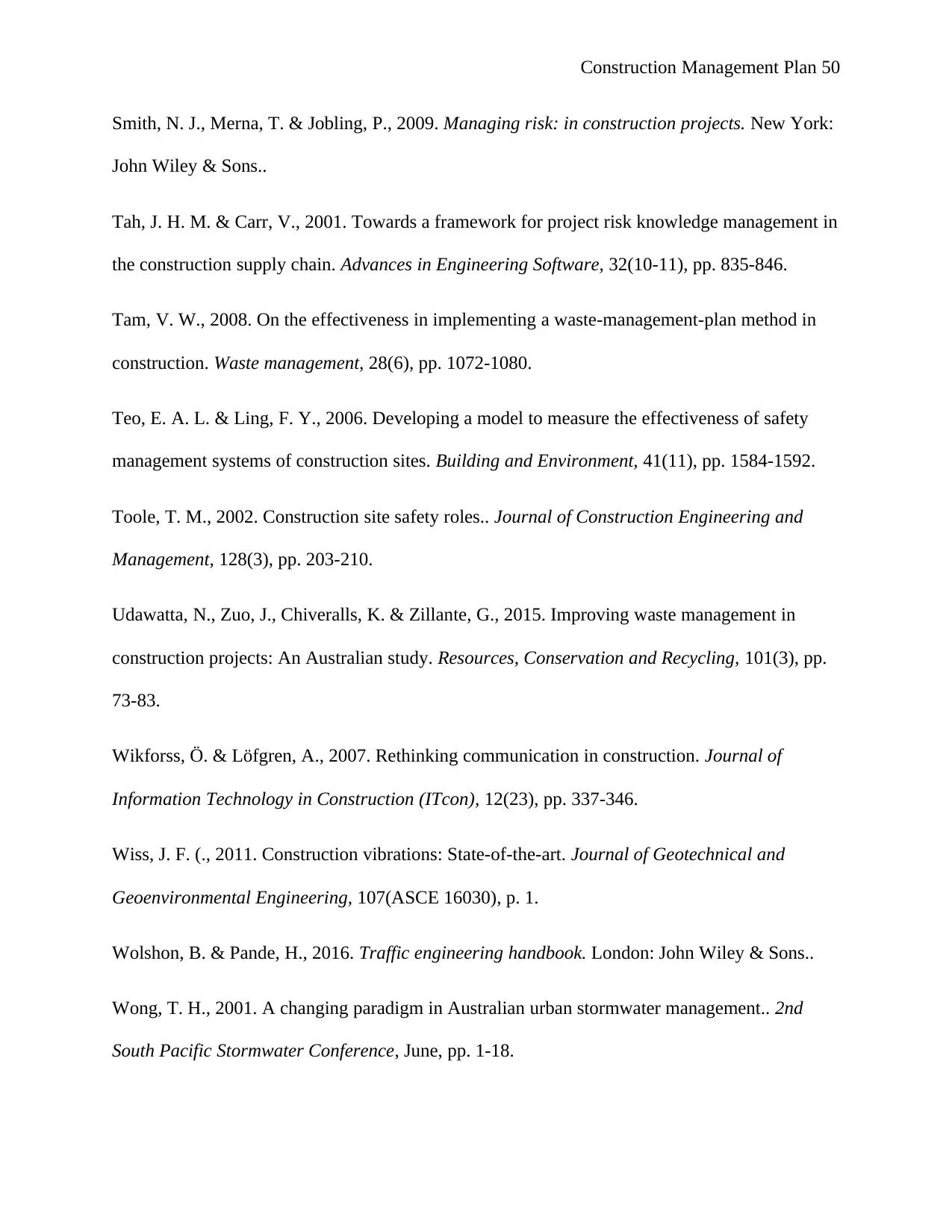
Construction Management Plan 50
Smith, N. J., Merna, T. & Jobling, P., 2009. Managing risk: in construction projects. New York:
John Wiley & Sons..
Tah, J. H. M. & Carr, V., 2001. Towards a framework for project risk knowledge management in
the construction supply chain. Advances in Engineering Software, 32(10-11), pp. 835-846.
Tam, V. W., 2008. On the effectiveness in implementing a waste-management-plan method in
construction. Waste management, 28(6), pp. 1072-1080.
Teo, E. A. L. & Ling, F. Y., 2006. Developing a model to measure the effectiveness of safety
management systems of construction sites. Building and Environment, 41(11), pp. 1584-1592.
Toole, T. M., 2002. Construction site safety roles.. Journal of Construction Engineering and
Management, 128(3), pp. 203-210.
Udawatta, N., Zuo, J., Chiveralls, K. & Zillante, G., 2015. Improving waste management in
construction projects: An Australian study. Resources, Conservation and Recycling, 101(3), pp.
73-83.
Wikforss, Ö. & Löfgren, A., 2007. Rethinking communication in construction. Journal of
Information Technology in Construction (ITcon), 12(23), pp. 337-346.
Wiss, J. F. (., 2011. Construction vibrations: State-of-the-art. Journal of Geotechnical and
Geoenvironmental Engineering, 107(ASCE 16030), p. 1.
Wolshon, B. & Pande, H., 2016. Traffic engineering handbook. London: John Wiley & Sons..
Wong, T. H., 2001. A changing paradigm in Australian urban stormwater management.. 2nd
South Pacific Stormwater Conference, June, pp. 1-18.
Smith, N. J., Merna, T. & Jobling, P., 2009. Managing risk: in construction projects. New York:
John Wiley & Sons..
Tah, J. H. M. & Carr, V., 2001. Towards a framework for project risk knowledge management in
the construction supply chain. Advances in Engineering Software, 32(10-11), pp. 835-846.
Tam, V. W., 2008. On the effectiveness in implementing a waste-management-plan method in
construction. Waste management, 28(6), pp. 1072-1080.
Teo, E. A. L. & Ling, F. Y., 2006. Developing a model to measure the effectiveness of safety
management systems of construction sites. Building and Environment, 41(11), pp. 1584-1592.
Toole, T. M., 2002. Construction site safety roles.. Journal of Construction Engineering and
Management, 128(3), pp. 203-210.
Udawatta, N., Zuo, J., Chiveralls, K. & Zillante, G., 2015. Improving waste management in
construction projects: An Australian study. Resources, Conservation and Recycling, 101(3), pp.
73-83.
Wikforss, Ö. & Löfgren, A., 2007. Rethinking communication in construction. Journal of
Information Technology in Construction (ITcon), 12(23), pp. 337-346.
Wiss, J. F. (., 2011. Construction vibrations: State-of-the-art. Journal of Geotechnical and
Geoenvironmental Engineering, 107(ASCE 16030), p. 1.
Wolshon, B. & Pande, H., 2016. Traffic engineering handbook. London: John Wiley & Sons..
Wong, T. H., 2001. A changing paradigm in Australian urban stormwater management.. 2nd
South Pacific Stormwater Conference, June, pp. 1-18.
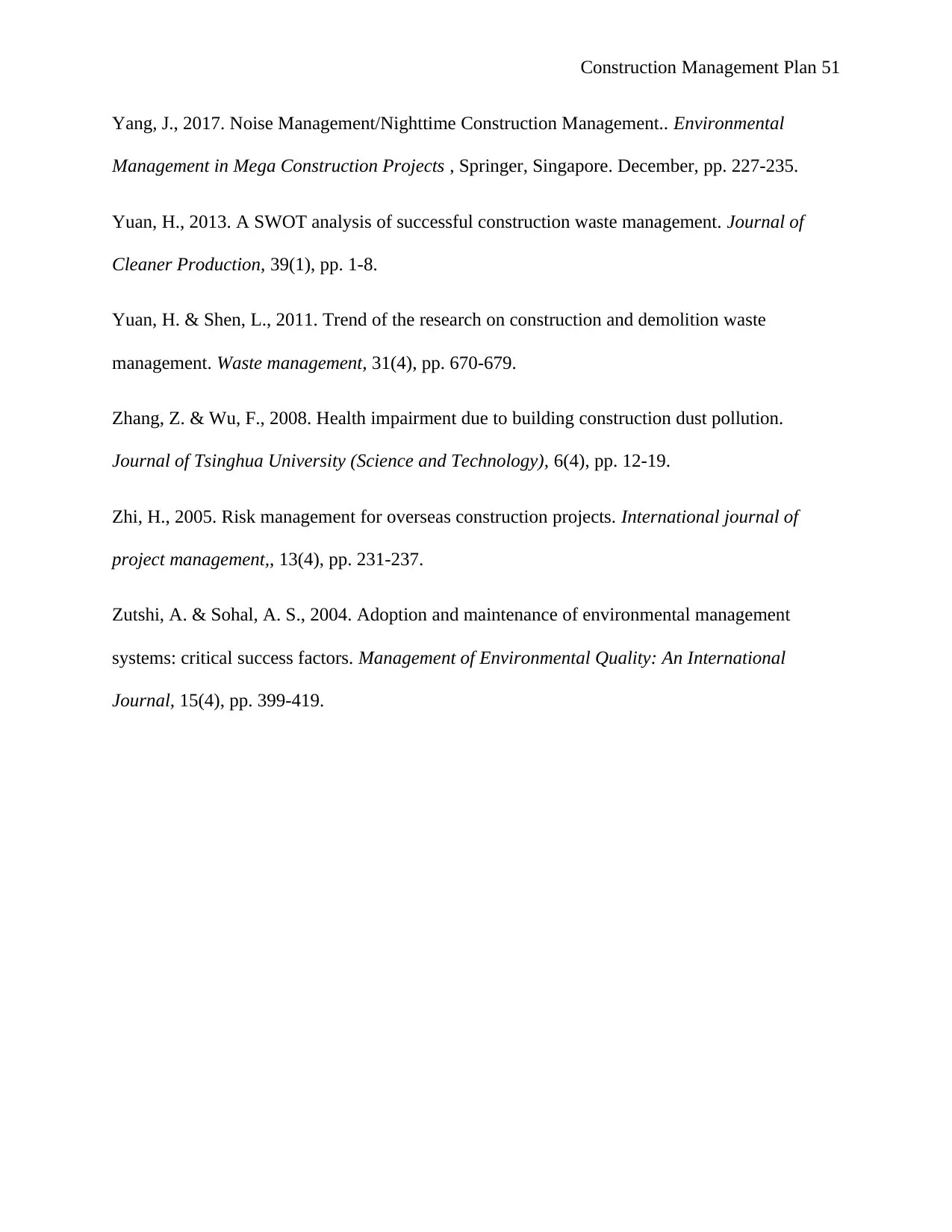
Construction Management Plan 51
Yang, J., 2017. Noise Management/Nighttime Construction Management.. Environmental
Management in Mega Construction Projects , Springer, Singapore. December, pp. 227-235.
Yuan, H., 2013. A SWOT analysis of successful construction waste management. Journal of
Cleaner Production, 39(1), pp. 1-8.
Yuan, H. & Shen, L., 2011. Trend of the research on construction and demolition waste
management. Waste management, 31(4), pp. 670-679.
Zhang, Z. & Wu, F., 2008. Health impairment due to building construction dust pollution.
Journal of Tsinghua University (Science and Technology), 6(4), pp. 12-19.
Zhi, H., 2005. Risk management for overseas construction projects. International journal of
project management,, 13(4), pp. 231-237.
Zutshi, A. & Sohal, A. S., 2004. Adoption and maintenance of environmental management
systems: critical success factors. Management of Environmental Quality: An International
Journal, 15(4), pp. 399-419.
Yang, J., 2017. Noise Management/Nighttime Construction Management.. Environmental
Management in Mega Construction Projects , Springer, Singapore. December, pp. 227-235.
Yuan, H., 2013. A SWOT analysis of successful construction waste management. Journal of
Cleaner Production, 39(1), pp. 1-8.
Yuan, H. & Shen, L., 2011. Trend of the research on construction and demolition waste
management. Waste management, 31(4), pp. 670-679.
Zhang, Z. & Wu, F., 2008. Health impairment due to building construction dust pollution.
Journal of Tsinghua University (Science and Technology), 6(4), pp. 12-19.
Zhi, H., 2005. Risk management for overseas construction projects. International journal of
project management,, 13(4), pp. 231-237.
Zutshi, A. & Sohal, A. S., 2004. Adoption and maintenance of environmental management
systems: critical success factors. Management of Environmental Quality: An International
Journal, 15(4), pp. 399-419.
1 out of 51
Related Documents
Your All-in-One AI-Powered Toolkit for Academic Success.
+13062052269
info@desklib.com
Available 24*7 on WhatsApp / Email
![[object Object]](/_next/static/media/star-bottom.7253800d.svg)
Unlock your academic potential
© 2024 | Zucol Services PVT LTD | All rights reserved.





